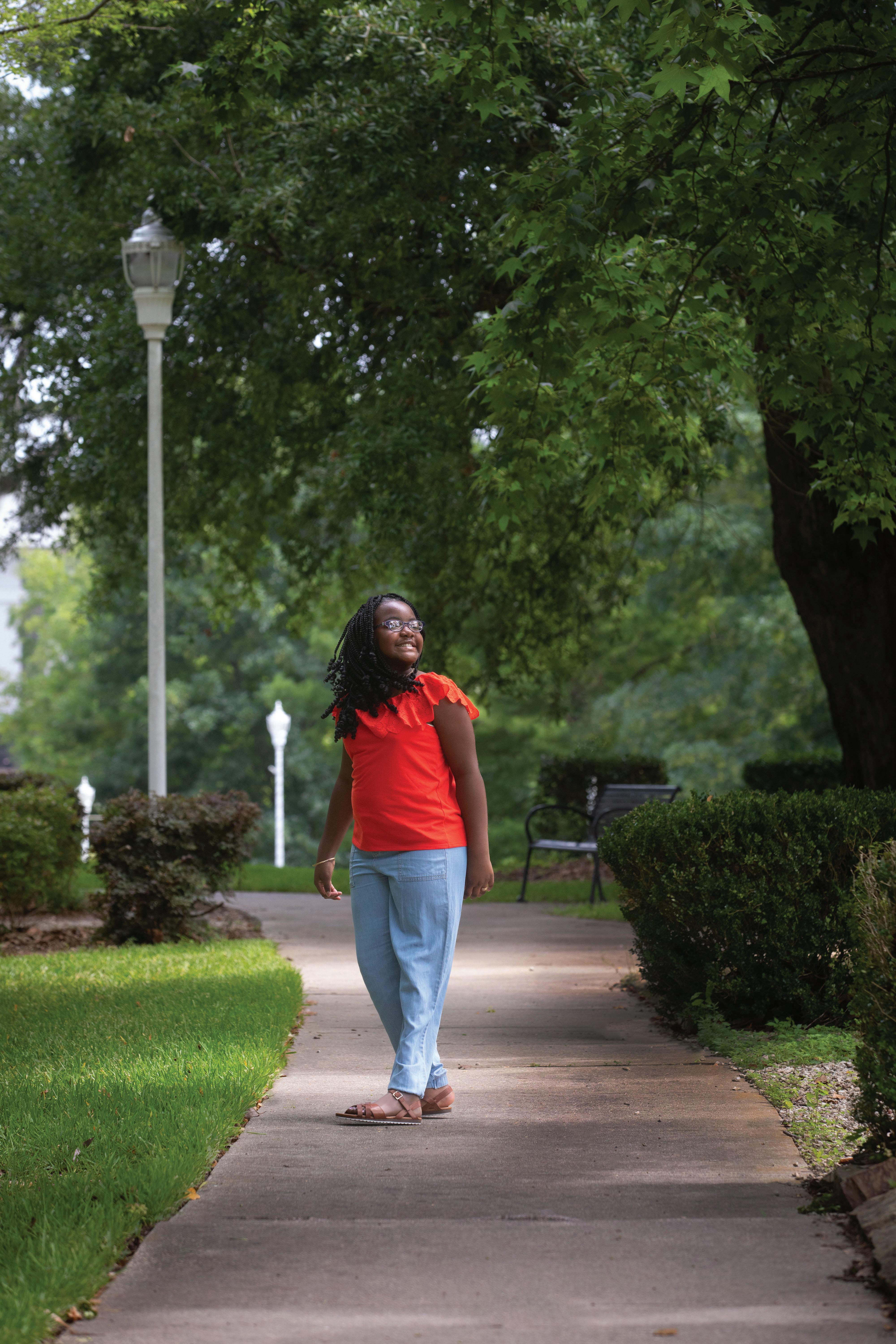
On the cover: Carmen Hunter, 11, explores the Children’s & Women’s Hospital campus one morning in June. Two years ago, she was diagnosed with osteosarcoma, a rare form of bone cancer, and had one of her legs amputated. She learned to walk and play again using a prosthetic leg.

2 | USA HEALTH MAGAZINE | VOL. 4, ISSUE2 Vol. 4, Issue 2
Petty Officer 1st Class Daniel Childs is grateful to return to his job as a precision marksman instructor in the U.S. Coast Guard. On April 1, he underwent artificial disc replacement surgery at the USA Health Spine Institute.
Carmen’s Courage
Carmen Hunter beat bone cancer and lives life fully with a prosthetic leg.

Legacy families come full circle 28 Alumni and current students share their family legacy stories.
Gift provides advanced breast cancer screening
Breast cancer survivor Beth Rabren donates funds for whole breast imaging.
Coast Guard member now living pain free after treatment at USA Health Spine Institute
Daniel Childs receives artificial disc placement and is fit for full duty.
Top: Members of the Class of 2024 prepare to don their white coats, marking the transition into their clinical training.
Senior medical students celebrate their residency matches at Match Day.
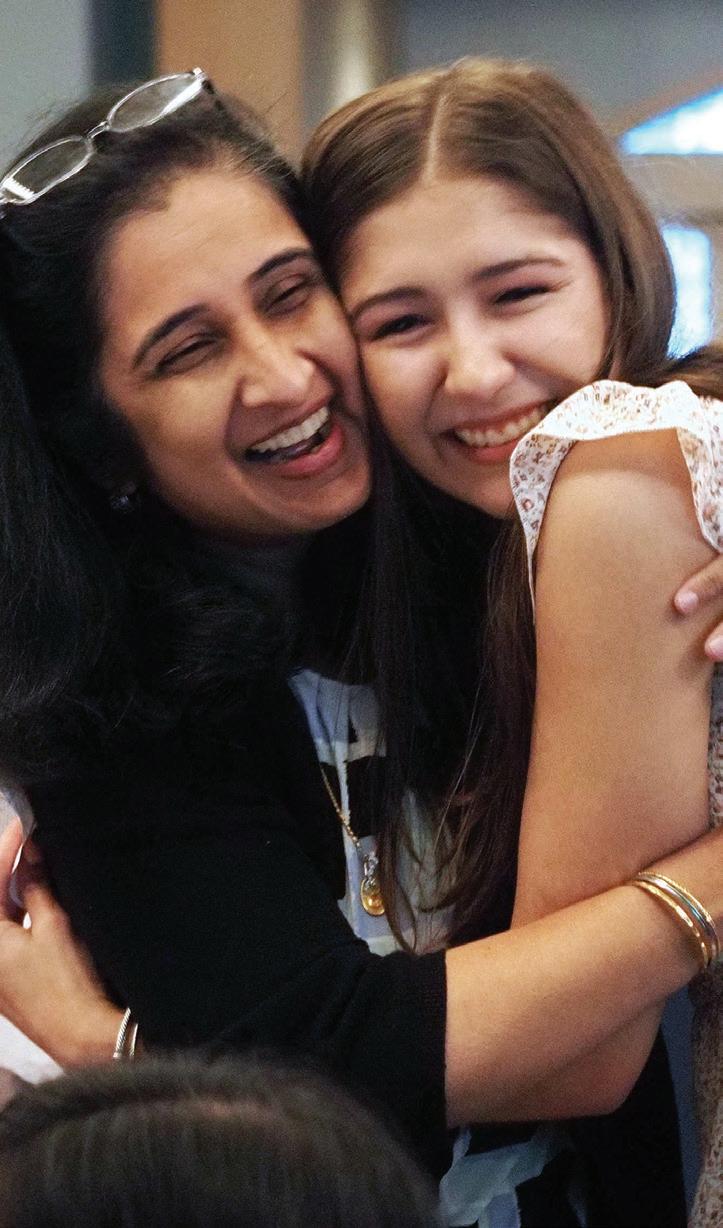
Beth Rabren, cancer survivor and donor, works out with Fit 360 personal training in Fairhope.
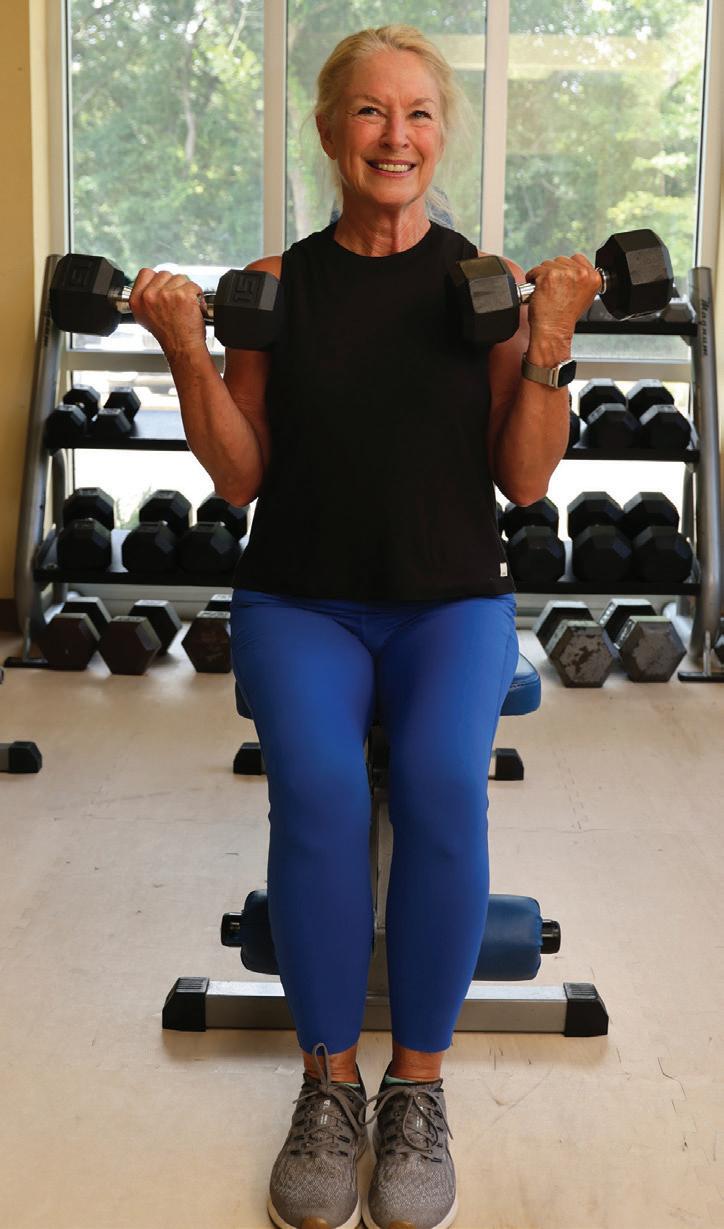
Dr. John and the Burning Sensations perform at the inaugural Doc Rock, a fundraising event for USA Health.
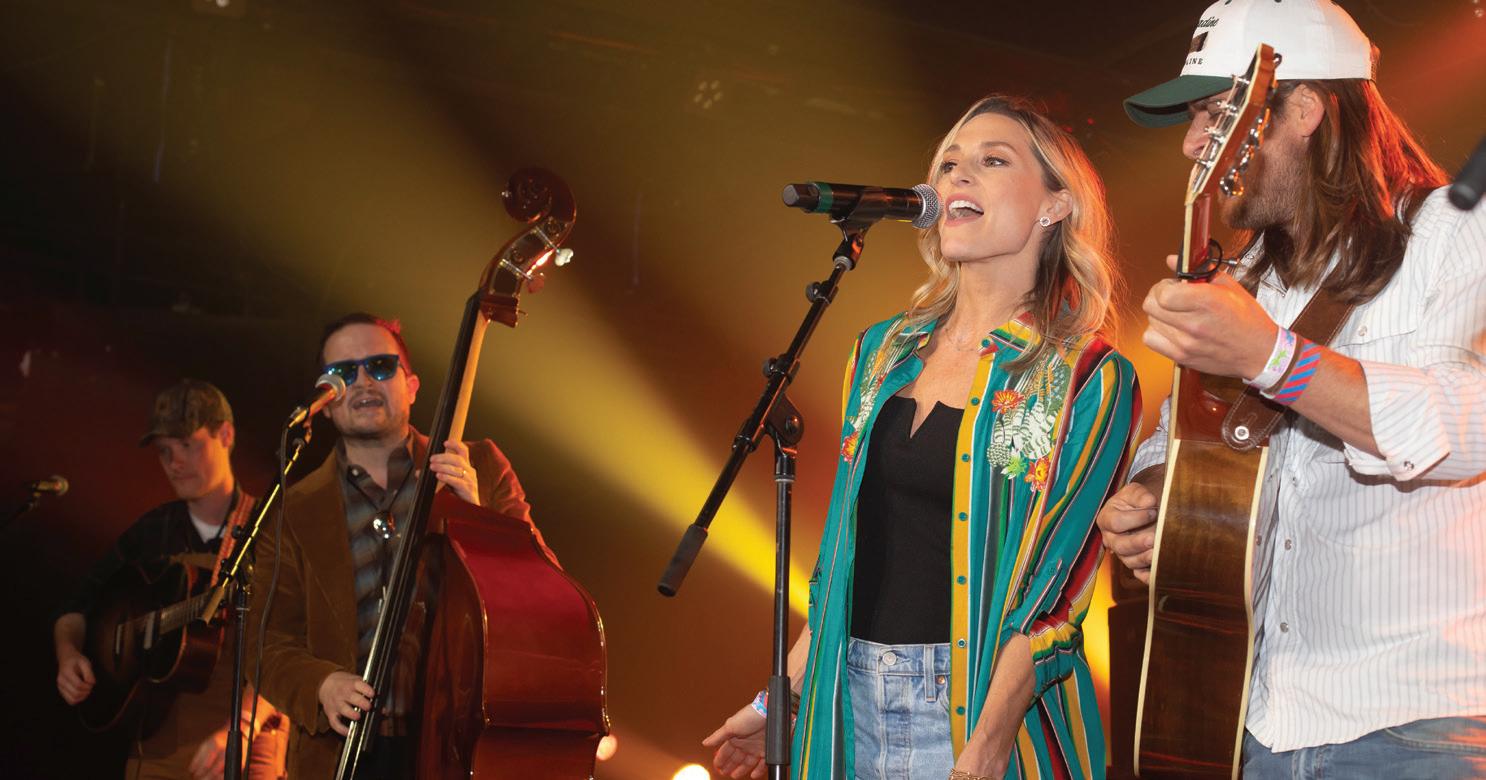
USA HEALTH MAGAZINE | VOL. 4, ISSUE 2 | 3 WELCOME 4 NEWS USA Health............................................ 5 College of Medicine 8 Research 11 By the Numbers 15 Watch Us Grow ................................... 16 Prevention 22 FEATURES
............................ 24
32
34
Outreach ............................................ 36 Events 38 Faces/Achievements 43 Table of Contents 327 40 38
DearFriends:
We hope this issue of USA Health Magazine finds you healthy and well. In this edition, you will meet 11-year-old Carmen Hunter and learn of her extraordinary journey from falling at school to beating a rare childhood cancer to being highlighted by the Children’s Miracle Network. You will see the generational impact of the Frederick P. Whiddon College of Medicine via legacy families, as well as see where this year’s graduating class will be furthering their training. You will read about how the advanced care and techniques available through USA Health have relieved severe pain ex perienced by a member of the Coast Guard and gotten him back to his career. And finally, you will understand the extraordinary care delivered to our patients at the Mitchell Cancer Institute and the appreciation our patients have for that care. You will see how every day, as the only academic health system in the upper Gulf Coast region, USA Health continues its mission to help people lead longer, better lives. We strive to transform medicine through educating and training the next generation of healthcare providers, conducting pioneering research that will generate new treatments and preventions, and providing innovative clinical care to all who come to us.
We hope you enjoy the magazine.
Owen Bailey, M.S.H.A., FACHE Chief Executive Officer & Senior Associate Vice President for Medical Affairs
John V. Marymont, M.D., M.B.A. Vice President for Medical Affairs Dean, Frederick P. Whiddon College of Medicine at the University of South Alabama
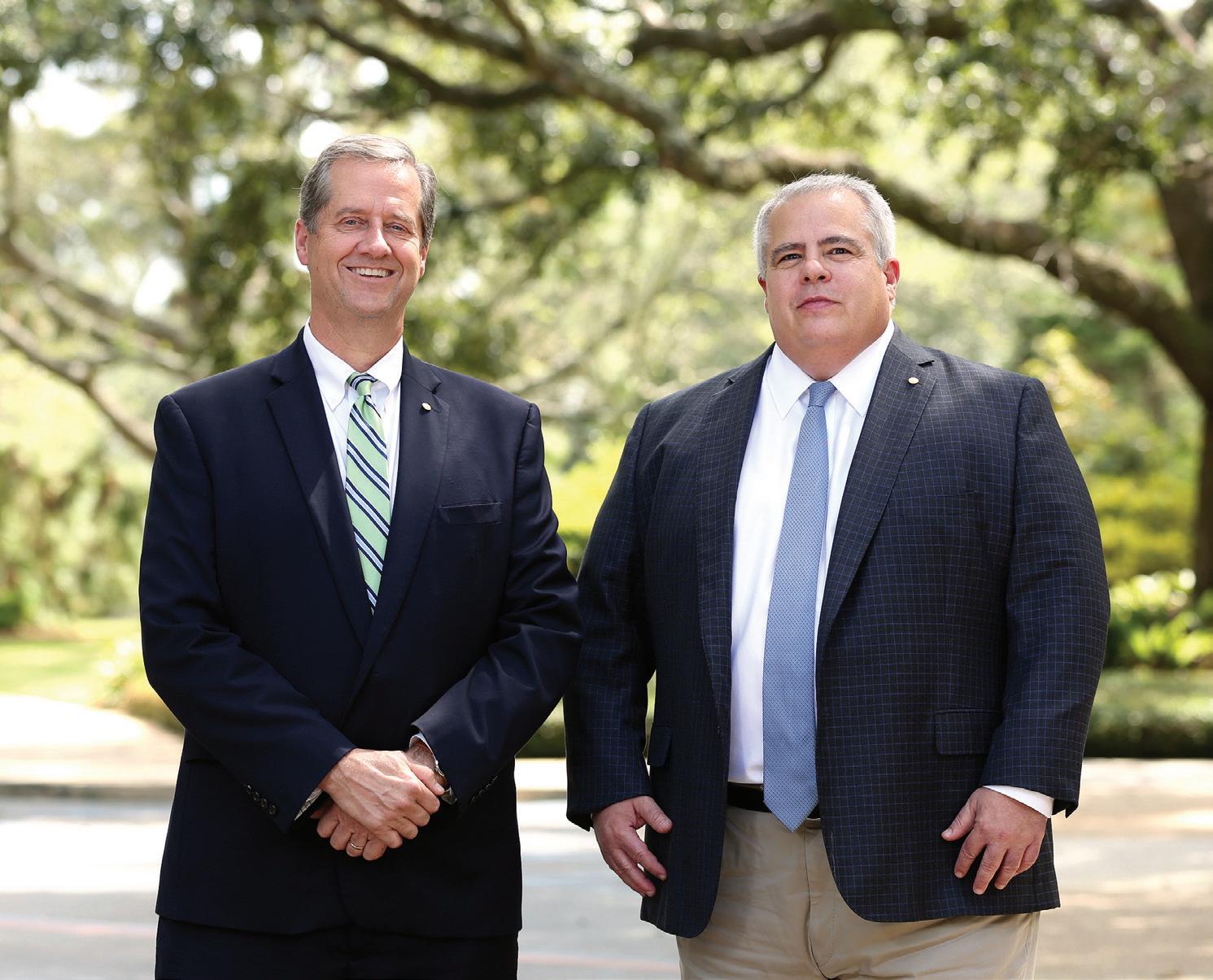
VOLUME 4, ISSUE 2 2022


USA HEALTH MAGAZINE 251 Cox Street, Suite 1015 Mobile, AL 36604 www.usahealthsystem.com
EXECUTIVE EDITORS
John V. Marymont, M.D., M.B.A. Owen Bailey, M.S.H.A., FACHE

MANAGING EDITOR Lindsay Lyle
ASSOCIATE VICE PRESIDENT OF MARKETING & COMMUNICATIONS
Gary Mans
DIRECTOR OF CREATIVE SERVICES
Marie Katz
CONTRIBUTING WRITERS
Casandra Andrews, Shelbey Ernest, Lindsay Lyle, Gary Mans, Carol McPhail, Brittany Otis, Nichelle Smith-Rodgers

PHOTOGRAPHY
4 | USA HEALTH MAGAZINE | VOL. 4, ISSUE2 WELCOME
Bill Starling, Mike Kittrell, Seth Laubinger
USA Health joins international effort to promote nutrition, healthy living
USA Health has been admitted into a global network of 45 teaching kitchens through a competitive selection process.
The Teaching Kitchen Collaborative (TKC) is an invitational network of thoughtleading organizations using teaching kitchen facilities and concepts as catalysts for enhanced personal and public health across medical, corporate, school and community settings.
“To be invited to join the Teaching Kitch en Collaborative is an honor and carries a significant responsibility,” said Robert Israel, M.D., one of the founders of the USA Health culinary medicine program. “We want to help people learn daily skills that positively impact their overall lives, in this case through learning cooking skills and good nutrition.
“The Gulf Coast is an area with a world of flavor but also a huge number of people affected by poor eating habits, including too much added sugar, too many processed foods and, unfortunately, foods that are devoid of nutritional value,” Israel added. “Changing that has been shown to improve people’s health and reduce disease.”
Founded in 2016 by David Eisenberg, M.D., the TKC connects innovators, including newly admitted USA Health, in partnership with the Culinary Institute of Medicine and the Harvard T.H. Chan School of Public Health.
USA Health earned acceptance into the TKC through its ongoing commitment to battle chronic disease; promote health, well-being and mindfulness; and provide educational programs to medical and nursing students at the University of South
BRIEFS
MCI wins grants for patient transportation, lodging
The Mitchell Cancer Institute was awarded grants totaling $35,000 from the American Cancer Society to help patients with transportation and lodging needs during their treatment.
Cancer patients undergoing treatment frequently require
Alabama. For the past seven years, Israel also has taught hands-on classes at Bishop State Community College through the Mitchell Cancer Institute’s Cancer Control and Prevention Program.
In addition to culinary medicine classes, USA Health has a demonstration kitchen in its University Commons facility, with a teaching kitchen planned for the Mapp Family Campus currently under construc tion in Fairhope.

Members of the collaborative share best practices with each other to help patients learn how to make modifications in their eating habits to either prevent or allevi
ate diabetes, hypertension, heart disease, cancer and more, and are encouraged to participate in collaborative research efforts to advance healthy lifestyles.
“Ultimately, our goal is to educate healthcare providers and patients, through evidence-based methods, on how to imple ment a healthier diet and its positive health implications,” Israel said. “For too long, ‘diet’ has had a negative connotation. We are looking at it from a holistic perspective and want to help people have a positive relationship with the foods they consume. All of this is designed to help people lead longer, better lives.”
assistance getting to and from facilities, often creating a financial and logistical burden.
The grants, awarded at a local level to health systems, treat ment centers and community organizations, are intended to address these access-to-care needs for cancer patients and ultimately help save lives.
University Hospital recognized for high-quality stroke care University Hospital has once again earned three of the American Heart Association/ American Stroke Association awards designed to recog nize excellence in stroke care. The American Heart Associ ation’s GoldPlus Get With The
Guidelines – Stroke quality achievement award recog nizes University Hospital for its commitment to ensuring stroke patients receive the most appropriate treatment accord ing to nationally recognized, research-based guidelines, ultimately leading to more lives saved and reduced disability.
USA HEALTH MAGAZINE | VOL. 4, ISSUE 2 | 5
NEWS
Robert Israel, M.D., right, an internal medicine physician and one of the founders of USA Health’s culinary medicine program, gives a demonstration in the kitchen at USA Mobile Diagnostic Center – University Commons.
NEWS
University Hospital approved for additional operating rooms
USA Health received unanimous ap proval from the Alabama Certificate of Need Review Board to construct four new traditional operating rooms, a hybrid oper ating room and a post-anesthesia care unit (PACU) at University Hospital.

“The Mobile region continues to grow, and so does the demand for our services,” said Shannon Scaturro, administrator of University Hospital. “We are very grateful to the members of the review board for their thorough understanding of the need for these operating rooms and the tre mendous impact they will have in helping meet the healthcare needs of the people in Mobile and beyond.”
The project, expected to take about a
year, will be constructed in space that for merly housed the trauma center. The space became available with the opening of the Fanny Meisler Trauma Center in 2021.
Not only will the project expand the number of operating rooms, but also will allow for larger rooms to better accommo date state-of-the-art equipment such as surgical robotic technology and systems that support extremely complex surgical care. Further, it will create necessary sup port areas, including a 12-bed PACU and surgical storage areas.
The hybrid operating room is an ad vanced procedural space that combines a traditional operating room with an image-guided interventional suite. This
room will increase the capability to per form cardiothoracic surgery, minimally invasive cardiology procedures, vascular surgery, interventional radiology procedures and neurosurgical cranial procedures.
“This project will provide up-to-date surgical space that can accommodate not only typical surgical staff, but also our residents and fellows, thus advancing the education purpose of University Hospital as an academic medical center,” said Owen Bailey, M.S.H.A., chief executive officer of USA Health.
The construction costs of the project are estimated at $9.5 million. The new equip ment is expected to cost $9.77 million.
University Urology first in state to perform procedure for enlarged prostate
In March 2022, Austin Younger, M.D., a urologist at USA Health University Urol ogy, was the first in the state to use the iTind procedure to treat the symptoms of enlarged prostate.
The new, minimally invasive procedure reshapes an enlarged prostate as an alter native to surgery, drugs and permanent implants. “I’m excited to be able to offer this new office-based procedure to treat men who are suffering from common symptoms of an enlarged prostate and want a solution that has been shown not to compromise sexual function,” Younger said.
NEWS BRIEFS
The hospital also received the AHA’s Target: Stroke Elite Plus award and the Target: Type 2 Honor Roll award.
Cancer researchers receive BCRFA funding
Three cancer researchers at the Mitchell Cancer Institute received grants from the Breast
Benign prostatic hyperplasia (BPH), also known as an enlarged prostate, is one of the most common diseases in aging men and the most common cause of lower urinary tract symptoms. The iTind procedure re shapes the anatomy of the prostatic urethra, gently creating a wider opening for urine to flow freely, without burning or cutting out tissue and without leaving behind a perma nent implant.
The treatment typically does not require overnight hospitalization, notes Younger, and lacks the side effects associated with prescription medications that treat BPH.
Cancer Research Foundation of Alabama. The recipients of the three awards, totaling almost $110,000, include Robert W. Sobol, Ph.D., professor of phar macology; Lyudmila Rachek, Ph.D., assistant professor of pharmacology; and Santa nu Dasgupta, Ph.D., assistant professor of pathology at the
Frederick P. Whiddon College of Medicine at the University of South Alabama. BCRFA grants often act as seed funding for developing studies, allowing scientists to generate data needed to obtain major nation al funding.
Children’s & Women’s Hospital recognized for breastfeeding program
Because of its demonstrated ability to help protect, promote and support breastfeeding, Children’s & Women’s Hospital has been recognized for the third time in recent years by the International Board of Lactation
6 | USA HEALTH MAGAZINE | VOL. 4, ISSUE2
NEWS
Austin Younger, M.D., second from right, is the first urologist in Alabama to use the iTind pro cedure to treat symptoms of enlarged prostate.
New spiritual care department offers support for patients, families and staff
Whether someone comes to USA Health for cancer treatment or to welcome a new family member into the world, the need for spiritual care is often just as important as clinical care. That need extends to USA Health employees who face the stresses of working in today’s healthcare environment, as well as the strains of everyday living. To provide such support, USA Health recently established the spiritual care depart ment to offer non-denominational and faith-based assistance to patients, their families and loved ones, and employees of the health system.
Chaplain Kim Crawford-Meeks, M.Div., joined USA Health earlier this year as manager of the new department. She received her Master of Divinity degree from Liberty Theological Seminary, clinical pastoral education from the University of Alabama at Birmingham, and a certification in spirituality and mental health from the University of Redlands in California.

Crawford-Meeks said she hopes she is called upon for more than end-of-life care. “Chaplains certainly do provide support during dying and death experiences, but we also provide so much more,” she said. “We step into the journey with those in our care, regard less of where on the journey they may be.”
If someone is experiencing sadness, loneliness, helplessness, anxiety, grief, fear, or has cause for celebration, chaplains are available to offer support, she said.
Crawford-Meeks writes a monthly column called “Meaningful Reflections” for associates of USA Health and anyone who may need encouragement. Read her reflections and learn more about the spiritual care department at usahealthsystem.com/ spiritual-care.
Kim Crawford-Meeks, M.Div., spiritual care manager and chaplain for USA Health, performs a Blessing of the Hands for staff at the Strada Patient Care Center

Consultant Examiners for ex cellence in lactation care. The hospital staff is dedicated to increasing the bond between a mother and her baby through research-backed practices, including breastfeeding and skin-to-skin contact. These lac tation practices have a number of health benefits for mothers
and infants such as lower risks of cancers, diabetes and other diseases.
Children’s & Women’s Hospital offers YoMingo pregnancy app Children’s & Women’s Hospital now provides maternity edu cation for patients through a collaboration with YoMingo,
an app designed to give convenient access to informa tion about the pregnancy and birth experience (and beyond) in more than a dozen lan guages. Through the YoMingo pregnancy app, patients have access to evidence-based information on prenatal care, labor and birth, postpartum,
breastfeeding and newborn care; a kick counter, contrac tion timer and personal journal; and a feeding log, immuniza tion log and other tools.
Faculty awarded intramural grants to further research
The Faculty Intramural Grants Program Research Awards
USA HEALTH MAGAZINE | VOL. 4, ISSUE 2 | 7
NEWS
Senior medical students celebrate residencies at Match Day 2022
Fourth-year medical students at the Uni versity of South Alabama gathered March 18 at the Arthur R. Outlaw Mobile Conven tion Center, anxiously awaiting the results of Match Day.
In this annual tradition called the National Residency Matching Program (NRMP), or more commonly known as Match Day, future physicians at medical schools across the United States and Cana da simultaneously learn where they will be doing their residency training.

While most students opened their enve lopes at precisely 10 a.m., class president Zachary Aggen exercised patience. “I haven’t opened my envelope yet, so y’all will have to bear with me,” he told the crowd.
Aggen, an Army veteran and married
NEWS BRIEFS
provide funds for basic science or translational research through an annual competitive program. The 2022 recipients are Jonathon Audia, Ph.D., professor of microbiology and immunology; Natalie Bauer, Ph.D., associate professor of pharmacology; Jin Hyun Kim, D.V.M., Ph.D., assistant pro
father of four, announced he matched in emergency medicine at USA Health.
One senior medical student, Brittany Jackson, is excited to serve as a role model for the African American community.
“Both of my parents are Army veterans, so I moved around the world,” she said. “Growing up as a military child, I was unaware of the lack of healthcare availabil ity and the true disparity that existed right outside my door. Once I began college, I was no longer in my military bubble and started to realize the mistrust my extend ed family members had for physicians, as well as the lack of resources and access to healthcare. That realization motivated me to one day be the face of a trusted physi cian for individuals who look like me.”
As she anxiously opened her envelope, her mother, Cicely Jackson, stood by her side, beaming. “To see all of the hard work and dedication she has put in over the last four years finally pay off is so rewarding,” Cicely Jackson said.

Brittany Jackson matched in internal medicine at the Mayo Clinic School of Medical Education in Jacksonville, Florida.
Another senior medical student, Elizabeth Hernandez, is particularly excited to serve as the first physician in her family.
A native of Hayden, Alabama, Hernan dez said traveling five hours from home to further her education was not easy. “But it is nothing compared to the sacrifices my par ents made when they fled our country,” she
fessor of microbiology and immunology; Wito Richter, Ph.D., associate professor of biochemistry and molecular biology; and Victor Solodushko, Ph.D., associate professor of pharmacology. Their research focuses on acute respiratory distress syndrome, pulmonary arterial hypertension, obesity
and associated metabolic syn dromes, and developing influ enza A vaccines and antivirals.
Graduates receive scholarship named for late classmate
The Whiddon College of Medi cine announced the first recip ients of a scholarship named in honor of Samantha Thom
as, a member of the Class of 2022 who was killed in a car crash almost two years ago at age 24. Graduating med ical students Zachary Aggen, Paige Farley, Michelle Nguyen, Catherine Taylor and Melody Zeidan each received a $1,000 Samantha Alison Thomas Me morial Scholarship. As the class
8 | USA HEALTH MAGAZINE | VOL. 4, ISSUE2
COLLEGE OF MEDICINE NEWS
said of her family’s emigration from Mexico.
As a child, Hernandez watched her younger sister battle leukemia and credits a Latina oncologist for solidifying her decision to pursue a career in medicine. “The physician was able to communicate with my parents in Spanish, which made it easier for us to understand such a complex diagnosis. We immediately felt at ease.” she said. “I realized then that I wanted to be that person one day to help patients and families in their native language and make them feel that same comfort that we felt that day.”
Hernandez matched in internal med icine/pediatrics at the University of Louisville School of Medicine. She offered these words of encouragement to others on a similar path: “To those first-genera tion immigrants, first-generation college students, from low incomes or small towns, keep going. If I can do it, you can, too! ¡Sí, se puede!”
Newlyweds Yousef Omar and Hadil ElSharkh hoped to secure residencies at the same location as they participated in the couples match. The two knew each other
Opposite far left: Brittany Jackson hugs her classmate Zachary Lazzari.
Opposite left: Tyler and Emily Hunter matched at Madigan Army Medical Center in Tacoma, Washington.
Left: Zachary Aggen, president of the Class of 2022, pins USA Health on the map. He matched in emergency medicine.
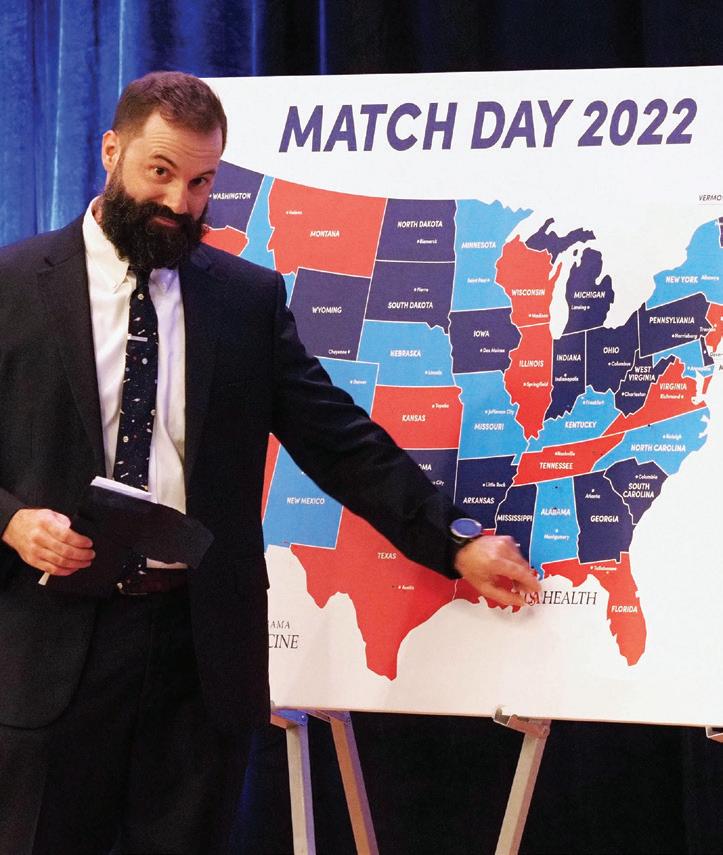
peripherally before medical school – as they both received their undergraduate degrees in engineering from USA – but credit medical school for bringing them closer together.
“We really got to know each other during the first year of medical school as we both became involved in the Muslims in Medi cine organization,” Omar said. “However, it wasn’t until later in the first year during anatomy that we would fall for each other as we studied together in the cadaver lab.”
Together, they matched in internal medicine at Saint Louis University School of Medicine. “I am thrilled,” Omar said. “Internal medicine allows me to integrate my chemical engineering background in ef ficiency and problem solving and translate that to the care of my patients. I enjoyed my internal medicine rotation the most during my time in medical school and see it as a field where my career can flourish.”
El-Sharkh said she is most excited to use the knowledge and skills that she has acquired during her time at the Whiddon College of Medicine in a real clinical set ting. “As a child, I loved playing the role of a doctor by helping to give my parents their medications and performing small tasks such as checking my mother’s blood pres sure or my father’s blood sugar,” she said. “From there, my passion to be a caretaker, combined with my intellectual curiosity, fueled my motivation to pursue a career in medicine. I believe that the breadth of internal medicine will allow me to utilize most of my knowledge in practice.”
received their academic hoods on May 5, Thomas’ hood was presented posthu mously to her parents, Harold Thomas and Christiana Hoff. The family established the scholarship endowment in 2021.
COVID-positive patients asked about intent to vaccinate in local study In 2020 and 2021, researchers at the Whiddon College of Medicine interviewed
hundreds of people who tested positive for COVID-19 in Mobile about their intent to get vaccinated for the virus in a study led by Casey L. Daniel, Ph.D., M.P.H., associate professor of family medicine and direc tor of epidemiology and public health.
Looking for trends among subgroups, the researchers asked questions over a year’s time, covering demographics, severity of illness, hospital stays and underlying
USA HEALTH MAGAZINE | VOL. 4, ISSUE 2 | 9
2022 Match Day Results 21 placed in hospitals matched out of state 46 26 matched in Alabama 72 USA medical students 16 states represented 47,675 national applicants 39,205 residency positions COMPETED FOR
Black Men in White Coats affiliate chapter established
don College of Medicine. He asks: “What if we had a medical workforce that actually reflected our patient population?”
With the goal of increasing the number of Black men in the field of medicine, the Whiddon College of Medicine has estab lished an affiliate chapter of Black Men in White Coats. Mirroring the national organi zation’s mission, the local chapter seeks to accomplish this objective through exposure, inspiration and mentorship.
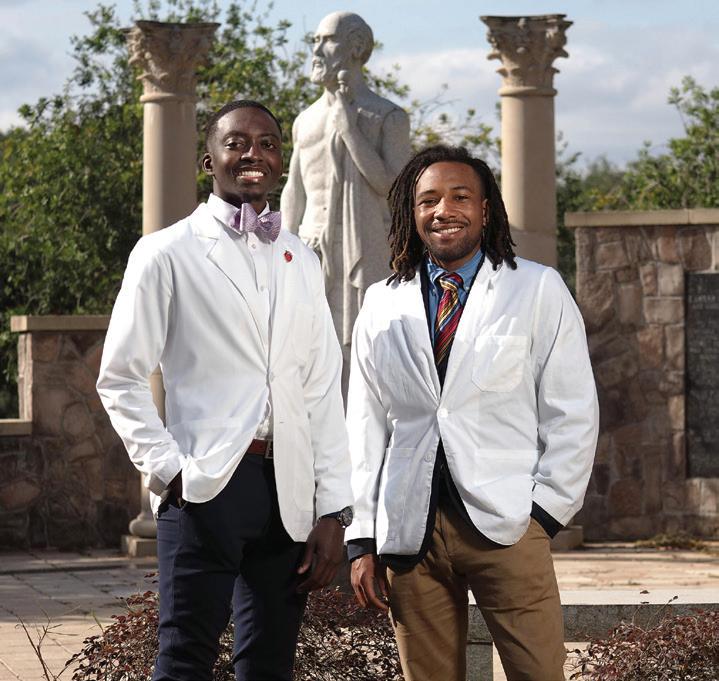
“Efforts such as this seek to dissect the systemic barriers preventing Black men from becoming medical doctors and the conse quences on society at large,” said Haynes, who is the faculty sponsor for the new chapter.
aspire to be physicians is something crucial. Having representation shows that their dreams are capable of being accomplished, and we are living proof that it is.”
Shaw said his aim as president is to help lead and build the chapter into one that will serve and mentor the community, “ushering in a new and bigger wave of Black doctors.”
Only 2 percent of American doctors are Black men. Black men also have the lowest life expectancy of any major demographic group in the United States.
This correlation comes as no surprise to Johnson Haynes Jr., M.D., assistant dean of diversity and inclusion and professor of internal medicine at the Frederick P. Whid
Second-year medical student Trentyn Shaw serves as the Whiddon College of Medicine affiliate chapter’s president.
“Representation: a single word that holds so much weight. Accomplishing one’s dream is a scary task on its own, but doing it alone can make it that much harder,” he said. “Be ing an example for young Black men who
Warren Law III, a first-year medical student and the chapter’s vice president, echoed Shaw’s goals for the organization. “Becoming a Black male physician may be difficult to imagine for Black men, because it is highly likely that they have never seen one before. Put simply, it is difficult to ‘be’ what you can’t ‘see,’” he said. “What I hope to accomplish as vice president of BMWC, is to afford young learners the ability to see what they very well can become.”
Through quarterly school visits, Haynes said the chapter plans to connect with local schools in partnership with the Whiddon College of Medicine’s Office of Diversity and Inclusion.
Whiddon College of Medicine joins effort to advance diversity, equity and inclusion
The Association of American Medical Colleges (AAMC) Council of Deans recently launched an initiative to advance diversity, equi ty and inclusion (DEI). This initiative is designed to respond to the academic medicine community’s desire for concrete actions and accountability from medical school leaders to accelerate mean ingful change that supports DEI and anti-racism efforts across U.S. and Canadian medical schools.
“I am pleased to announce that we have joined this national ef fort,” said John Marymont, M.D., M.B.A., vice president for medical affairs and dean of the Whiddon College of Medicine. “Participat ing in this initiative will help our school improve our organization
NEWS BRIEFS
health conditions. They found that women, Black patients and those with higher incomes were significantly less likely to say they planned to get the vaccine – findings that could guide future outreach efforts to increase vaccination.
Program advances lifesaving education in obstetrics care
With a goal to improve patient safety and positively impact maternal outcomes, faculty members and residents from the department of family medicine along with Monroe County Hospital staff recently participated in a training pro
al climate and culture by outlining our specific strengths and areas for improvement related to DEI.”
As part of the initiative, 109 medical schools are participating in a collective administration of the Diversity, Inclusion, Culture and Equity (DICE) Inventory. The AAMC will create a report of the aggregated national data for this initiative, analyzing trends in DEI policies, programs and practices across all medical schools.
“Participating in this initiative alongside national peers will allow us to benchmark our progress and will facilitate the development of future AAMC resources that will support our efforts to be a diverse, equitable and inclusive institution,” Marymont said.
gram on advanced life support in obstetrics (ALSO) at Monroe County Hospital in Monroeville, Alabama. The certification program is an evidence-based, interprofessional and multi disciplinary course that equips maternity care teams with skills to effectively manage obstetric emergencies.
Graduate students awarded Dean’s Predoctoral Fellowships
Three students in the Whiddon College of Medicine’s Basic Medical Sciences Graduate Program were awarded this year’s Dean’s Predoctoral Fellowships. The one-year fellowship program offers up to
10 | USA HEALTH MAGAZINE | VOL. 4, ISSUE2
COLLEGE OF MEDICINE NEWS
Medical students Warren Law III and Trentyn Shaw lead the affiliate chapter.
Physician-scientist awarded $1.9 million grant to study acidosis in the lungs
Critically ill patients with pneumonia often present with excessive acid in their blood, a condi tion called acidosis. However, whether acidosis is a marker or a mediator of disease progression is still unknown.
Ji Young Lee, M.D., Ph.D., an assistant professor in the department of physiology and cell biology and the department of internal medicine at the Frederick P. Whiddon College of Medicine, received a grant from the National Institutes of Health (NIH), totaling $1.9 million over a five-year period, to study how the lungs handle acid.
Lee’s laboratory is examining the fundamental mechanisms of pH regulation in pulmonary en dothelial cells. These cells, which line the blood vessels of the lungs, form a semipermeable barrier and regulate the exchange of fluids, gases and other substances.
“Findings from our study will help develop new diagnostic and therapeutic strategies for critically ill pneumonia patients,” said Lee, who also is a pulmo nary and critical care physician with USA Health.
“Since these patients often suffer from long-lasting complications even after discharge, as demonstrated by the COVID-19 long-haulers, we hope our work positively impacts both short- and long-term pneu monia outcomes.”
Lee, principal investigator of the project, is the recipient of the NIH’s Research Project Grant, also known as an R01 grant, which provides support for health-related research and development.
“As a researcher, it is a great honor that my work is supported by the experts in the field,” Lee said. “As a physician, it is a privilege that I can explore scientific questions that could potentially benefit my patients.”
Ji Young Lee, M.D., Ph.D., is studying the fundamental mechanisms of pH regulation in the lungs.
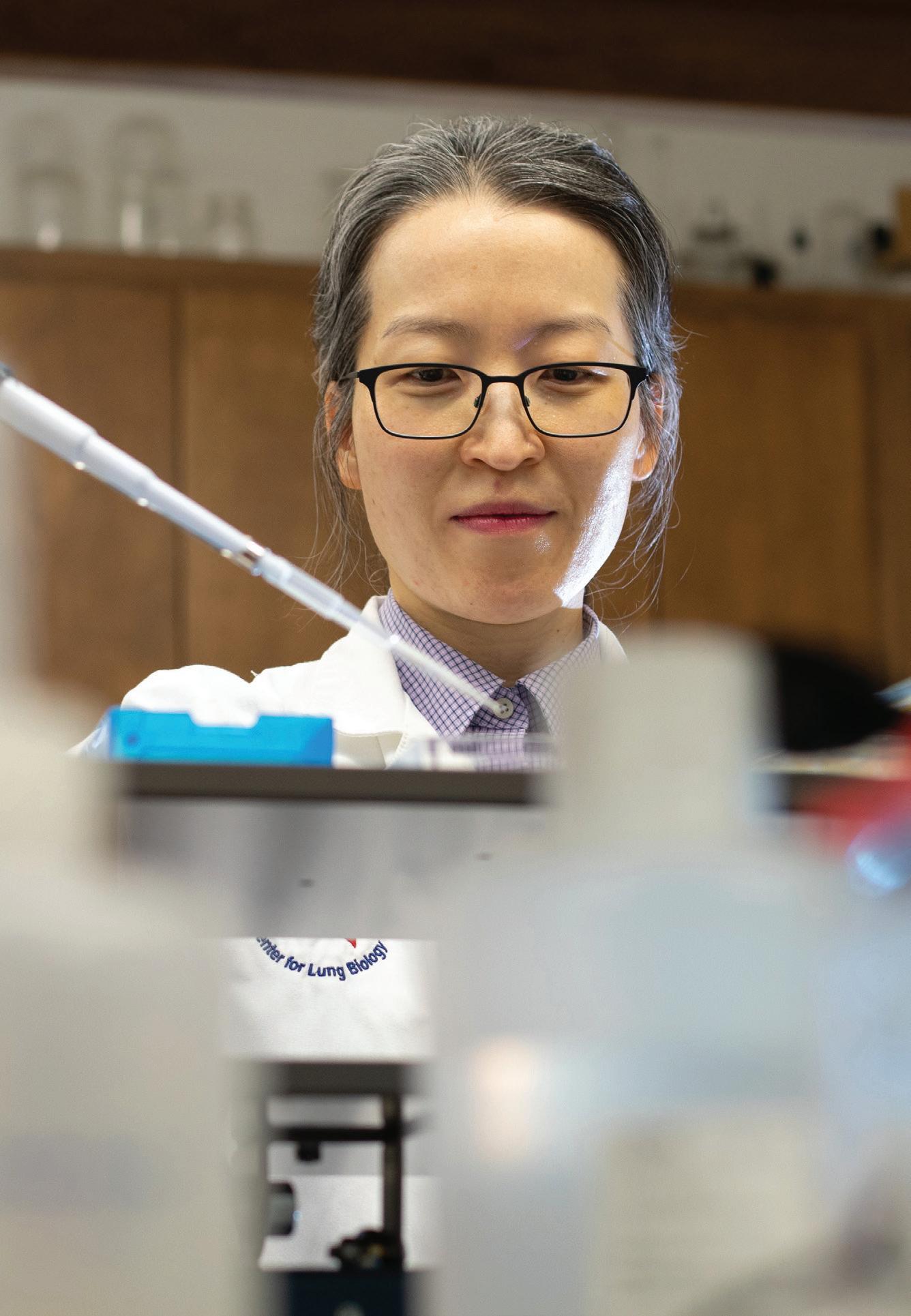
three $30,000 awards annually to Ph.D. students with Whiddon College of Medicine faculty as primary mentors. Jenny Hewes is looking at gender and pul monary arterial hypertension (PAH) – a fatal, progressive disease characterized by high blood pressure in the arteries of the lungs. Rachel Rodenberg
is focusing on herpes stromal keratitis (HSK), the leading cause of infectious blind ness in developed countries.
Reece Stevens is studying how carbonic anhydrase IX (CAIX) signaling protects the pulmo nary endothelial barrier.
Participants needed for NIH-sponsored research on long COVID USA Health is looking for people willing to take part in a nationwide study aimed at researching COVID with a goal of enhancing treatments and recovery from the virus. The study, sponsored by the
National Institutes of Health, seeks people ages 18 and old er, and doesn’t require partici pants to have been diagnosed with COVID. Participants may be asked to answer surveys ev ery three months, have simple health exams twice a year, and give small samples of blood, saliva, urine, stool and nasal
USA HEALTH MAGAZINE | VOL. 4, ISSUE 2 | 11
RESEARCH NEWS
Faculty uncover mechanism behind cognitive dysfunction after pneumonia
cytotoxic to the lung and the brain,” said Troy Stevens, Ph.D., director of the USA Center for Lung Biology. “Dysfunctional tau moves from the lung through the circulation to the brain, where it impairs the physiological processes responsible for learning and memory.”
Stevens, who also is professor and chair of physiology and cell biology, said their studies suggest that cytotoxic variants of tau represent a novel therapeutic target during lung infection.

Researchers at the Frederick P. Whid don College of Medicine’s Center for Lung Biology are the first to describe pneumonia as a tauopathy – an abnormal aggregation of tau protein in the brain.
Short- and long-term neurocognitive dysfunction is common among critically ill patients who develop pneumonia, but the
reasons behind this dysfunction are poorly understood. The dysfunction can present as impaired learning and memory, or as anxiety, depression and even post-traumat ic stress disorder.
“Our recent work demonstrates that bac teria causes a tau protein found within the lung to become dysfunctional; it becomes
“Effectively removing the cytotoxic tau from the lung, the circulation and the brain may help the lung, brain and other organs recover from infection; and it may improve patient health in the aftermath of their illness,” he said.
Lead investigators of the study were Ron Balczon, Ph.D., professor of biochemistry and molecular biology; Ji Young Lee, M.D., Ph.D., assistant professor of physiology and cell biology; and Mike T. Lin, Ph.D., associ ate professor of physiology and cell biology.
Ticks may transmit leprosy to people, research suggests
For most of a century, researchers have explored the potential role that arthropods –such as ticks – play in the transmission of lep rosy to humans and other animals, with little luck. Conclusive evidence hasn’t emerged on the topic in more than 80 years.
With that in mind, researchers from the Frederick P. Whiddon College of Medicine, in collaboration with the U.S. Department of Health and Human Services, have taken up the hunt.
The results from that collaboration
NEWS BRIEFS
fluid one to two times a year.
Participants will be paid for their time. For more info or to take part in the study, contact Rosanne Wilson, C.R.N.P., at 251-219-4324 or covid19research@health. southalabama.edu.
suggest that ticks themselves might serve as the point of transmission for leprosy and that tick cells are suitable for maintaining a viable form of the disease for an extended period of time.
Perhaps best known from biblical referenc es, leprosy is an infection caused by a bacteria found in the southern United States and elsewhere that spreads to animals, namely ar madillos, and people. The majority of patients diagnosed with leprosy spend extensive time outdoors but only rarely report any direct
contact with wild armadillos, said Natthida Tongluan, a graduate research assistant in the department of microbiology and immu nology and lead author of the study.
The study aimed to assess the potential for ticks to transmit leprosy and to test if the disease could be maintained in tickderived cells. Researchers found that tick-derived cells were able to maintain viable disease during a 49-day course of infection, and the leprosy remained infec tious within tick cells for at least 300 days.
USA National Alumni Associa tion recognizes USA Health
The University of South Ala bama National Alumni Associ ation honored USA Health as a community partner during the 17th annual Distinguished Alumni & Service Awards in March. Since the early days of the COVID-19 pandemic in
2020, USA Health has been on the front lines of the crisis, caring for sick patients at its hospitals and also partner ing with the City of Mobile to establish drive-through testing and, later, vaccine centers and offering protection to residents of nursing homes and correc tional facilities.
Medical students present at M3 Case Report Symposium
Rising fourth-year medical stu dents at the Whiddon College of Medicine presented interest ing, rare and novel case studies from their third-year rotations at the annual M3 Case Report
Symposium on May 27. The symposium, organized by
12 | USA HEALTH MAGAZINE | VOL. 4, ISSUE2
RESEARCH NEWS
Ron Balczon, Ph.D., professor of biochemistry and molecular biology, and Mike T. Lin, Ph.D., associate professor of physiology and cell biology, are two of the study’s lead investigators.
Cancer and DNA damage: Discovery may improve patient outcomes
A discovery made by Frederick P. Whid don College of Medicine scientists may provide further understanding of genes and factors that cause cancer, thereby improving treatment options for patients.

The study explores how the human genome constantly is damaged by environ mental and cellular products, which could lead to cancer if not properly repaired.
Robert W. Sobol, Ph.D., professor of pharmacology at the Whiddon College of Medicine and chief of the Molecular and Metabolic Oncology Program at the Mitch
ell Cancer Institute, is the lead author of the study, which delves into treatments for DNA damage and repair.
Genomes, composed of DNA, are a complete set of genetic instructions. Each genome contains all the information needed to build an organism and allow it to grow and develop. It is critical for cells to keep the genome intact. This is the main function of more than 200 genes that are part of the cellular pathways governing DNA damage and repair.
The goal of the study is to learn more
Nicotine weakens immune system, USA researchers find
Scientists at the Frederick P. Whiddon College of Medicine and the Mitchell Cancer Institute found that nicotine, the addictive ingredient in tobacco products and cigarette substitutes, plays a novel role in immu nosuppression. The findings highlight the health hazards of nicotine intake including an enhanced susceptibility to developing cancer.
Sirin Saranyutanon, Ph.D., a recent basic medical sciences graduate, investigated the effect of nicotine on macrophage polariza tion, growth and invasion to understand its role in human physiology. Macrophages are an important component of the innate immune system that can have both pro- and anti-inflammatory functions depending upon their polarization state.
“Our findings suggest that nicotine weak ens our immune system by altering the func
medical student Samuel Thom as, drew 55 entries on cases involving a variety of diagno ses from cancer to infectious diseases. Winners were Mat thew Joyner, first place; Kasey Andrews, second place; and Donavon Dahmer, third place.
about these critical proteins and how they respond to DNA damage.
“This breakthrough research uses state-ofthe-art microscopy and genetic techniques to follow the movement of key base excision repair pathways and their response to dam age, which could be beneficial for patients,” Sobol said. “Future studies can build on this discovery as we continually work to identify additional genes and factors that are defec tive or that may be considered biomarkers of response related to cancer.”
tion of macrophages, and converting them from defenders to the type that helps resolve protective inflammatory response and sup port tumor growth,” Saranyutanon said.
The findings add to the growing concern about the use of nicotine, said Ajay Singh, Ph.D., professor of pathology at the Whiddon College of Medicine and program leader of Cancer Biology and Cancer Health Dispari ties at the MCI.
“The use of nicotine through vaping has increased tremendously in recent years, especially among teens, owing to the belief that it’s less damaging than smoking,” Singh said. “Being a relatively newer trend, epidemiological data associating vaping with slow-developing diseases like cancer is not yet available. However, our findings should raise awareness about the harms that it can cause to human health.”
MCI accredited by the Commission on Cancer The Mitchell Cancer Institute once again has earned a three-year accreditation from the Commission on Can cer (CoC), which recognizes excellence in the delivery of comprehensive, patient-cen tered cancer care. The oncol
ogy program at USA Health has been accredited since 1976, including the MCI since it opened in 2008. To earn the accreditation from the CoC, established by the American College of Surgeons (ACS), a cancer program must meet 34 quality care standards, be evaluated every three years
through a survey process, and maintain levels of excellence in comprehensive care.
Residents, fellows compete in 2022 scholarship exposition
Residents and fellows at USA Health presented their scholarly activities from case reports, research projects, quality
USA HEALTH MAGAZINE | VOL. 4, ISSUE 2 | 13
Researchers Srijan Acharya, Ph.D., left, and Sirin Saranyutanon, Ph.D., study the effects of nicotine at the Mitchell Cancer Institute.
Researcher studies racial disparities in cervical cancer prevention
Santanu Dasgupta, Ph.D., a cancer researcher at the Mitchell Cancer Institute, received a $126,000 grant from the Elsa U. Pardee Foundation to identify stressrelated factors that contribute to the initia tion and progression of cervical cancer.
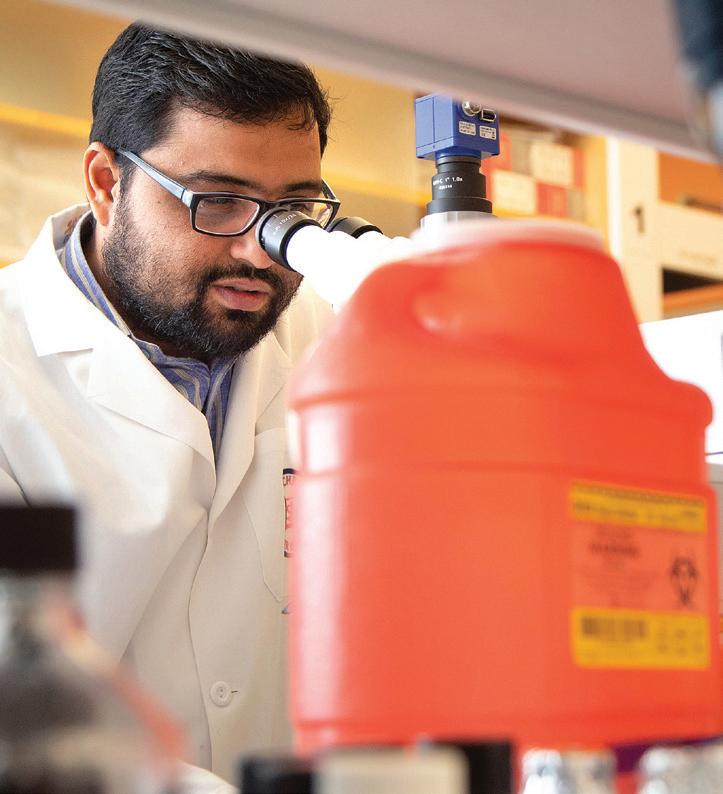
“In the United States, cervical cancer causes significant mortality in racially disparate women living under constant socioeconomic stress. In fact, the mortality rate for cervical cancer is the highest in Alabama and continues to rise every year,” Dasgupta said. “Our goal is to identify the
early epigenetic changes in cervical cancer to help in risk assessment and develop improved prevention strategies in these women.”
Dasgupta, an assistant professor of pathology at the Whiddon College of Med icine, is the principal investigator of the project. “My long-term goals are to identify specific factors relating to high mortality due to cervical cancer in our region and work in collaboration to reduce the exist ing disparity gaps,” he said.
The study will be conducted in collabora
tion with Ajay Singh, Ph.D., professor of on cologic sciences at the MCI and professor of pathology and biochemistry and molecular biology at the Whiddon College of Medicine; and Jennifer Young Pierce, M.D., M.P.H., a gynecologic oncologist, head of the cancer control and prevention division at the MCI, and professor of obstetrics and gynecology at the Whiddon College of Medicine.
The Elsa U. Pardee Foundation awards one-year grants for research projects devoted to the prevention, detection and treatment of cancer.
Scientists find novel mechanism underlying metastatic prostate cancer
Researchers at the Mitchell Cancer Institute and the Whiddon College of Med icine uncovered a novel mechanism that underlies castration therapy resistance in metastatic prostate cancer.
Patients whose cancer has spread beyond the prostate gland receive a type of hormone therapy, known as androgen deprivation therapy or castration therapy, as a first line of treatment. However, most patients with metastatic prostate cancer undergo relapse, and the cancer comes back in a more aggressive castration-re sistant form. This type of prostate cancer also does not respond favorably to alter native therapies, eventually leading to the patient’s death.
“Our findings unfold a novel mechanism underlying the failure of castration therapy
and identify MYB, a protein-coding gene, as a target of interest,” said Mohammad Aslam Khan, Ph.D., a senior research as sociate at the MCI and one of the project’s lead investigators. “We show that MYB sup ports the growth of prostate cancer when subjected to castration therapy by inter acting and sustaining the transcriptional activity of the androgen receptor.”
Khan said their findings would push for the development of novel therapeutic approaches that either directly target MYB or block its interaction with the androgen receptor. “MYB also may be used as a bio marker to predict the response of patients to castration therapy beforehand, thus sav ing patients from unnecessary treatment and financial burden,” he said.
NEWS BRIEFS
improvement projects, and patient safety, education and advocacy projects at the USA Resident and Fellow Schol arship Exposition on June 16. Winners in the poster presenta tion categories were Jonathan Jones, M.D., OB-GYN resident; Chaitra Manjunath, M.D., pediatrics resident; and Katie
Vines, M.D., surgery resident. Oral presentation winners were Benjamin Eisenman, M.D., family medicine resident; Jorge Sucar-Marquez, M.D., pediatrics resident; and Joseph Anderson, M.D., orthopaedic surgery resident.
Medical students take part in summer research
This year, 57 medical students, 12 of whom are incoming first-years, participated in the Whiddon College of Medicine’s Summer Research Program, which culminated on July 22 with the 49th annual Medical Student Research Day. The
program matches incoming first-year medical students and rising second-year medical students with basic science and clinical faculty researchers. The summer experience includes hands-on research, a seminar program that focuses on vari ous scientific and clinical topics, and student presentations.
14 | USA HEALTH MAGAZINE | VOL. 4, ISSUE2 RESEARCH NEWS
Mohammad Aslam Khan, Ph.D., a senior research associate at the Mitchell Cancer Insti tute, is one of the project’s lead investigators.
THE NUMBERS
Focus on research
USA Health and the Frederick P. Whiddon College of Medicine are committed to developing innovative biomedical research in an effort to enrich the lives of those in the Gulf Coast region and beyond.
Total COM extramural funding support for FY 2021
Largest source of extramural funding: National Institutes of Health (NIH)
Ph.D. students in basic medical sciences
Clinical and basic sciences faculty members
Total COM funded projects for FY 2021
Research
research fellows
USA HEALTH MAGAZINE | VOL. 4, ISSUE 2 | 15
BY
$25,010,809
52
131
17 Postdoctoral
57 Participants in the 2022 Medical Student Summer
Program
270 7 Research centers and institutes 4 Core laboratories
Freestanding emergency department opens at USA Health West Mobile Campus

USA Health celebrated the opening of its freestanding emergency department on March 14. Located at 181 Hillcrest Road, the facility provides people who live and work in west Mobile more convenient access to the most advanced emergency and diagnostic care available in the region.

“When people in west Mobile are in need of emergency care, they now have a facility that is fully staffed by physicians who are board-certified in emergency medicine,” said Owen Bailey, M.S.H.A., chief execu tive officer of USA Health. “This facility is the first part of a comprehensive medical campus designed to meet the emergent and everyday healthcare needs of patients – all designed to be convenient for the people of west Mobile.”
USA Health anticipates up to 15,000 patient visits per year at the location, which operates 24 hours a day, seven days a week. Led by board-certified emergency medicine physicians, patient care is supported by significant imaging capabilities, including a CT scanner, an MRI, mammography, X-ray and ultrasound.
“While this facility may look like its only purpose is to provide emergency medical care for people who come through its doors, it is so much more. Its impacts will be felt throughout the state and region,” said John V. Marymont, M.D., M.B.A., executive vice president for medical affairs and dean of the Frederick P. Whiddon College of Medicine.
Located adjacent to USA’s main campus, the new facility also will help to bring about new treatments, cures and preventions for diseases. The synergistic relationship between clinicians and basic scientists will
The facility is located at the USA Health West Mobile Campus at 181 Hillcrest Road.

Led by board-certified emergency medicine physicians, the center is open 24 hours a day, seven days a week.
be enhanced by this facility because of its proximity to the main USA campus.
The facility also will impact the future healthcare workforce. USA Health estab lished an emergency medicine residency program in 2019 to increase the number of physicians specifically trained for emer gency medicine. In addition to the medical school, USA has introductory and advanced educational programs in nursing, occupa tional therapy, physical therapy, physician
assistant, radiological services, and speech pathology and audiology.
“Alabama currently has a shortage of board-certified emergency medicine physicians to care for citizens locally and throughout our state,” said Edward Panacek, M.D., professor and chair of emergency medicine. “This new facility will increase opportunities for our resident physicians to train with faculty physicians at a new loca tion inside our academic health system.”
16 | USA HEALTH MAGAZINE | VOL. 4, ISSUE2
USA Health officials celebrated the opening of the freestanding emergency department with a ribbon-cutting ceremony in March.
USA Health OB-GYN adds new clinic in Mobile
In an effort to expand care to women in the Mobile community, USA Health’s de partment of obstetrics and gynecology has added a new office at 4300 Old Shell Road across from Spring Hill College.



The USA Health Obstetrics and Gyne cology-Springhill location provides general
care for adolescents, teens and women, including puberty education, routine gynecologic exams, obstetric care and maternal-fetal medicine consultations.
Providers at this location include Amelia Hewes, M.D.; Candice Holliday, M.D.; Frank Bodie, M.D.; Susan Baker, M.D.; and
Taria Battle, C.R.N.P.
To make an appointment, call 251-415-1496.
Amelia Hewes, M.D., talks with a patient at the new clinic.
Coastal OB/GYN joins USA Health
A new OB-GYN practice has joined USA Health. Coastal OB/GYN is housed in a newly renovated space in the Dauphin 65 Building. The clinic is home to five board-certified obstetrician/gynecologists:
• Maria Davila, M.D.
• Brooke Lenz, M.D.
• Amy McCoy, M.D.
• Katelyn Parnell, M.D.
• Erin Saucier, M.D.
The clinic is located at 3290 Dauphin St. in Suite 200. To make an appointment, call 251-361-2595.
USA HEALTH MAGAZINE | VOL. 4, ISSUE 2 | 17 WATCH US GROW
Bilingual referral specialist enhances patient accessibility
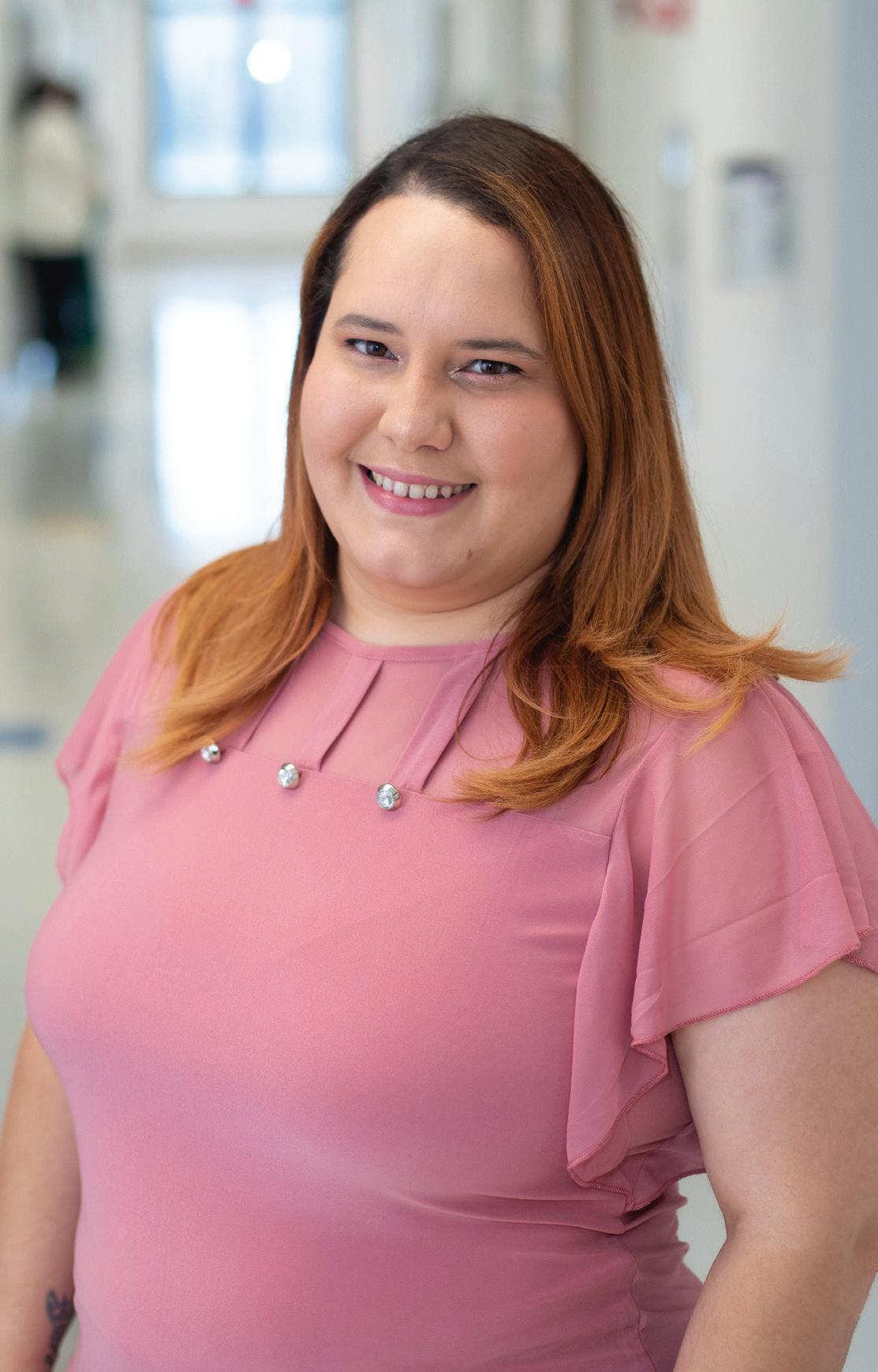
USA Health’s centralized care access referral team is opti mizing and expanding patient accessibility with the addition of Laiza Ramos-Pamias, a new bilingual referral specialist who provides translation services to Spanish-speaking patients. Ramos-Pamias plays an instrumental role in improving pa tients’ healthcare experiences by overcoming language barriers between patients and USA Health providers.
“I am excited about being able to assist people in receiving the help and care they need and deserve, and being able to be the bridge that takes them to another level of care and understand ing,” Ramos-Pamias said.
Ramos-Pamias provides direct-dial conference call support to assist patients, providers and other team members with scheduling appointments, registration and rooming or visit discussions. She also collaborates with USA Health clinic leaders to participate in designated clinic days for Spanish-speaking pa tients. When scheduled in advance, Ramos-Pamias serves as an in-person translator for patients in circumstances that require more interaction than video translations provide.
“There is really no substitute for in-person translation, and I am so happy that we now will be able to offer it,” said Amy Mitchell, director of the USA Regional Autism Network. “We have noticed a significant increase in calls from Spanish-speak ing families, and it will be much less complicated and much more personal to be able to utilize Laiza on these calls.”
Outside of the new translation service, USA Health also offers audio and print translations for 125 different languages and dialects and video-format translations in 40 languages.
USA Health Pediatrics expands with medical office in Semmes
For the convenience of our young patients and their families living in west Mobile and beyond, USA Health Pediatrics has expanded its practice to include a medical office in Semmes.

On March 15, Katrina Roberson-Trammell, M.D., and Me lissa Huff, D.N.P., C.R.N.P., moved from the Strada Patient Care Center in midtown Mobile to 7885 Moffett Road, Suite 102, in the Walmart shopping center.
To make an appointment, call 251-410-5437 (KIDS).
18 | USA HEALTH MAGAZINE | VOL. 4, ISSUE2
Katrina Roberson-Trammell, M.D., cares for a pediatric patient at the Semmes location.
WATCH US GROW
USA Health holds groundbreaking and ‘topping out’ events
USA Health held several groundbreaking ceremonies and “topping out” events, which mark a facility’s construction reaching its highest point.
Clockwise:
Louis Mapp, philanthropist and volunteer, signs the beam to be hoisted to the top of the medical office building at the Mapp Family Campus in Baldwin County.
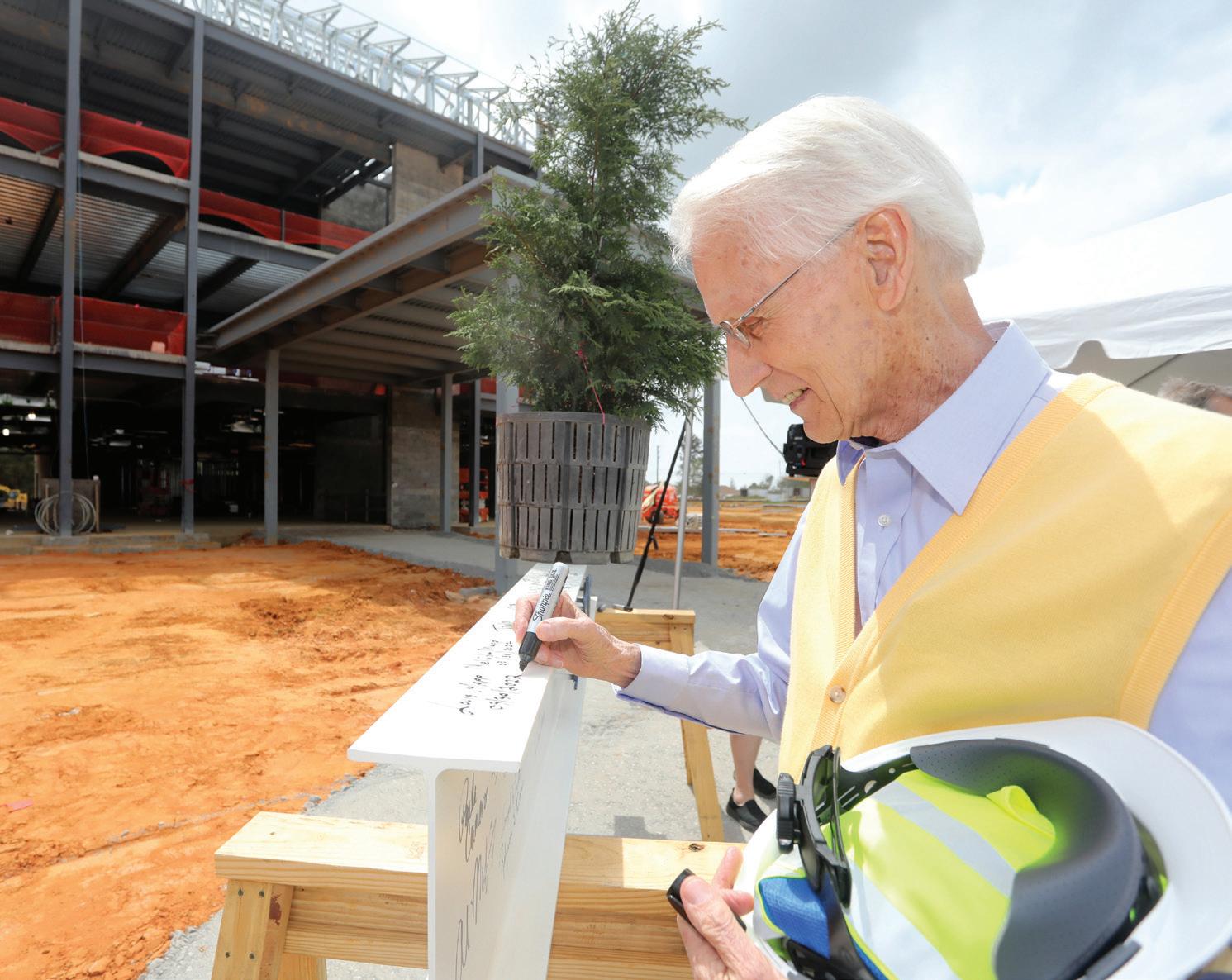
The construction crew lifts the beam to the highest point of the medical office building at the USA Health West Mobile Campus.

Tim Dexter, associate director of safety and security, signs the beam at the USA Health Mobile Diagnostic Center topping out ceremony.

Fairhope Mayor Sherry Sullivan speaks at the groundbreaking for the ambulatory surgery center at the Mapp Family Campus.
USA Health breaks ground on the ambulatory surgery center at the Mapp Family Campus.
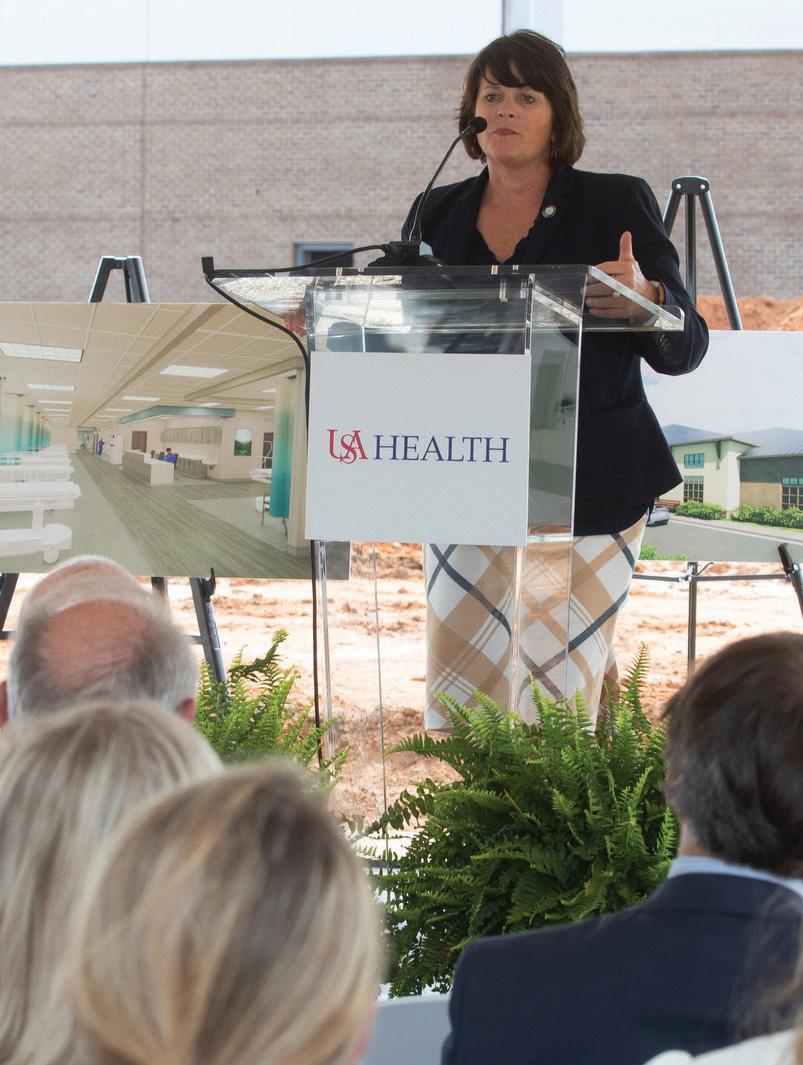
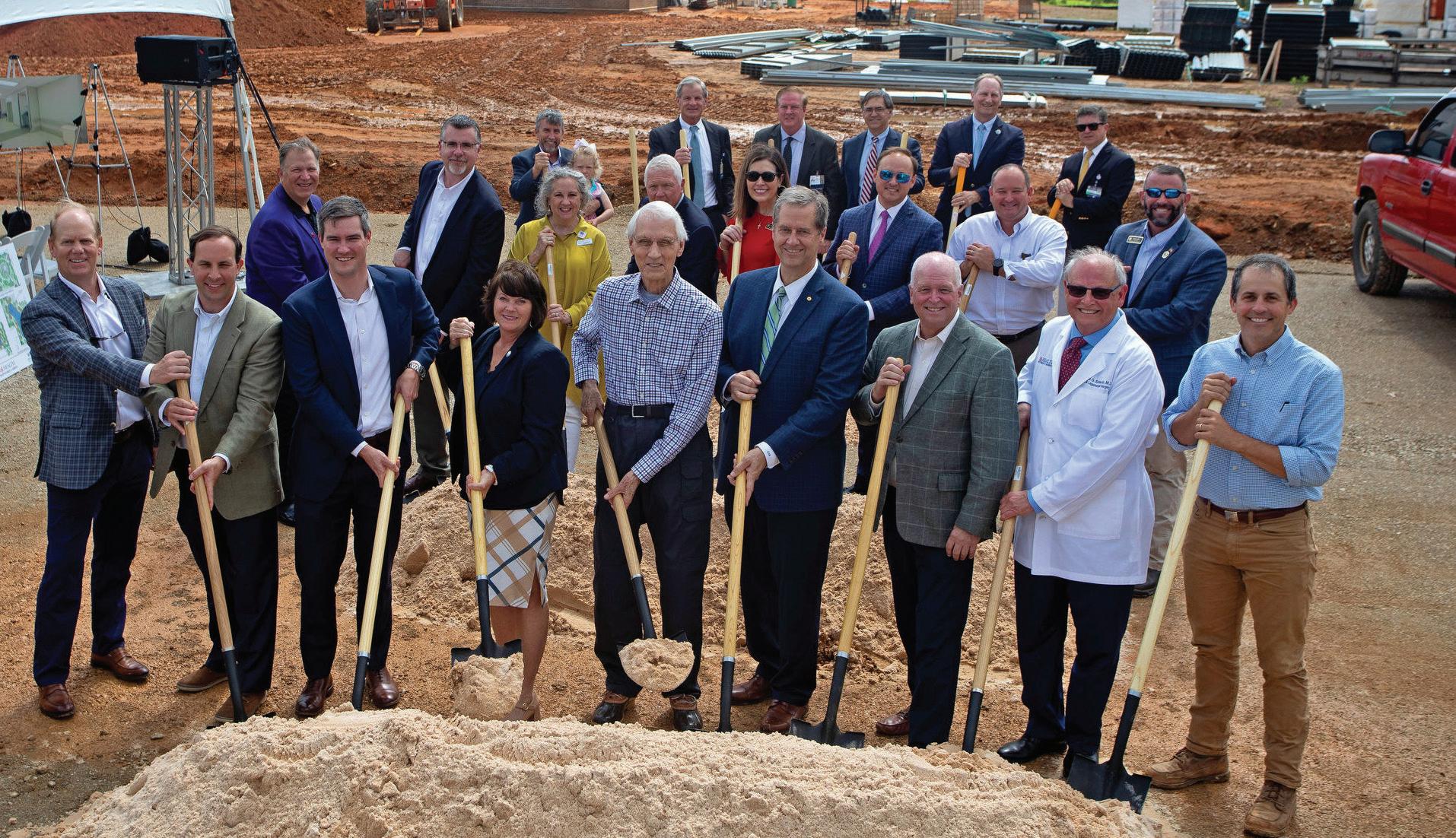
USA HEALTH MAGAZINE | VOL. 4, ISSUE 2 | 19
Demolish, construct, renovate: Projects in progress at USA Health
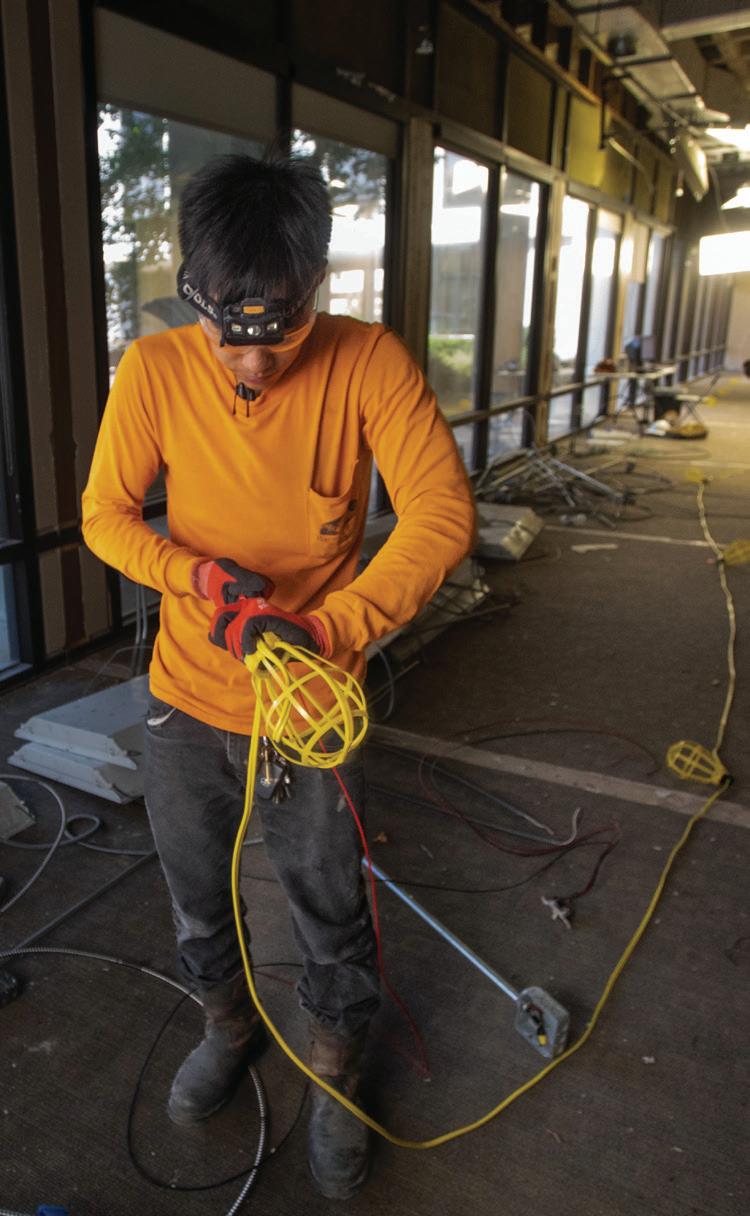


20 | USA HEALTH MAGAZINE | VOL. 4, ISSUE2 WATCH US GROW
1 2 3





USA HEALTH MAGAZINE | VOL. 4, ISSUE 2 | 21 4 5 6 7 8 Numerous building projects are in progress across the health system: 1. Construction of the USA Health Mobile Diagnostic Center medical office building 2. Demolition of the former administration offices at Children’s & Women’s Hospital to prepare for the new Pediatric Emergency Center 3 and 4. Construction of the medical office building at the Mapp Family Campus 5. Renovation of Children’s & Women’s Hospital’s fifth floor, which will house a modern postpartum unit 6. Construction of Eastern Shore OB-GYN / Pediatrics at the Eastern Shore Centre in Spanish Fort 7. Construction of the space to house Coastal OB-GYN’s new location at Dauphin 65 8. Renovation of the fifth floor of Children’s & Women’s Hospital
Strategies for weight management
By Ann Payne-Johnson, M.D, Assistant Professor of Family Medicine
Weight management is a passion of mine. It’s not just about pounds on a scale; it’s about metabolic wellness. I grew up with two parents who had diabetes, and I watched them on a long journey of learning about food and activity. I keep this in mind when coaching patients about weight loss. I like to use the analogy of your body being a car, and you should only fill it with what can be used in the hours between meals.
Weight management is not just about what you put in versus what you burn off. There are a number of factors that contribute to the end result.
Environment
Where you live and how you live plays a huge role in your weight.
Stress
Stress increases your cortisol level, which can lead to long-term weight gain. Practicing mindfulness can help you eat less in response. Other practices such as yoga or cognitive behavioral therapy can be great additions to stress management.
Diet
It’s a fact that we are what we eat. The less you eat out, the fewer calories you consume. Stores and restaurants have to store food for long periods of time, requiring the use of many additives. Start shopping the perimeter of the grocery store, which means more fresh meat and produce. Remind yourself that if it’s in a box or package, it likely has more calories than something fresh. Drink at least 60 ounces of water a day. Apps are available to help track calories and show you how many carbohydrates, proteins and fats you are eating.
Movement
Being active is a must. Start with 30 minutes of active exercise at least three days a week. It can be as simple as walking around your block or inside a store. Park a little farther from entrances. Then do at least two days of resistance training, which can even be done in a chair or while driving. Sitting for long periods of time can lead to more metabolic illnesses, poor core strength, and increased weight. Use a fitness tracker to track your steps and shoot for at least 6,000 steps a day. Many fitness devices prompt you to move more. Find a workout buddy you can talk with on your walks.
Sleep
Sleep is critical to maintaining a healthy weight. Your body makes hormones that are affected by lack of uninterrupted sleep. Sleeping too little increases a hormone called ghrelin that makes you more hungry. Sleep is the time your body resets and repackages hormones that will keep you happy and regulate your appetite.
Genetics
There are known genes that increase the likelihood for some people to store body fat. Genetics aren’t everything, so you can fight this by maintaining a relatively healthy lifestyle.
Medications
Review your medications with your provider to ensure that you have a good understanding of how medications can affect your weight.
Overall, the best way to start is to visit your doctor. Ask for any necessary lab tests and whether changes in your diet or exercise regimen are right for you. When researching and seeking advice, consult professionals trained in wellness. Depending on the internet or friends can lead to results that aren’t necessarily the best for you and your metabolism.
22 | USA HEALTH MAGAZINE | VOL. 4, ISSUE2 PREVENTION
Fueling your body with fresh foods
If you’re trying to look and feel your best, it’s important to incorporate fresh, seasonal fruits and vegetables into your diet. Phyllus Justice, M.P.H., R.D., a diabetes resource coordinator at USA Health Mobile Diagnostic Center, recommends these nutrient-dense foods:
• Berries: These fruits are rich in antioxidants and vitamins B and C and high in fiber, which helps you feel full longer and reduces the temptation to snack between meals.
• Cucumbers: At 95% water, cucumbers are hydrating and just what we need to beat the heat. They also contain antioxidant and anti-inflammatory benefits.
• Zucchini: One cup of sliced zucchini is low in calories (just 17) and carbs (3 grams) and rich in potassium, calcium and vitamins A and C.
• Grilled kabobs: Lean proteins like chicken, fish and other seafood are loaded with amino acids that help with maintaining lean muscle.
• Peas: With some of the highest protein and iron levels of any vegetables, peas are a great substitute for meats that are high in saturated fat.
• Peaches: One medium peach contains 39 calories and is rich in potassium and vitamin C. The antioxidant beta carotene gives peaches their golden color and is converted by the body into vitamin A, which aids eye health.
• Tomatoes: One medium tomato contains just 32 calories with 2 grams of fiber. They’re a good source of vitamins and minerals including vitamin C, potassium and lycopene, an antioxidant that helps protect against sun damage.
Air Fryer Zucchini Chips

Ingredients:
Directions:
large zucchini
tablespoon of olive oil
teaspoon of garlic powder
to taste
Pepper to taste
cup of parmesan cheese
1. Slice the zucchini into ¼-inch rounds.
2. Transfer to a large mixing bowl and drizzle with olive oil, garlic powder, salt and pepper. Gently toss to combine.
3. Transfer to the air fryer and top with shredded parmesan.
4. Set your air fryer to 400°F. After 5 minutes, open air fryer and flip the zucchini, then sprinkle parmesan on the other side. Close air fryer and cook another 4 to 5 minutes.
5. The zucchini rounds are ready once the parmesan cheese is golden brown and the edges of the zucchini are crisp.
USA HEALTH MAGAZINE | VOL. 4, ISSUE 2 | 23
2
1
1
Salt
¼
This determined 11-year-old battled cancer two years ago and lost her leg. Supported by family and hospital staff, she’s never lost her will to fight, though, learning to walk, climb stairs and ride a bike again with the use of a prosthetic.
BY CASANDRA ANDREWS
On a cloudy day in March 2020, just before the pandemic shut down most schools, third-grader Carmen Hunter was playing a game of Duck, Duck, Goose when she crumpled to the ground.
“The teacher called me,” her mother, Carlena Hunter, recalled. “I went there, and I was met with a screaming child. The screams were indescribable.”
At the hospital a short time later, im ages revealed a fractured femur and what looked like a bone cyst, Hunter said.
Carmen was placed in a cast that stretched from under her arms to below her knee. Numerous doctor’s appoint ments followed. The 9-year-old contin ued to experience intense pain at night, sometimes waking up in tears. By June, her mom noticed Carmen was losing weight.
Hunter quickly brought her daughter in to see a doctor. More medical tests were ordered.
Eventually, mother and daughter returned home to wait on the results. July 4th came and went as worry washed over them. Hunter remembers praying hard during that time. Finally, a call came on July 7 asking them to return to the hospi tal. Hunter gathered as much courage as
she could for the drive across town.
Barely out of third grade, Carmen was diagnosed with osteosarcoma, a rare form of bone cancer found in children, teens and young adults. Only about 2% of childhood cancers are osteosarcomas, impacting about 400 children younger than 20 each year in the United States.
“After hearing cancer, you want to let it go out of your mind,” Hunter said. “You want it to not be so. I can’t remember anything that was said (that day). It just was running me over.”
Carmen remained calm and inquisi tive, her mom said: “This child heard the results, and she was so solid. She actually asked questions when I couldn’t even form words.”
An ‘amazing hospital family’
Looking back, Hunter said she genuinely appreciates how honest and caring the physicians and staff mem bers were at USA Health Children’s & Women’s Hospital during her daughter’s battle with cancer. When discussing the diagnosis, the family was given informa tion about potential outcomes following
chemotherapy treatment to shrink the tumor in Carmen’s leg. They talked about limb-salvaging surgery and the possibility of amputation.
“Even when I didn’t like what they were saying, the doctors and nurses were upfront with us,” Hunter said. “Carmen was blessed to have a beyond amazing hospital family. I say family because their involvement and attentiveness surpassed just doing a job.”
After deciding on a treatment plan that was expected to span most of a year, Carmen had surgery a few days later to place a port in her upper chest. The port allowed the intravenous delivery of che motherapy drugs aimed at shrinking the tumor. As time passed, her mother said, Carmen did her best to remain positive. Staying in a hospital confined to a room during a global health pandemic, though, proved to be difficult sometimes for the extroverted child who loved to try on different accents and practice her skills as a social media influencer.
Carmen and her mother, Carlena Hunter, spend a morning walking through the Geri Moulton Children’s Park on the campus of Children’s & Women’s Hospital in June 2022.
24 | USA HEALTH MAGAZINE | VOL. 4, ISSUE2

After speaking to the crowd, Carmen Hunter rings the bell in the courtyard at Children’s & Women’s Hospital in September 2021 to mark the end of her cancer treatment.
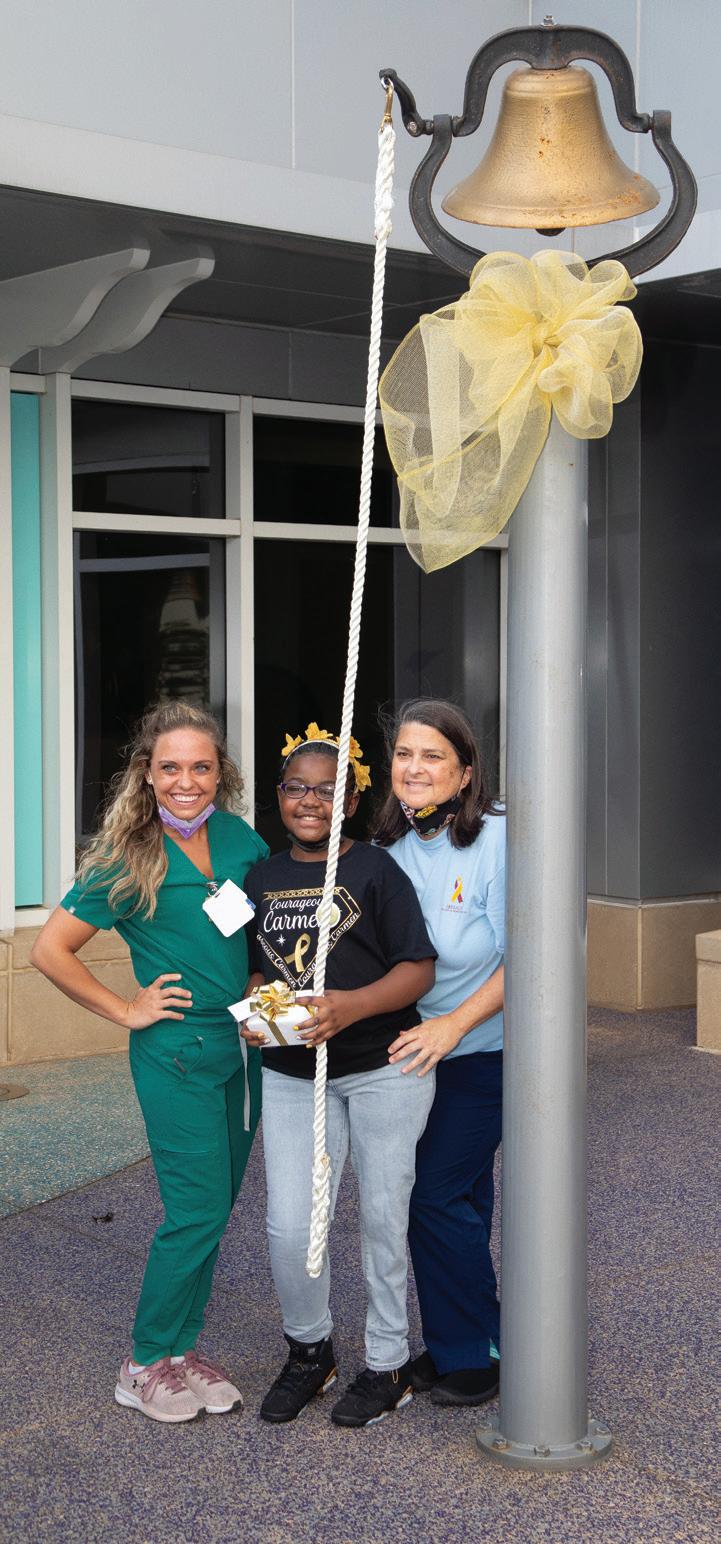
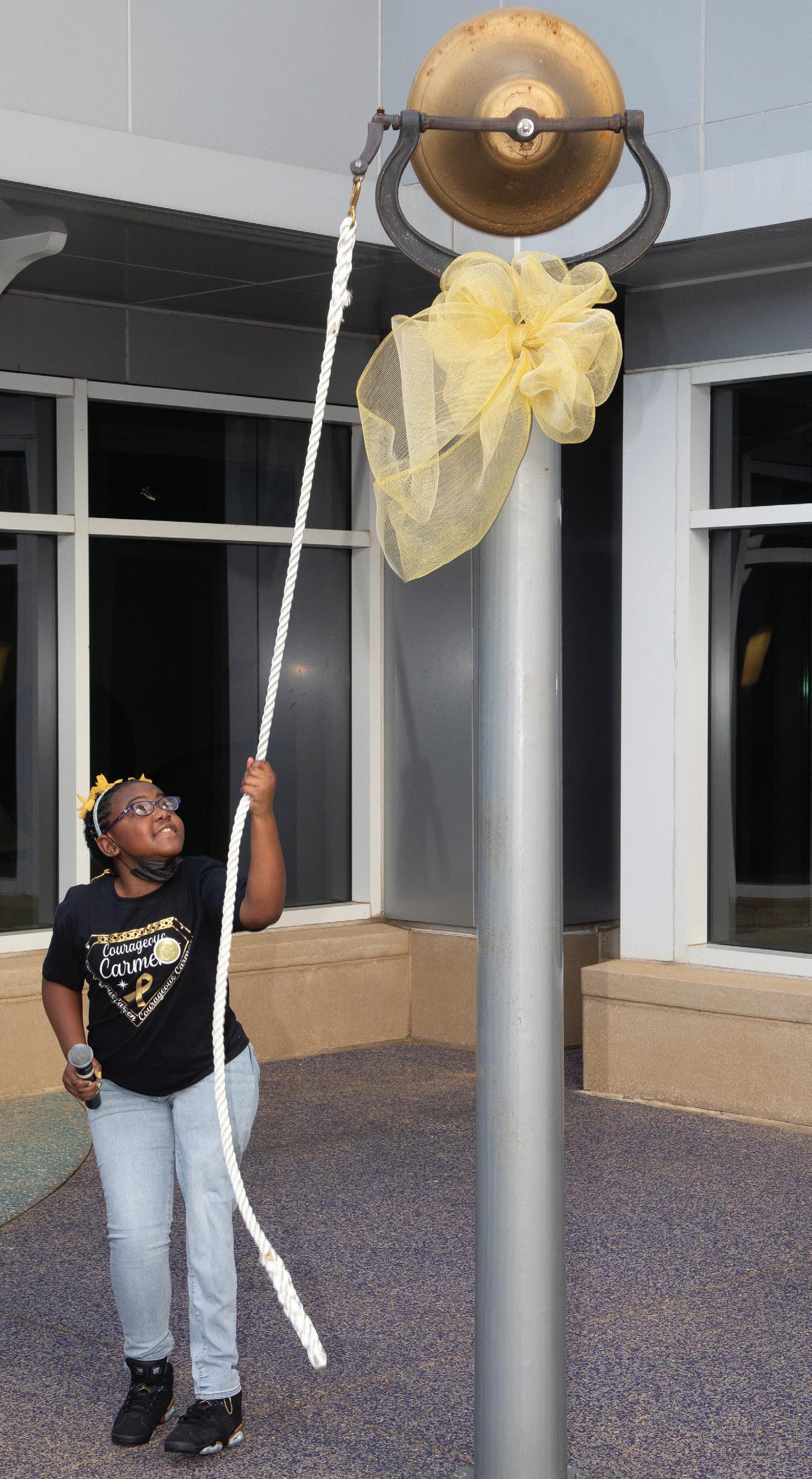
Carmen celebrates with some of her caregivers after the bell-ringing service.
On March 30, 2021, Carmen hugs Beth Abston, a member of the Mapp Family & Child Life staff at the hospital following a private ceremony to mark the end of her treatment for bone cancer.
Opposite page: Carmen, her mother, Carlena Hunter, and older siblings pose with Hamayun Im ran, M.D., a pediatric hematologist and oncologist at the hospital.
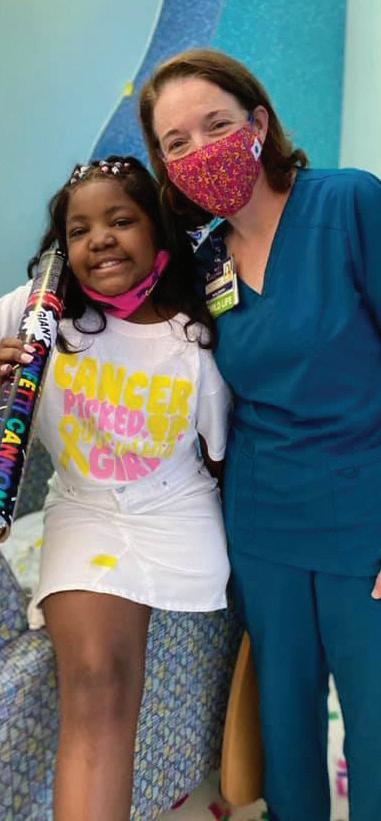
26 | USA HEALTH MAGAZINE | VOL. 4, ISSUE2
When the illness and side effects of chemo wore Carmen down, nurses and other staff members were there to lift her spirits, Hunt er said: “They would come in and talk and TikTok or dance with her until she smiled. If all that failed, they would get Mrs. Beth, and she could fix just about anything.”
Beth Abston is a member of the Mapp Family & Child Life Program at Children’s & Women’s Hospital. Part of USA Health, the only academic health system on the upper Gulf Coast, Children’s & Women’s treats children with cancer using a multidisciplinary approach that includes board-certified physicians, advanced prac tice providers, therapists, nurses, teachers and child life specialists who focus on caring for patients and supporting their families through a journey that can span several years.
“Beth was like a sister and mother and a best friend to me,” Hunter said. “Some days she was all I had. So many people, they do a job and that’s it. Never did I feel like it was just a job for them. The social worker was also a breath of fresh air. They really don’t know what they did for me. It left an impression for life.”
Hunter was able to stay with her youngest daughter in the hos pital because family members stepped in to help care for her other children. Carmen’s grandmother moved into their home in Mobile to look after Carmen’s siblings during her treatment. Carmen’s father, Cortez Hunter, is a truck driver who was required to travel long distances for work during her illness.
A life-changing decision
After a few months of hospital stays and chemotherapy treat ments, the family was told Carmen’s tumor wasn’t shrinking. It also didn’t look as if the cancer had spread beyond her leg, a hope ful sign, Hunter said.
In September of 2020, Carmen and her parents dealt with more difficult news. The cancer had wrapped around Carmen’s nerves and blood vessels. Gaining clear margins – making sure all of the cancer cells were removed during surgery – would be extremely difficult. “Amputation was a subject that we thought was a worstcase scenario,” Hunter said, “not something that had to happen.”
After talking things over with her husband, the couple left the decision up to Carmen, her mother said. “It really wasn’t ours to make.”
Carmen underwent surgery to remove her left leg on Sept. 23, 2020.
“This was the only day or time I will say I felt that my baby was broken,” Hunter said. “She wasn’t giving up, but she had hit a plateau” before the amputation. “She couldn’t smile through it anymore. It was what it was, and it was bad. I allowed her to have her time, and assured her that it was OK to not be OK and to take all the time she needed.”
Four or five days post-surgery, Hunter said her daughter began to bounce back: “Carmen’s strength was unbelievable. It’s almost like she was determined cancer wasn’t going to get anything other than her leg.”
There’s not much she can’t do
While the tween was comfortable hopping on one leg to get around at home, Carmen soon began working with physical thera pists to gain more mobility using a prosthetic leg.
“Seeing her walk gave me so much more hope,” Hunter said. “It put things in perspective. The more they worked with her, as time went on, it got better and better.”
One day, her mom took video that showed a determined Car men walking briskly on a treadmill. During therapy sessions she also learned to climb stairs and even ride a bike again. “Our dream is for her to learn to skate again. She loves to skate and she wants to be able to,” she said. “There’s really not much she can’t do.”
Eight months after first learning she had a rare bone cancer, Carmen stood on one leg inside the pediatric infusion center at Children’s & Women’s Hospital, her eyes crinkling at the edges as she smiled. She used her best British accent to thank those gathered to cheer her on as she rang the bell on March 29, 2021, to signify the end of her cancer treatment.
One of the people celebrating with Carmen that day in March last year was Abston, who had spent months helping the Hunter family deal with life after a pediatric cancer diagnosis.
“Carmen is an amazing young lady,” Abston said. “Watching her grow through this experience with grace and tenacity has been so gratifying to see.”
These days, Carmen is looking forward to returning to in-person school this fall. She loves to swim and go on Target runs with her family. “Carmen is now cancer free,” her mom said. “She is still a bubbly, smart, loving girl and has no regrets except for having cancer during COVID.”
The sixth-grader was selected to represent Children’s & Wom en’s Hospital as a Children’s Miracle Network champion child for 2022. Her photo was included in fundraising campaigns across the region at Publix grocery stores, plus Walmart and Sam’s Club locations.
Of her experience at the hospital, Carmen said staff were “really, truly the best support system I could have ever asked for.” She add ed: “Thank you so much for being there for me, especially when I was at my lowest.”

USA HEALTH MAGAZINE | VOL. 4, ISSUE 2 | 27
FEATURE
Legacy families come full circle

Whether they pursued careers in academic medicine, military service or private practice, three alumni legacy families all started their medical education journeys at the same place – the Frederick P. Whiddon College of Medicine at the University of South Alabama. Following their parents’ example, these medical students and recent graduate are training to make their own mark in medicine.
BY LINDSAY LYLE
Kevin P. Michaels, M.D., M.P.H., Class of 1992
Benjamin Michaels, Class of 2023
On Ben Michaels’ interview day for medical school, his father, Kevin Michaels, M.D., gave him something for good luck –the very pen he used when he interviewed at the Frederick P. Whiddon College of Medicine 30 years before.
“That lucky pen is probably why I was accepted,” said Ben Michaels, a rising fourth-year medical student.
The father and son have more in com mon than their pick for medical school.
Kevin Michaels joined the U.S. Army ROTC as a way to help pay for college and went on to serve 25 years as a military physician before retiring as a colonel. He recently was appointed health officer for the Mobile County Health Department.
Ben Michaels received a scholarship through the Health Professions Scholarship Program and is on the path to becoming a military provider like his dad.
“I honestly cannot think of a more rewarding job than providing care for the great men, women and dependents of the military,” Ben Michaels said. “Military ser vice members have unique medical needs as a patient population. My experience with my family gives me some insight and perspective that will make me a better mili tary provider.”
In addition to his father, his brother and
sister are officers in the Army. Ben Mi chaels chose a different branch of service. He is commissioned as a 2nd lieutenant in the U.S. Air Force.
“The physicians in all four military services serve alongside one another, and the only difference is their uniforms,” Kevin Michaels said of his son’s distinction. “We all do the same thing: take care of service members and their families. I am proud of his choice to serve our country.”
Like many aspiring doctors, Kevin Mi chaels didn’t get into medical school on his first try. He earned a degree in epidemiolo gy at the University of Alabama at Bir mingham before applying to the Whiddon College of Medicine. Perhaps a credit to his lucky pen, he was accepted and entered medical school in the fall of 1988.
“The faculty and students made a sig nificant impression on me. This is where I wanted to be,” Kevin Michaels said. He fondly recalls the friendships he formed at the Whiddon College of Medicine and the support he received during difficult times.
Still, he never pushed his son to follow the same track. “Ben always had a choice of where he wanted to go,” he said. “I spoke positively about my time, and when he interviewed I think he appreciated my description of the school.”
Ben Michaels has forged his own trail as a member of the 2023 class. He appre ciates the approachable faculty, tight-knit community, and opportunities to tailor an educational experience specific to his pro fessional interests. He has been involved in interest groups for military medicine, anes thesiology and leadership in medicine, and taken part in research with the department of surgery.
“I have loved my time at USA COM. I’ve made friends that I will have for the rest of my life all while receiving a great education,” he said. “USA has grown so much since my dad attended, and hearing current plans for continued expansion has been really exciting!”
After graduation, Ben Michaels intends to seek an anesthesiology residency posi tion as an active-duty Air Force officer. He added, “I am proud to follow in my dad’s footsteps and serve our country as a medi cal provider.”
Nora Michaels, Pharm.D., hugs her son, Ben Michaels, at the Class of 2023’s White Coat Ceremony in June 2021.

Ben Michaels, center, poses with his parents, Kevin Michaels, M.D., M.P.H., and Nora Michaels, Pharm.D., at his graduation from the University of Alabama in 2018.
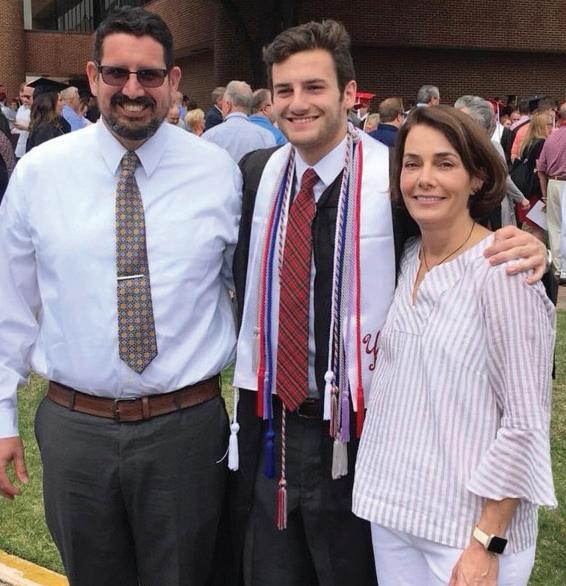
USA HEALTH MAGAZINE | VOL. 4, ISSUE 2 | 29
Kelly P. Roveda, M.D., Class of 1990 David Roveda, M.D., Class of 2019
David Roveda, M.D., had an uncom mon perspective as a medical student. During his four years of medical school, his mother, Kelly Roveda, M.D., served on the administration and pathology faculty at the Whiddon College of Medicine.
“During my time in school, she served as a great mentor both academically and professionally,” he said. “She was always someone who I could speak to freely about topics in the classroom or the hospital and expect helpful advice both from the stand point of a mother and another physician.”
Reflecting on her decision to attend the Whiddon College of Medicine, Kelly Roveda noted how the small class sizes nurtured a spirit of camaraderie and support. “What I found was not only a supportive environ ment provided by my classmates but out standing mentorship available to me from faculty, staff and administration,” she said.
In the late 1980s, Betsy Bennett, M.D. was vice chair of pathology and associate dean for student affairs. “I remember think ing, if I could model my professional life after anyone, it would be Dr. Bennett,” Kelly Roveda said. “Daily, she displayed excel lence in clinical medicine and excellence in teaching with professionalism, dignity and grace. Not only did she inspire me to desire a role in an academic institution but also she inspired my decision to pursue pathol
ogy as my professional vocation.”
While Kelly Roveda was content to analyze specimens in the laboratory as a pathologist, her son was more interested in working in the lab setting as a chemical en gineer. With no intention of pursuing med icine, David Roveda earned an engineering degree from the University of Alabama.
However, accompanying his mom to the Whiddon College of Medicine’s Match Day that year contributed to a change of heart.
“I remember seeing not only how suc cessful the graduating class was but also the genuine relationships they shared with both the clinical and basic science faculty,” he said. “This experience was one of many that cemented my decision to attend medi cal school at South Alabama.”
Kelly Roveda, who was named associate dean for student affairs in 2019, was able to witness her son’s milestone moments in medical school up close as he moved from one year to the next. During his White Coat Ceremony, she sat on the stage as he addressed the Class of 2019 as class president and then assisted him and his classmates in donning their white coats.
She was there for Match Day in 2019 when he announced he had matched in the highly competitive specialty of radi ation oncology, and for honors convoca tion when he addressed his classmates
as president for the final time. While she felt joy and pride in these moments as an administrator, she said, “first and foremost, I am a parent.”
Going into his fourth year of residency training at the University of Alabama at Birmingham, David Roveda is grateful to the Whiddon College of Medicine for preparing him to become a capable and patient-focused resident physician.
“Beyond the faculty at South Alabama, the residents in the respective departments also played a crucial role in our formation by allowing us to participate closely in patient care and have many one-on-one opportunities with them and the attend ings that may not be available at other institutions,” he said.
Looking back on his medical education, David Roveda said he felt part of a family environment from day one. “Dr. (Jonathan) Scammell mentioned to us during orienta tion that ‘your success is our success,’” he said. “That truly embodies the dedication the faculty and staff have to developing excellent physicians and excellent people.”
Kelly Roveda, M.D., embraces her son, David Roveda, M.D., during his White Coat Ceremony in June 2017.
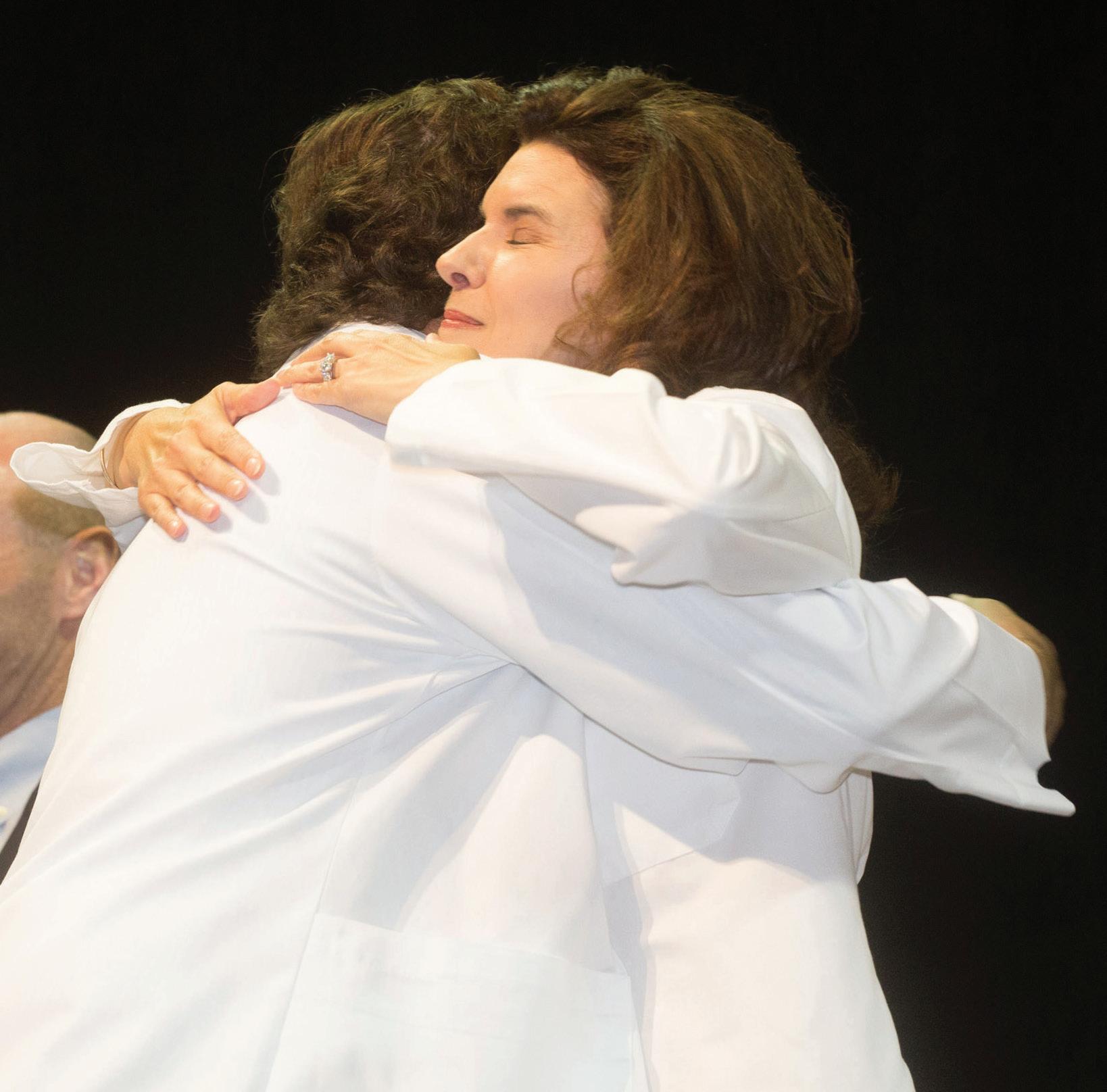
David Roveda, M.D., who served as class president, addresses the Class of 2019 at Honors Convocation in May 2019.
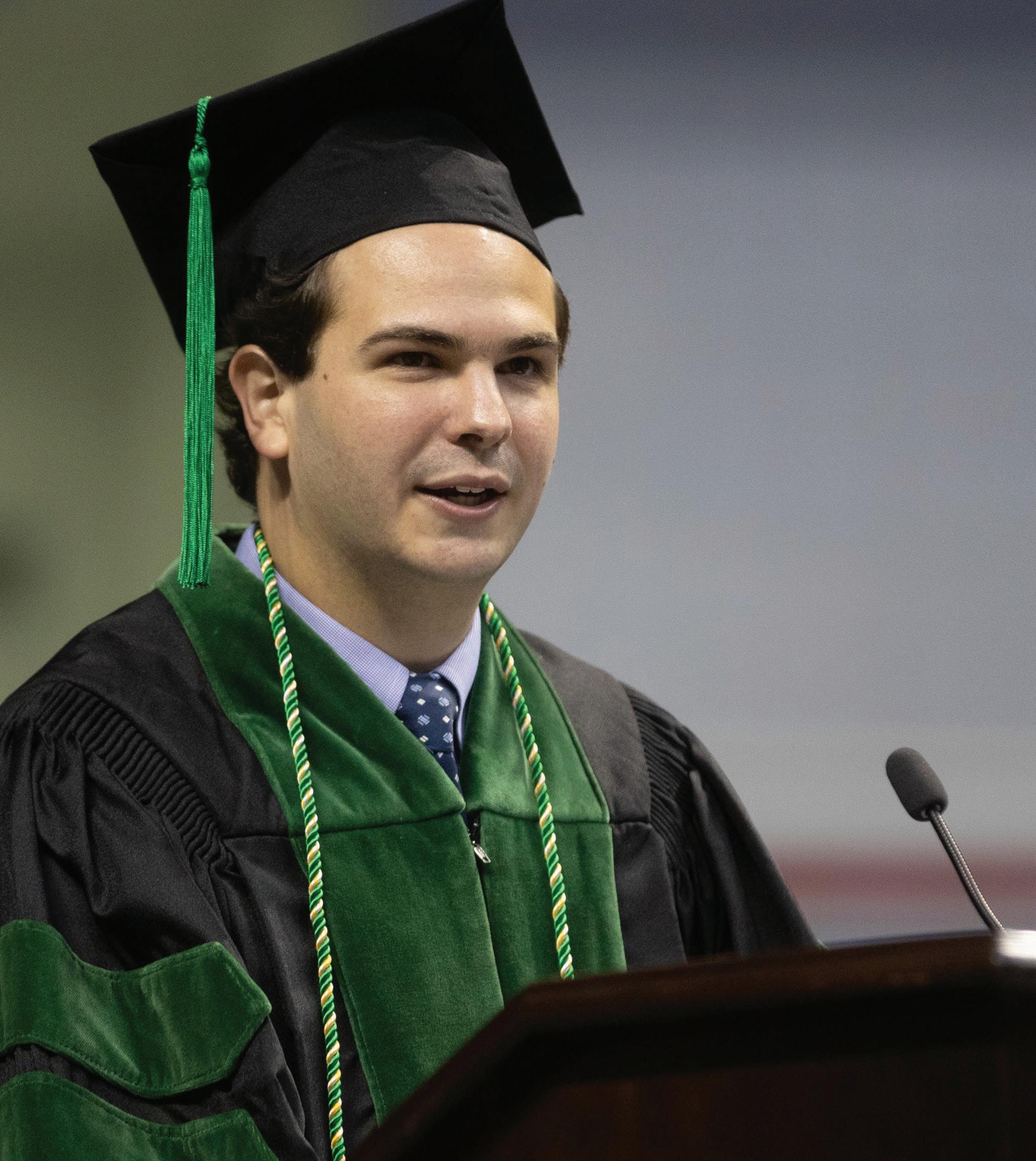
30 | USA HEALTH MAGAZINE | VOL. 4, ISSUE2
George Zaharias, M.D., and Nerrin Zaharias, M.D., Class of 1990 Rennan Zaharias, Class of 2023
As the daughter of two alumni, rising fourth-year medical student Rennan Zaharias grew up listening to stories about the Whiddon College of Medicine from both of her parents.
“They would tell me about the anatomy lab or how they sat next to each other on the first day of orientation,” she said of her father and mother, George and Nerrin Zaharias.
The pair became study partners and went on their first official date to the Whiddon College of Medicine’s Skit Night in 1987. “We are blessed and grateful to have met each other and to have formed such tight bonds as medical students at USA COM,” Nerrin Zaharias, M.D., said.
“The faculty at South had our best interests at heart and were very instrumental in our almost 32-year careers in our respective fields,” she continued. “Some of the impactful learning experiences involve studying with our friends with whom we have maintained close relationships.”
Although they weren’t engaged yet, Nerrin and George Zaharias went through the residency matching process as a couple their senior year of medical school. She matched in anesthesiology at the University of Alabama at Birmingham, and he matched in OB-GYN at Carraway Hospital in Birmingham. They became engaged on Christmas Eve of their internship year and married at the end of their internships.
This year, the couple, who still live and practice in the Birmingham area, celebrate their 31st wedding anniversary. They have three children.
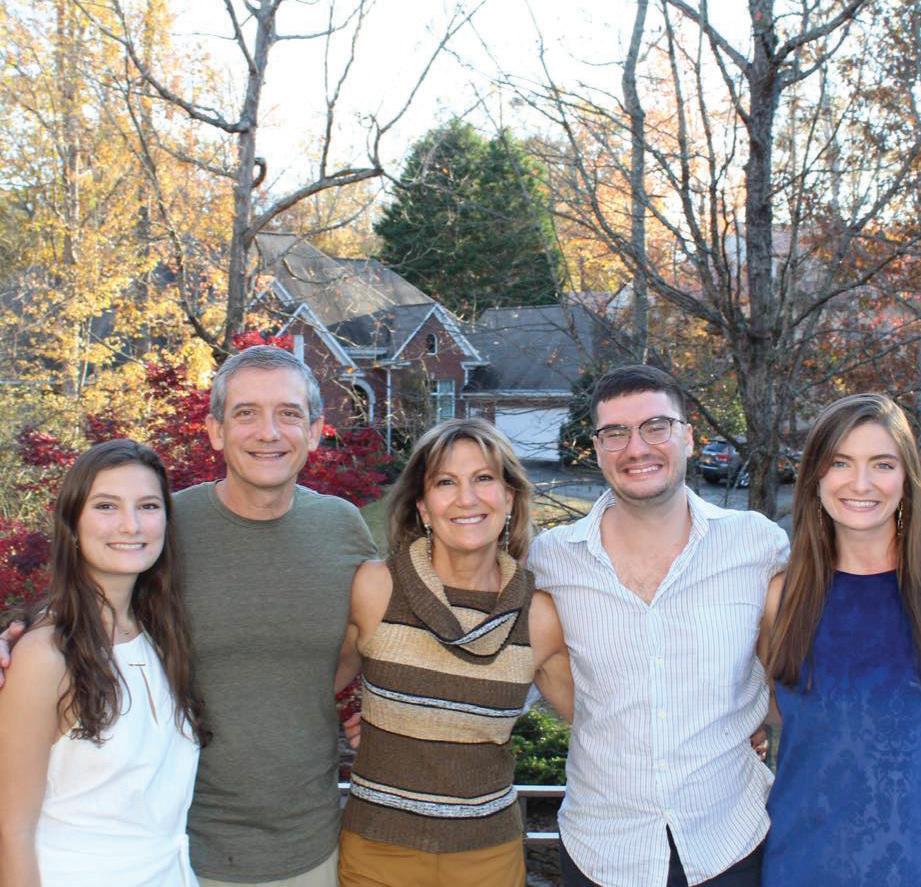
Their middle child, Rennan Zaharias, naturally veered toward medicine and didn’t need any persuading from her physician parents. “If I had come home from college one day and told them I wanted to pursue architecture, I have no doubt they would have supported me without question,” said Rennan, whose siblings are not in the medical field.
Rennan Zaharias has cherished her time as a student at the Whiddon College of Medicine. “I think the community that we have as a medical school is incredible,” she said. “We are surrounded by people who want to see us succeed and want to help us get there. I feel so honored to be a part of USA COM. I look around at my classmates and how brilliant, kind and driven they are, and I can’t believe it’s a group of people I get to be a part of.”
With plans to pursue obstetrics and gynecology like her dad, Rennan Zaharias is involved with the American Medical Women’s Association and the OB-GYN Interest Group. She organizes an annual feminine hygiene product drive to benefit women and girls at local shelters Penelope House and McKemie Place.
Nerrin Zaharias, whose mother also is an anesthesiologist, quipped that she should have steered her daughter toward the specialty, so the family would have three gen erations of female anesthesiologists. Joking aside, she is pleased that her daughter is right where she needs to be.
“We are so proud of our daughter Rennan as she finishes her third year of medical school, and we love to visit her and watch her enthusiasm,” Nerrin Zaharias said. “It is so gratifying to feel that we have completed a full circle.”
Nerrin Zaharias. M.D., and George Zaharias, M.D., celebrate their wedding with family and friends in 1991.

The couple enjoy the holidays with their three children. Nerrin Zaharias, M.D., shares the stage with her daughter, Rennan Zaharias, at the Class of 2023’s White Coat Ceremony in June 2021.
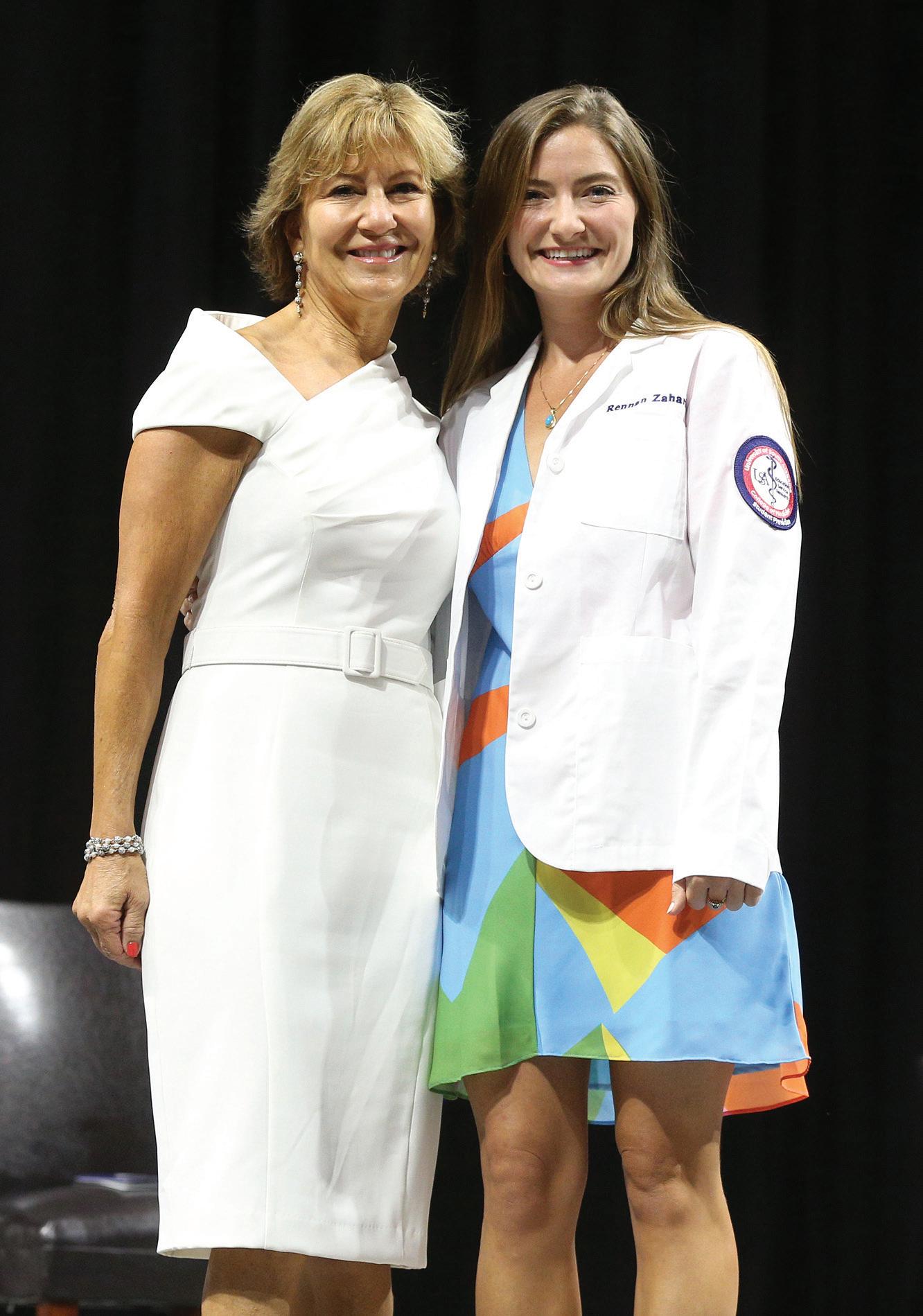
USA HEALTH MAGAZINE | VOL. 4, ISSUE 2 | 31
Gift provides advanced breast cancer screening
 BY CAROL MCPHAIL
BY CAROL MCPHAIL
32 | USA HEALTH MAGAZINE | VOL. 4, ISSUE2
Aboutfour years ago, Beth Rabren of Fairhope received what she thought was good news. A letter said that her mammogram and ultrasound results were back and indicated that she wouldn’t need to get screened for breast cancer for another year.
“I was thrilled because that just meant there was nothing wrong,” said Rabren, who has a family history of breast cancer and a personal history of pre-cancers.
Then, one of her doctors read the report and reversed the recommendation, citing her medical history. The doctor recom mended an MRI for more imaging and a needle biopsy. Soon, Rabren heard the news that she had dreaded most of her life, having witnessed family members die from breast cancer. “I got a call two weeks later from the surgeon saying that I had breast cancer,” she said.
Rabren was referred to USA Health, where she underwent a lumpectomy to re move the cancer, located near the surface of her left breast. It had not spread to her lymph nodes. The pathology report also showed that the tumor was hormone pos itive, meaning that it likely would respond to hormone therapy to block the growth of cancer cells.
“We all have similar reactions when we hear the word ‘cancer,’ whatever kind it is, whatever stage of life we’re in,” she said. “The first reaction, of course, is fear. But then the more knowledge you have, and the more care you are given and the more capable, calm and confident the doctors and technologists are, it allays those fears.”
The early diagnosis allowed Rabren to avoid chemotherapy and its side effects. Still, she needed several weeks of radiation therapy, which she received just a few min utes down the road at the Mitchell Cancer Institute in Fairhope. Having an academic cancer center located 15 minutes from her home made it convenient for her to receive treatment daily Monday through Friday.
“I was blessed to have it caught early, thanks to some people paying attention,” she said. “And I was blessed to have had minimally invasive surgery.”
She also felt well enough to continue with most of her daily activities. “I did not miss a day of working out during radiation. It was just part of my daily routine,” said Rabren, who had retired from her job as a mental health therapist. “Going to the gym helped me to feel good about getting up
and having a schedule.”
Rabren says that she will continue to be monitored closely. She and her adult daughter also underwent testing to deter mine whether they had a genetic mutation that is linked to cancer. Fortunately, they did not.
During her treatment, there was one moment in particular that caused her to catch her breath.
Her mother had died of pancreatic and liver cancer at age 54. When the MCI was constructing its new Fairhope location, Rabren took the opportunity to make a special donation to honor her mother. A plaque was affixed outside an exam room that read: “In Memory of Martha Frances Chapman. Miss you, Mom.”
After her own diagnosis, Rabren arrived for an appointment with her oncologist, Dan Cameron, M.D., and was ushered into that very room. “I never saw that com ing when I donated the money. I never thought, ‘I’m going to be in this room,’” she said. “It was totally full circle.”
Seeking to help other women in the same situation, Rabren decided to give back. She chose to donate $242,000 to ensure that USA Health had the most ad vanced imaging available to detect breast cancer early.
As a result of Rabren’s generous dona tion, USA Health now offers whole breast imaging using the Invenia automated breast ultrasound (ABUS) at Children’s & Women’s Hospital Breast Center, located at the Strada Patient Care Center.
“As a grateful patient, Beth recognized a need to bring in this state-of-the-art tech nology to enhance patient care,” said Kelly McCarron, associate vice president for medical affairs, health development. “We appreciate her generosity and are grateful for the impact it will have on our patients for years to come.”
A mammogram uses a low dose of radiation to take one or more images of the breast as the breast tissue is compressed between two plates. An ultrasound uses high-frequency sound waves and converts them into an image. In the case of the
ABUS, a curved device fits over the breast when the patient is lying down and, in a few seconds, generates an ultrasound image of the breast.
“The ABUS is generally used as an ad junct to screening, mostly in patients with dense breast tissue and/or with increased risk for cancer as determined by several factors such as personal or family medical history,” said Elizabeth Park, M.D., a radiol ogist at USA Health. “For some patients at high risk or with very dense breast tissue, having an additional screening modality such as this ABUS is helpful in detecting early cancers.”
It’s estimated that four out of 10 women in the U.S. have dense breast tissue, which can mask the appearance of tumors and limit the performance of mammography. Using an advanced imaging algorithm, ABUS technology can improve breast can cer detection by 35.7% over mammography alone.
In Rabren’s case, physicians recommend ed mammograms along with magnetic resonance imaging (MRI), which requires intravenous contrast to be injected into a vein. The ABUS is different from an MRI in that it can be conducted more easily and quickly and does not require IV contrast. Physicians say that more than one type of imaging can be used together in high-risk patients.
Rabren has this advice for women who may be considering delaying screening. “Any diagnostic test your doctor suggests, don’t skip it. Don’t put it off. Don’t delay,” she said.
Now four years past her treatment, Rabren stays busy with post-COVID travel and projects at home with her husband. She doesn’t dwell on her breast cancer journey. “I really don’t think back on that experience very often,” she said. “And when I do, it’s with gratitude, because it was caught early.”
Opposite: Beth Rabren, a breast cancer survivor, enjoys time with her daughter and grandchildren at her home in Fairhope.
USA HEALTH MAGAZINE | VOL. 4, ISSUE 2 | 33
FEATURE
Visit usahealthsystem.com/grateful to make a gift in honor of a care team member.
Coast Guard member now living pain free after treatment at USA Health Spine Institute
 BY SHELBEY ERNEST
BY SHELBEY ERNEST
Daniel Childs woke up on April 13, 2021, in excruciating pain. It started behind his right eye and radiated down his arm. He quick ly realized he couldn’t turn his head from side to side. His right hand was numb.
“I just assumed it was a pinched nerve and would go away on its own,” said Childs, a petty officer first class in the U.S. Coast Guard. “I was having to do the ‘Batman look’ because I physically couldn’t turn my head. It took me turning my shoulders to be able to see to the left and right of me.”
Childs has served a total of 25 years in the U.S. Marine Corps and Coast Guard, including the past 12 years as a precision marksman instructor with the Coast Guard. He knew his job was taking a toll on his body, but he didn’t realize how much.
After six months of physical therapy with a Coast Guard flight surgeon, Childs still was experiencing intense pain and had no grip strength or feeling in his right hand. He was unable to hug his wife or pick up his dogs without feeling tremendous pain shoot down his neck and arm. He knew something had to be done.
Childs began researching the USA Health Spine Institute after having a conversation with a fellow Coast Guard member who had similar symptoms and pain.
“He told me he had surgery with the Spine Institute and was able to start back flying in just seven months,” Childs said of his colleague. “While going back to flying wasn’t the driving force behind why I want ed to find relief, being fit for full duty was. I
couldn’t keep living with this pain.”
From the moment he met the Spine Institute team, he knew he was making the right decision.
“They didn’t use a bunch of medical lingo that didn’t translate to me,” Childs said. “They broke everything down to help me understand what caused this, what could be done about it and what to expect. The process was so quick and simple with the Spine Institute.”
Richard Menger, M.D., M.P.A., director of the USA Health Spine Institute and chief of complex spine surgery at USA Health, took one look at Childs and knew exactly what was wrong.
“The way he turned to look at me when I walked into the exam room gave it away,” Menger said. “We knew immediately he had a disc herniation in his neck pushing on the nerve that went to his right arm.”
The traditional surgical treatment is a fu sion surgery in which two bones are fused together after removing the disc hernia tion. However, for an active and fit young male, Menger was able to offer a new procedure: an artificial disc replacement.
This procedure is only performed by a select few neurosurgeons in the region. With an artificial disc replacement, sur geons place a new shock absorber into the disc space. Menger was certain this was the solution Childs needed to alleviate his pain and reduce the chance of needing any
future surgery and increase his mobility. Childs said Menger’s confidence made him feel sure of his decision.
Childs went in for surgery on April 1, 2022, almost a year after his pain started. The very next day, he was able to leave the hospital and go home, thanks to the use of a national guidelines-based program, En hanced Recovery After Surgery (ERAS). The ERAS program reduces opioid consump tion and decreases the length of a hospital stay for patients.
“My results from surgery were better than I could have ever imagined,” Childs said 10 weeks post-surgery. “I was hoping to be fairly pain free and have some range of motion back in my head and neck. What I got was no pain, almost 100% range of motion in my head and neck, and the use of my right hand back.”
For the Coast Guard, one of the most respected ways to thank someone is to give that person a patch from your unit. From the clinic to the operating room, Childs made sure each USA Health staff member who had a hand in his care received his unit patch as a token of appreciation for all they had done to help him.
“In aviation, people see just the pilot. In surgery, people see the surgeon, but it takes an entire team to deliver care like this,” Menger said. “The Spine Institute and the staff in the operating room were thankful for the recognition.”
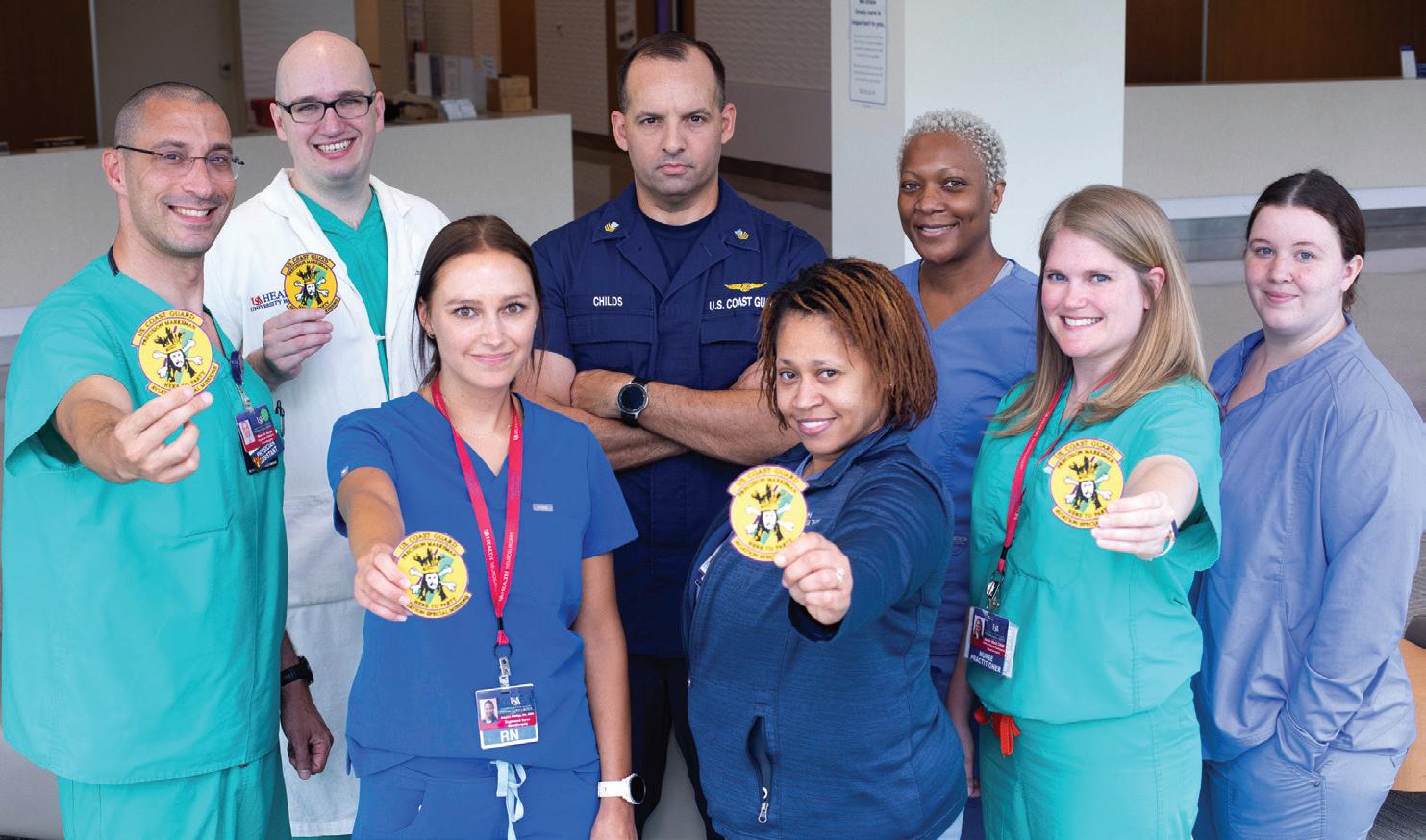
USA HEALTH MAGAZINE | VOL. 4, ISSUE 2 | 35
FEATURE
Staff members from the USA Health Spine Institute display the patches they received from patient Daniel Childs, center. Childs, a member of the U.S. Coast Guard, gave each of them a patch from his unit as a token of his appreciation.
“
I was hoping to be fairly pain free and have some range of motion back in my head and neck. What I got was no pain, almost 100% range of motion in my head and neck, and the use of my right hand back.
- Daniel Childs ”
Volunteers provide needed care during outreach campaign in Peru
USA Health volunteers traveled in March to Peru, where they provided healthcare and vaccines to residents while strength ening educational ties for future trips with medical students and residents.


One of the volunteers, Danny Rickert, chief policy officer for USA Health, said he had looked forward to this outreach for almost a year. Originally planned for 2021, the trip was postponed because of the rise of the Delta variant along the Gulf Coast and surrounding communities.
Peru has one of the world’s highest COVID-19 death rates per capita, exceed ing 590 deaths per 100,000 people.
The success USA Health demonstrated in delivering COVID-19 vaccines to large numbers of people drew attention from
CerviCusco, a nonprofit organization in Peru internationally recognized for its HPV vaccination program. During the trip, USA Health partnered with the organization to provide care for children at Azul Wasi, an orphanage near Cusco, Peru, as well as residents of communities in and around the city.
Rickert said the original goal was to set up mass vaccination sites for Cusco and the surrounding areas using the template USA Health set up at the Mobile Civic Center. “We didn’t stop at vaccinations,” he said. “Seeing the need for more services, we split into groups and administered medical care to adults and children. We even were able to have a consultation with Dr. Ben jamin Estrada, who was over 3,000 miles
away back in Mobile.”
The trip also presented future opportuni ties for medical students, physiciansin-training, and students in nursing and physician assistant studies.
“We built a partnership with CerviCusco that will allow us to enhance the educa tion of our students and residents,” Rickert said. “This partnership has the potential to expand the research and education of our students, as they will be able to have a global healthcare experience that will truly open their eyes to healthcare around the world.”
Volunteers from USA Health care for children living at Azul Wasi, an orphanage in Cusco, Peru, and other residents in the community.
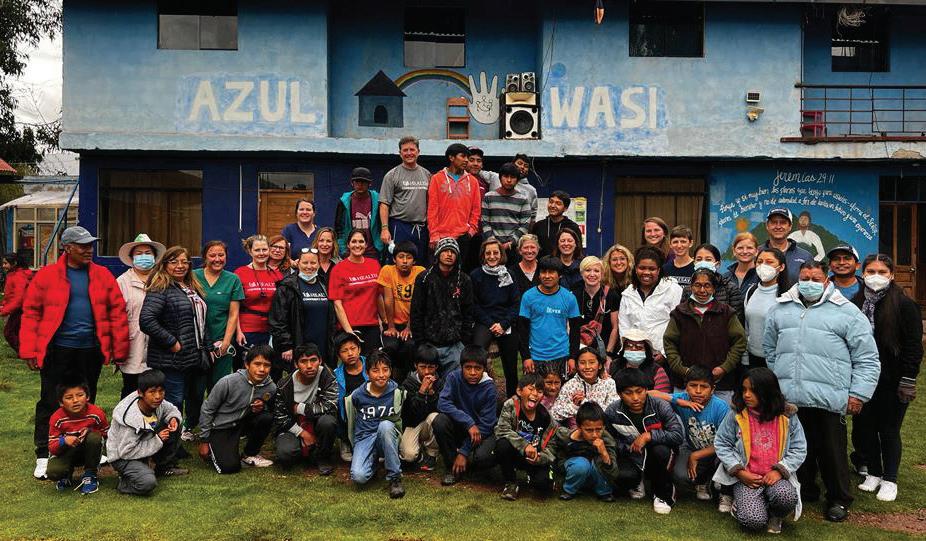
36 | USA HEALTH MAGAZINE | VOL. 4, ISSUE2
OUTREACH
Community Health Workers help patients navigate health and social services
The USA Center for Healthy Communities is collaborating with the Mobile County Health Department to implement the Com munity Health Workers (CHW) program aimed at helping patients in underserved areas of the city navigate the health and social services available to them.
Funded by a grant from the Centers for Disease Control and Prevention, CHWs are trained public health workers who serve as a bridge between communities, healthcare systems and state health departments.
Antonette Francis-Shearer, Ph.D., M.H.F.A., health education manager at the USA Center for Healthy Communities, manages the Community Health Workers program. “This trusting relationship enables the worker to serve as a liaison between health and social services and the com munity to facilitate access to services and improve the quality of health outcomes and cultural competence in health service delivery,” she said.
The USA Center for Healthy Communities is piloting the Community Health Workers clinical integration model at USA Health Stanton Road Clinic. The CHWs work along side the clinic’s administrative team and
have a close understanding of the commu nity served.
“The incorporation of the CHWs into our clinic helps to further address the barriers and determinants of health in the environ ments of our patients,” said Katherine Street, L.M.S.W., the medical social worker at Stan ton Road Clinic. These barriers can include
lack of transportation, lack of finances or poor housing.
Community members or partners who want to connect with the Community Health Workers or to facilitate a client refer ral may contact the USA Center for Healthy Communities at 251-415-8737 or chws@ southalabama.edu.
Student-Run Free Clinic reopens to public, offers HIV services
After the pandemic prompted its closure over two years ago, the Uni versity of South Alabama Student-Run Free Clinic (USA SRFC) reopened to the public on March 11, 2022.
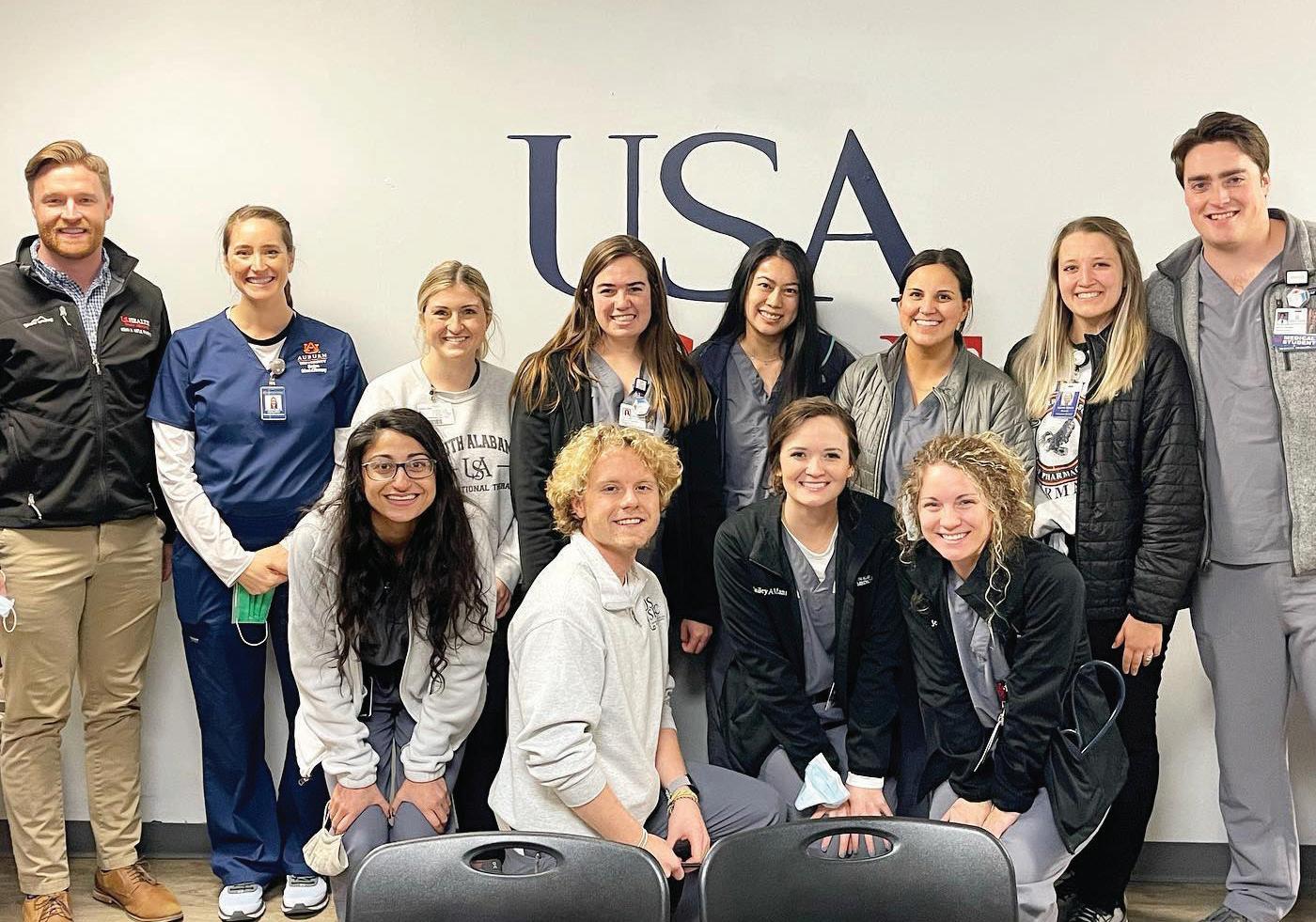
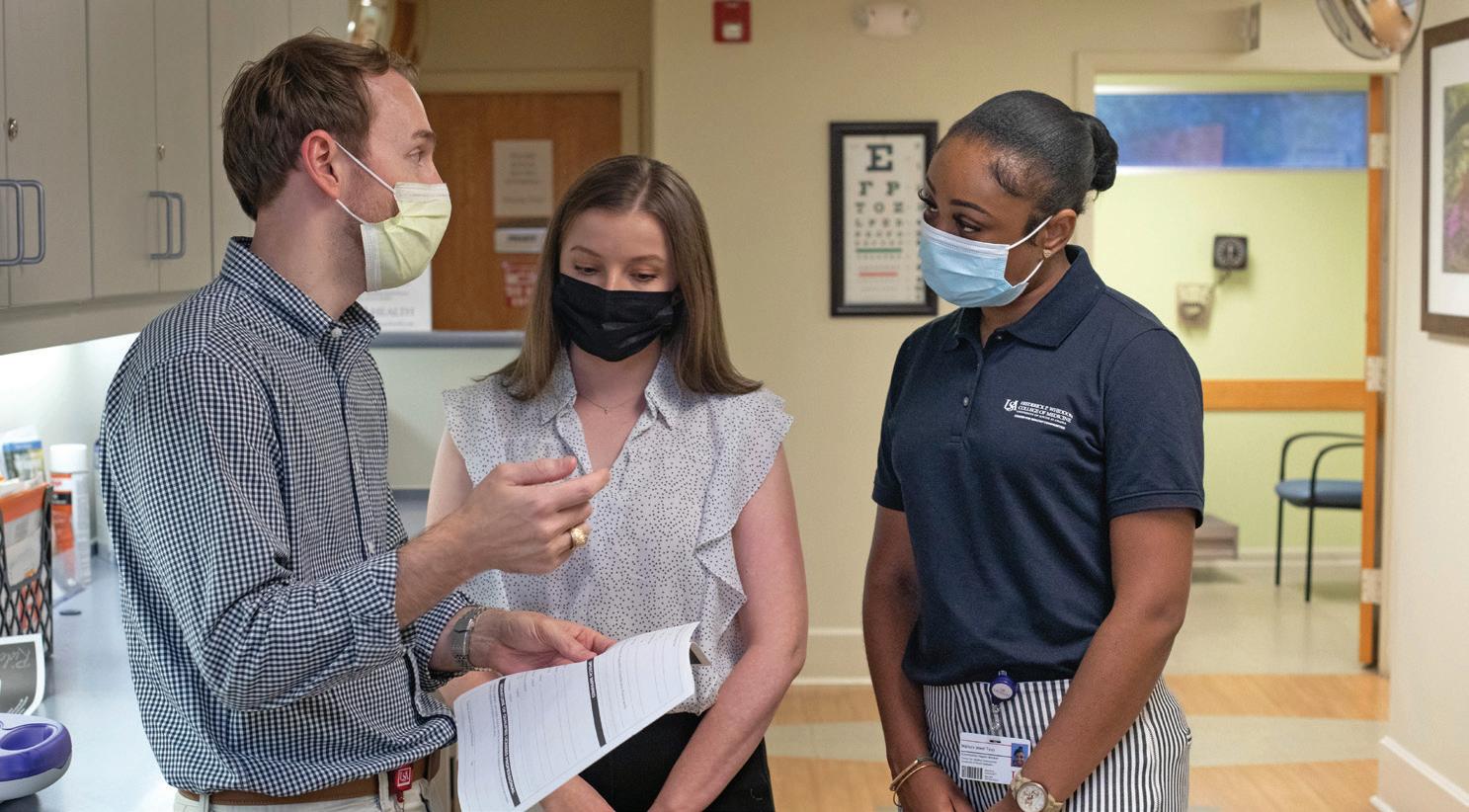
The USA SRFC is a student-led initiative that provides free medical checkups and healthcare services to Mobile’s homeless and underserved populations. This allows medical, nursing and allied health students to gain hands-on experience in a clinic setting while helping to meet the healthcare needs of those who might not receive care otherwise.
On April 1, 2022, the USA SRFC expanded its services. Through a part nership with AIDS Alabama South, the clinic offers free testing for HIV and hepatitis C as well as HIV prevention and treatment.
Last year, the clinic only opened to individuals in The Salvation Army’s residential treatment program. In addition to medical care, the SRFC provided patient education on topics such as hygiene, stress manage ment and mindfulness. Despite limitations imposed by the pandemic, the clinic had 122 volunteers, treated 291 patients, and received $1,000 in donations in 2021.
The USA SRFC is located at The Salvation Army, 1009 Dauphin St., and is open on Fridays from 2:30 to 5 p.m.
USA HEALTH MAGAZINE | VOL. 4, ISSUE 2 | 37
Members of the USA Student-Run Free Clinic executive board prepare the clinic to open during the spring semester.
Randall Trammell, D.O., left, medical director of the USA Health Stanton Road Clinic, talks with the clinic’s social worker Katherine Street and Community Health Worker Mallory Tyus.
Doc Rock raises more than $45,000 for USA Health


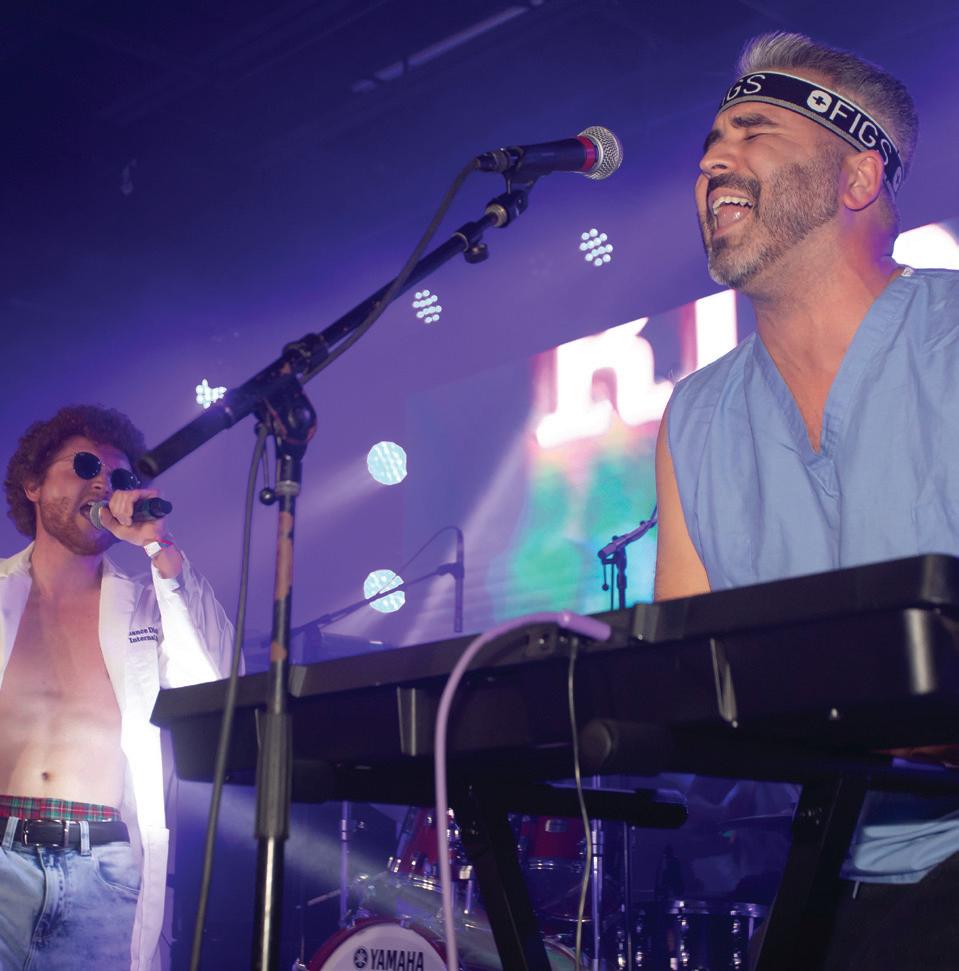



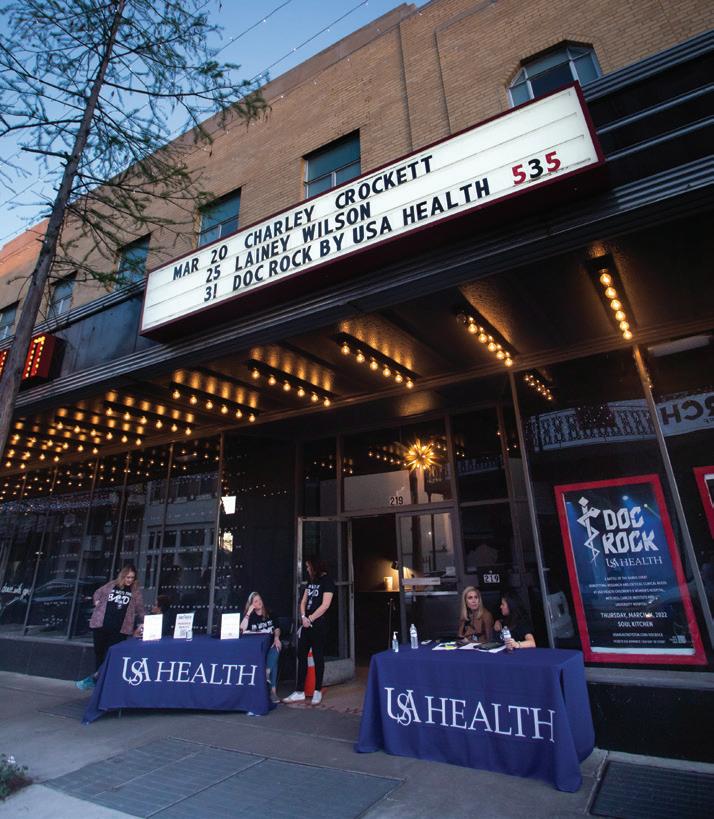
38 | USA HEALTH MAGAZINE | VOL. 4, ISSUE2
More than 500 fans attended the inaugural Doc Rock fundraiser on March 31 at the Soul Kitchen in downtown Mobile. The battle-of-the-bands-style event raised more than $45,000 for research and critical patient needs at Children’s & Women’s Hospital, University Hospital and the Mitchell Cancer Institute.
Frederick P. Whiddon College of Medicine holds 2022 Academic Hooding Ceremony
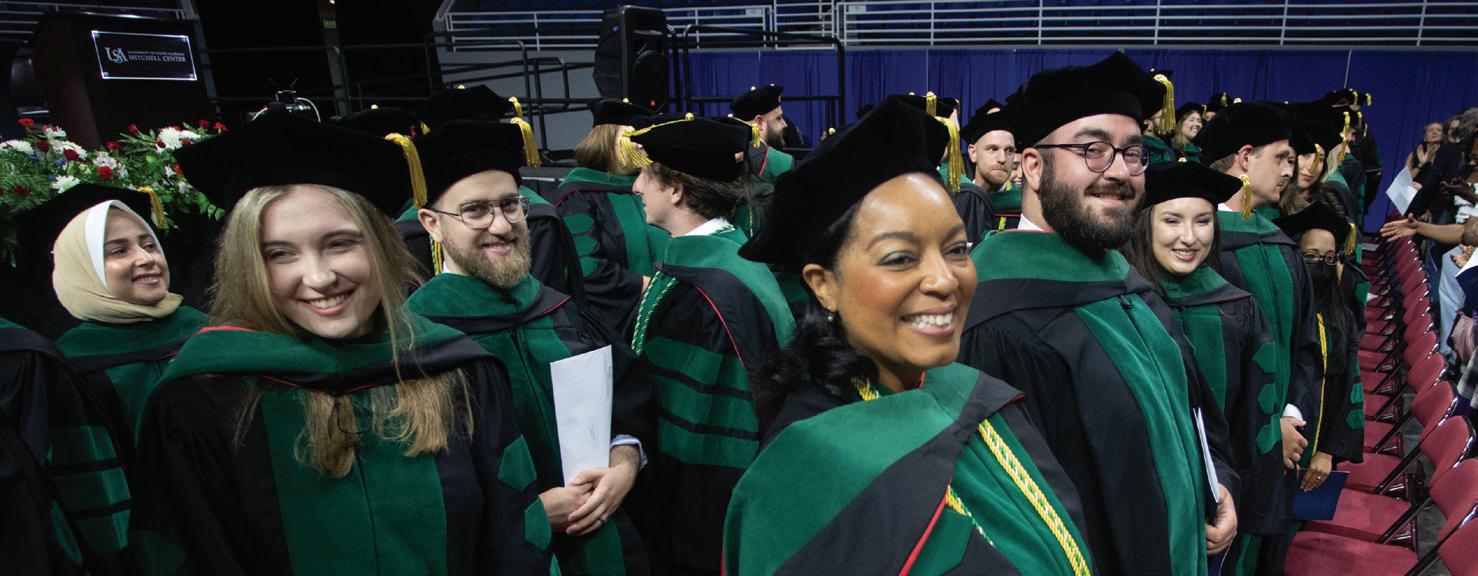

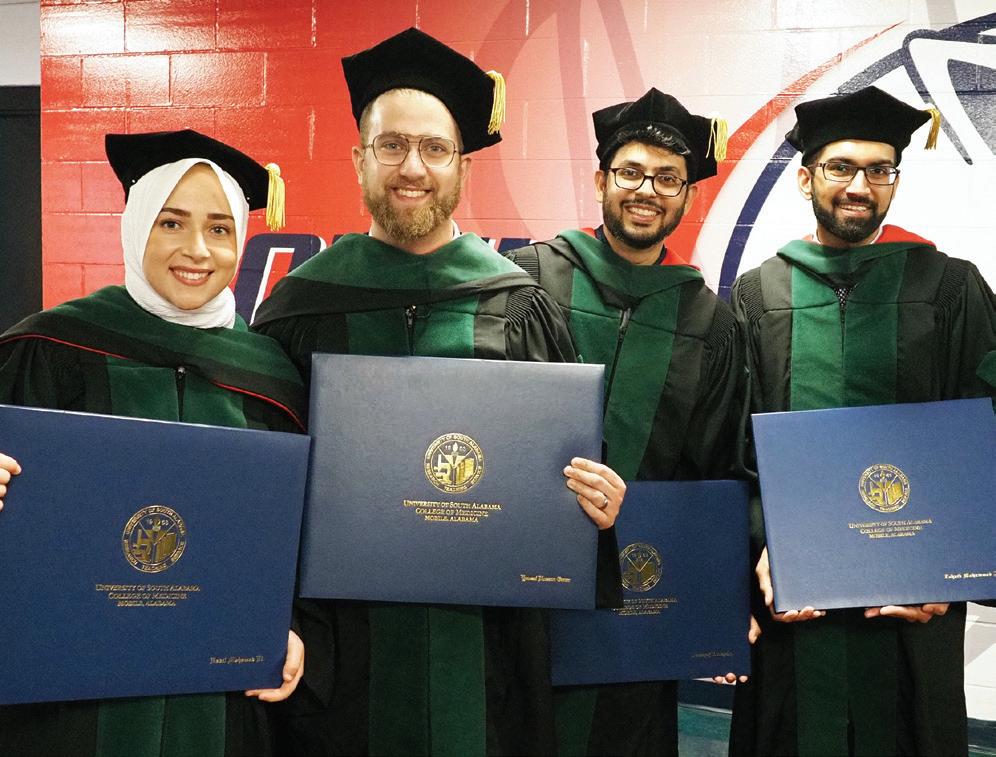
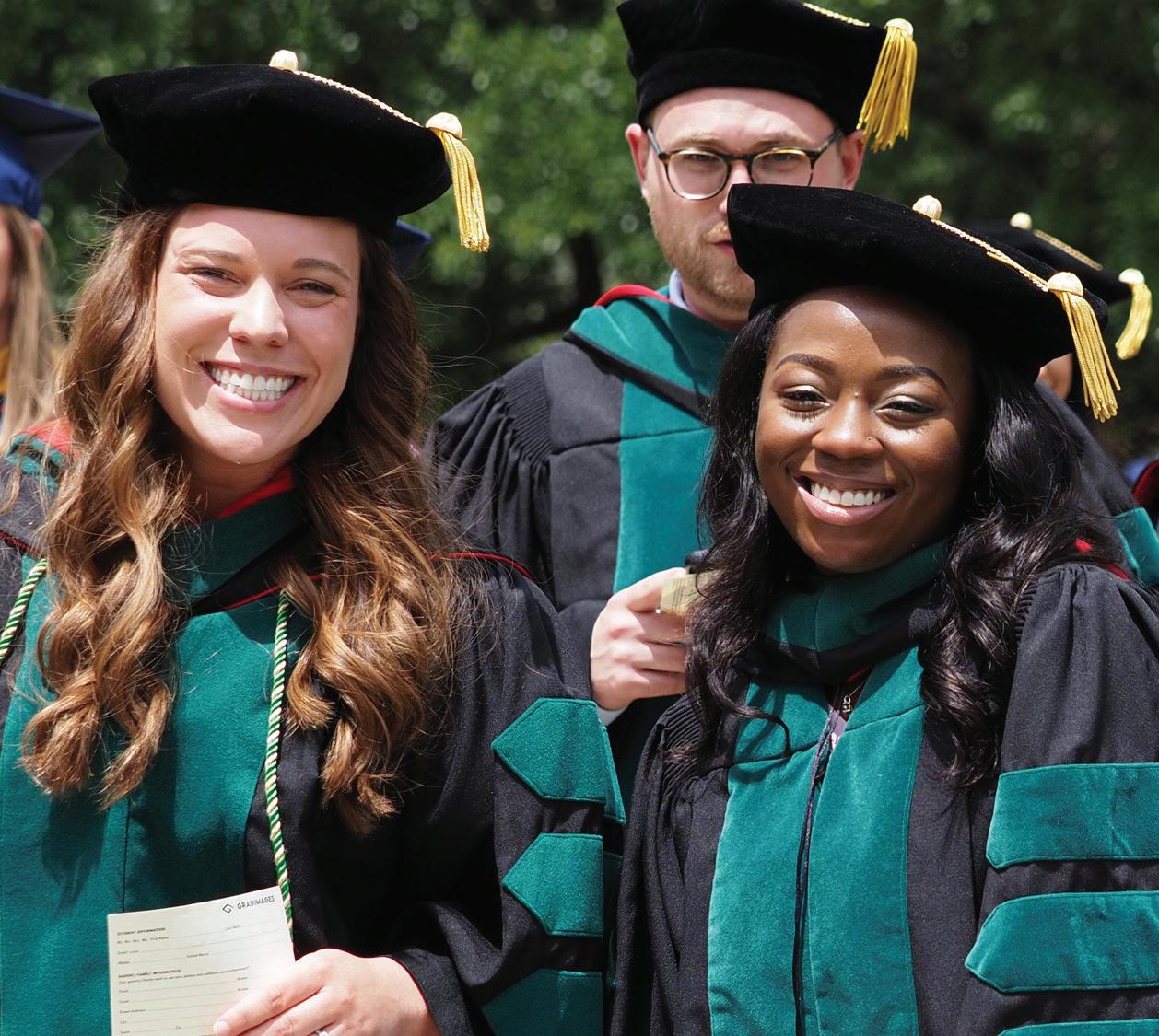

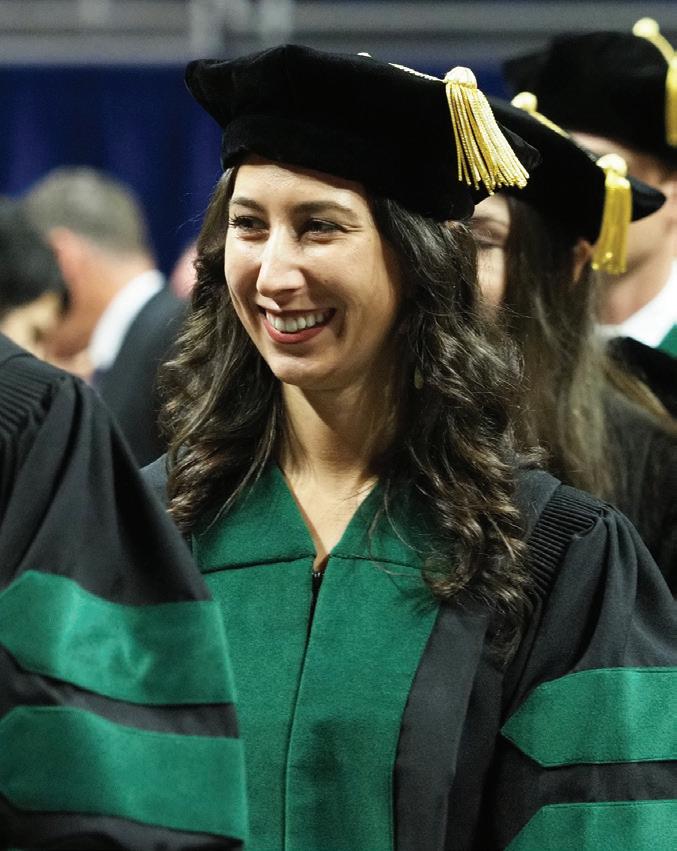
The Frederick P. Whiddon College of Medicine held its 2022 Academic Hooding Ceremony on Thursday, May 5, at the Mitchell Center. Seventy-six medical students took the Hippocratic Oath and were hooded by a person of their choosing. Those with a military affiliation took the military oath of office and received their new rank. Two graduating doctoral students in basic medical sciences were awarded doctoral hoods by their major professors.
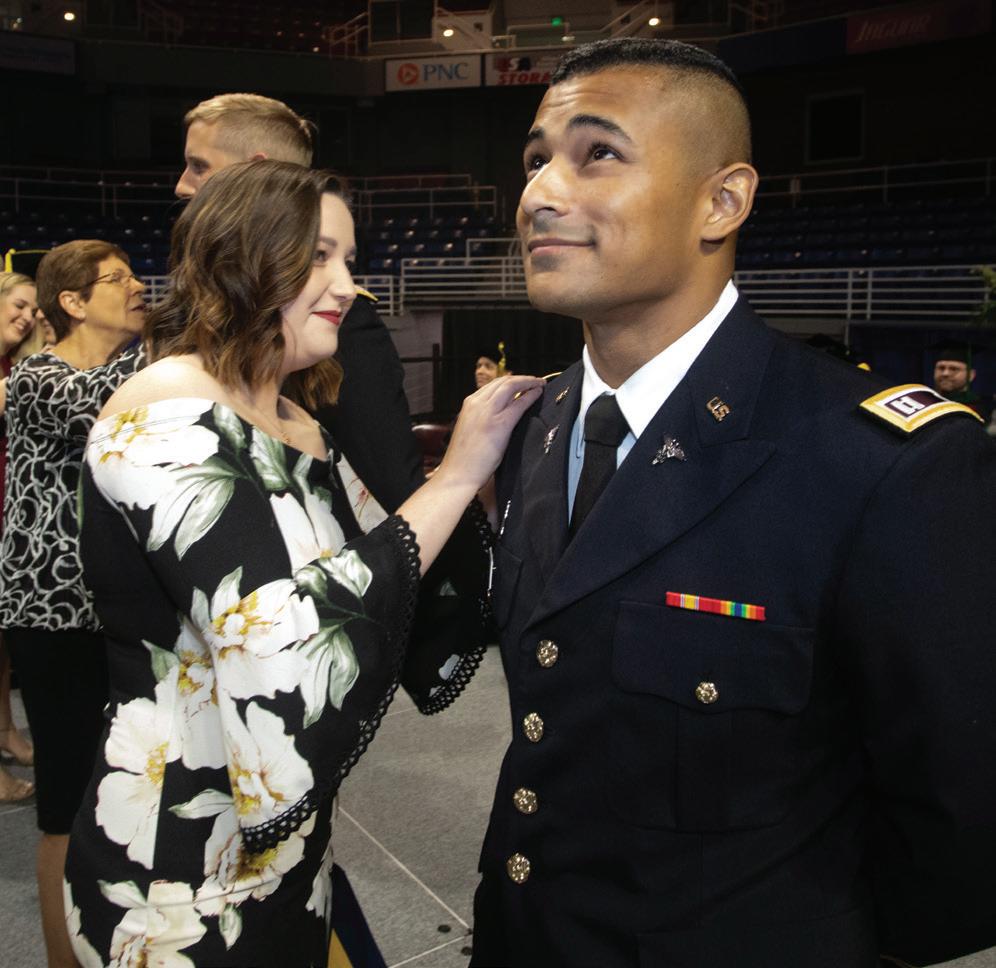
USA HEALTH MAGAZINE | VOL. 4, ISSUE 2 | 39
White Coat Ceremony marks transition for Class of 2024



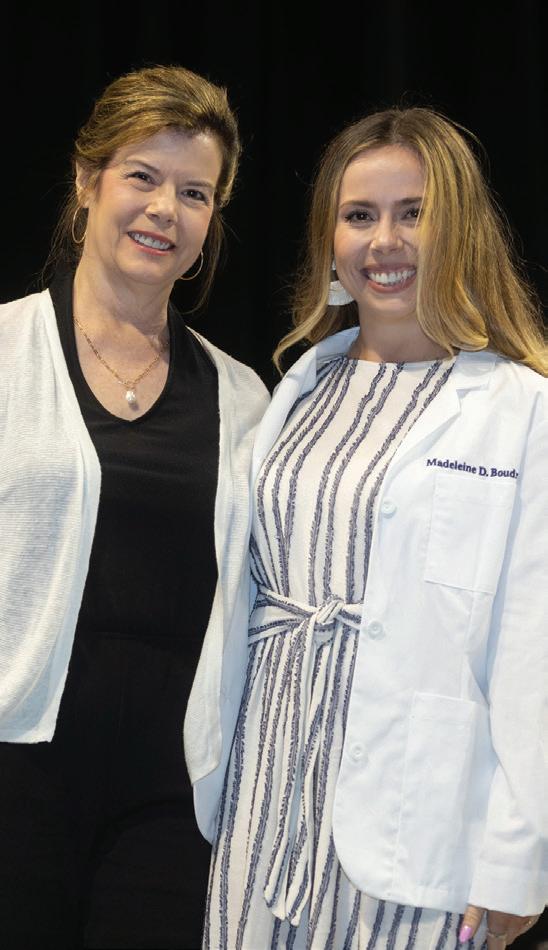
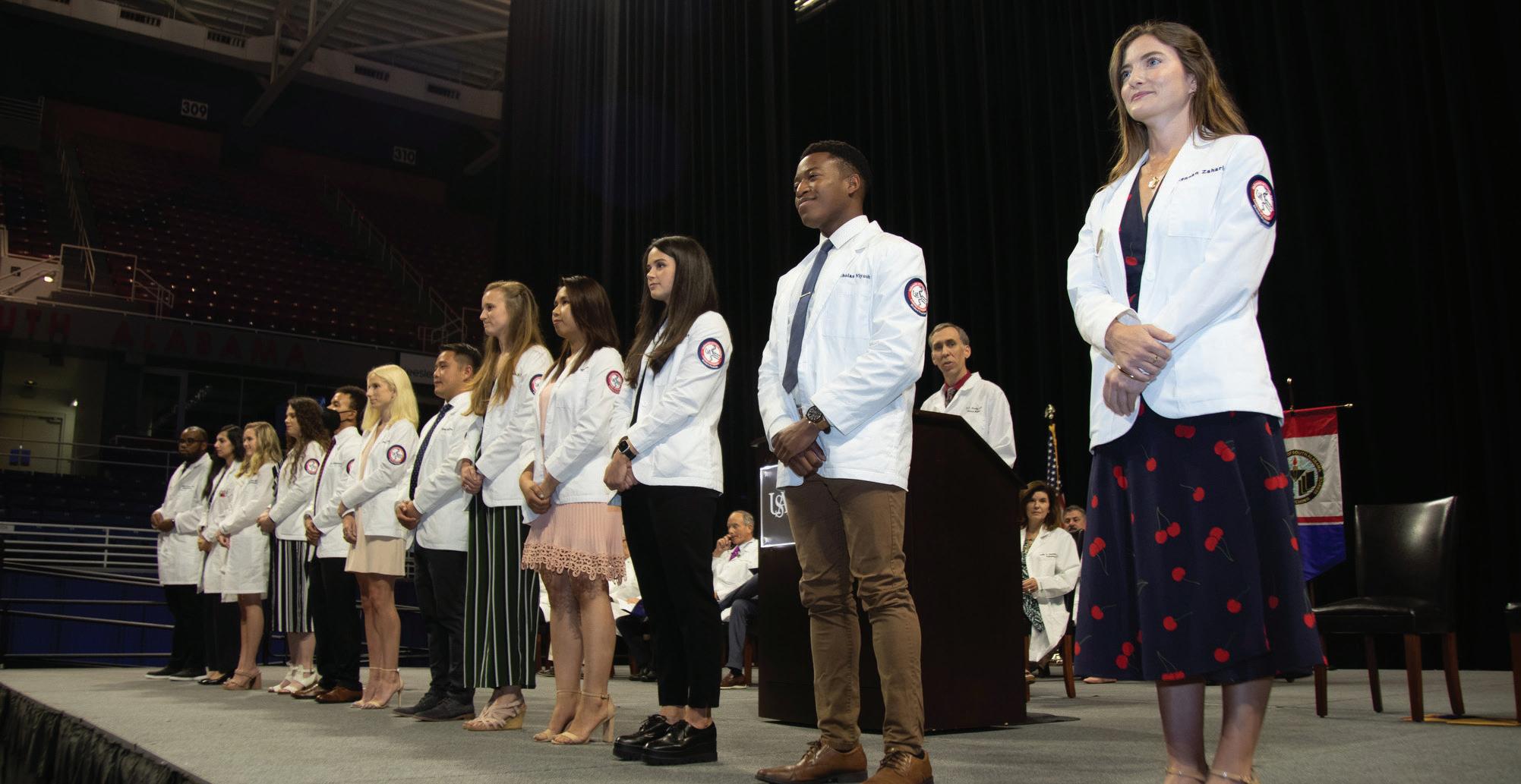

Members of the Class of 2024 were cloaked with white coats and took the Medical Student Oath in a ceremony on June 16, marking the transition into their clinical training. During the ceremony, senior medical students, residents and faculty were inducted into the USA Chapter of the Arnold P. Gold Humanism in Medicine Honor Society.
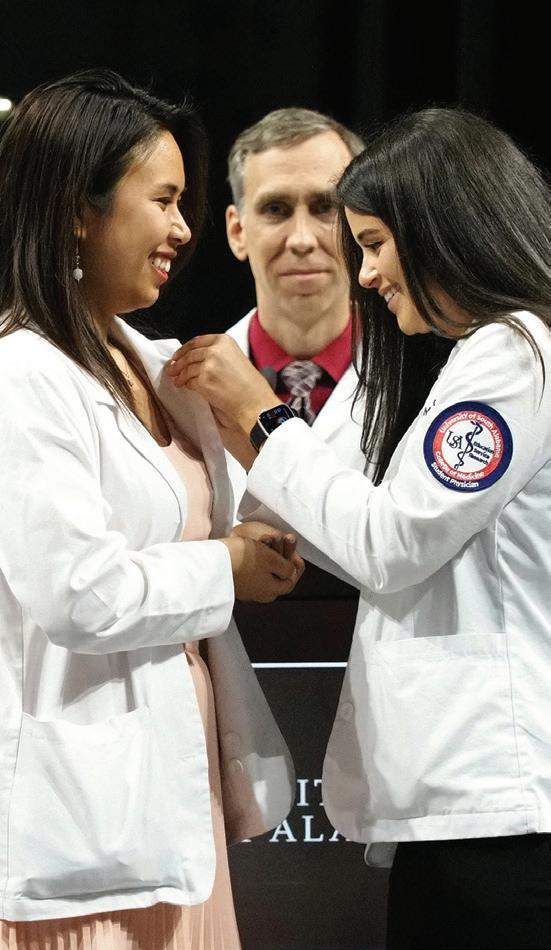
40 | USA HEALTH MAGAZINE | VOL. 4, ISSUE2
USA Medical Alumni Association hosts reunion weekend
Alumni and their families come together for the 2022 USA Medical Alumni Association Reunion, held June 10-12 at the Grand Hotel Golf Resort & Spa in Point Clear. Activities included an All Class Celebration at The Hope Farm in Fairhope.

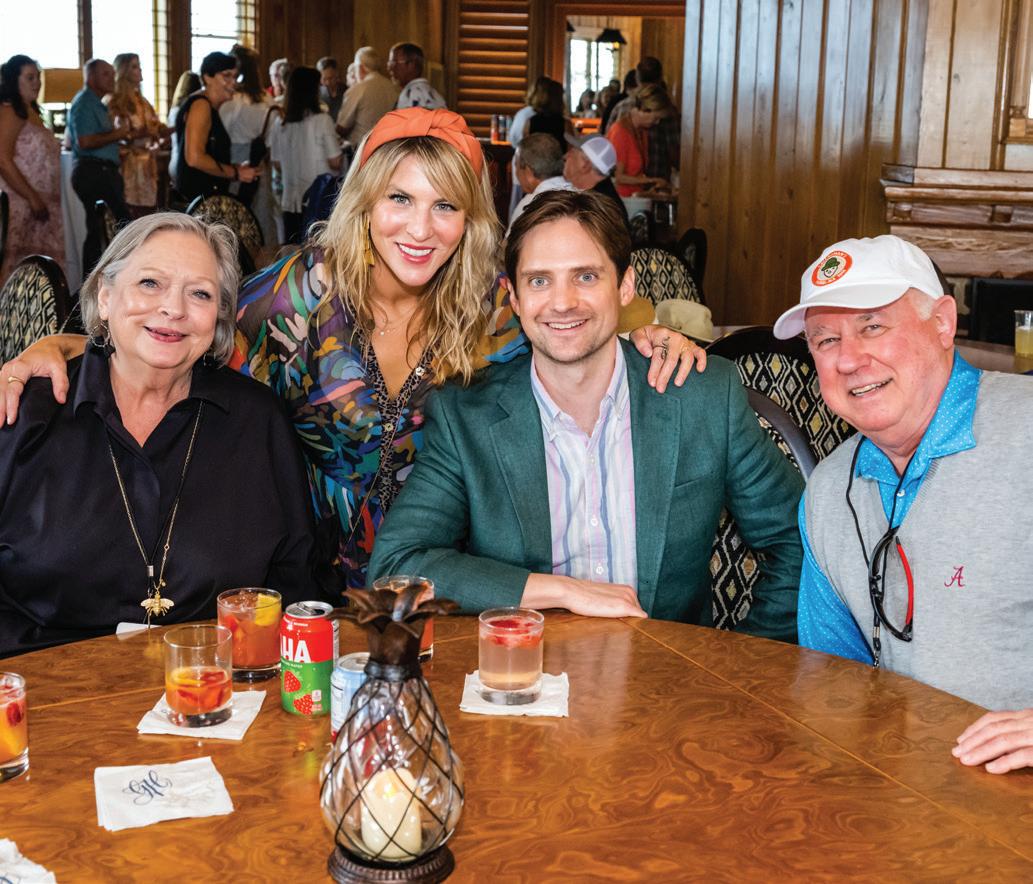

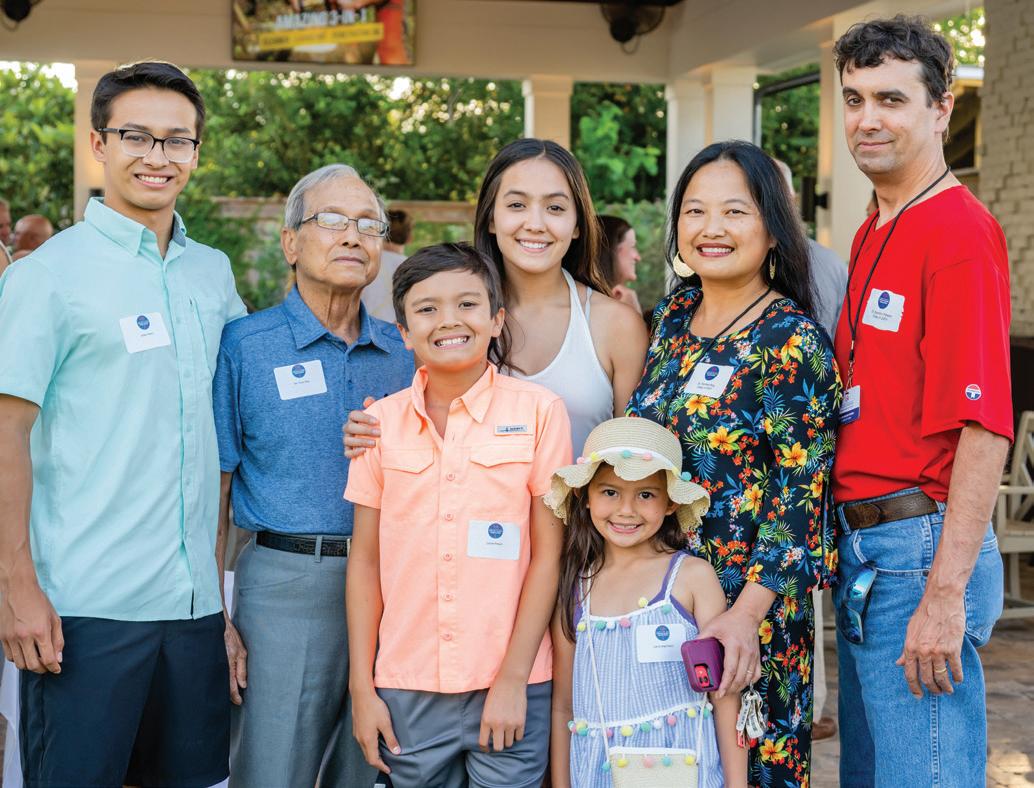
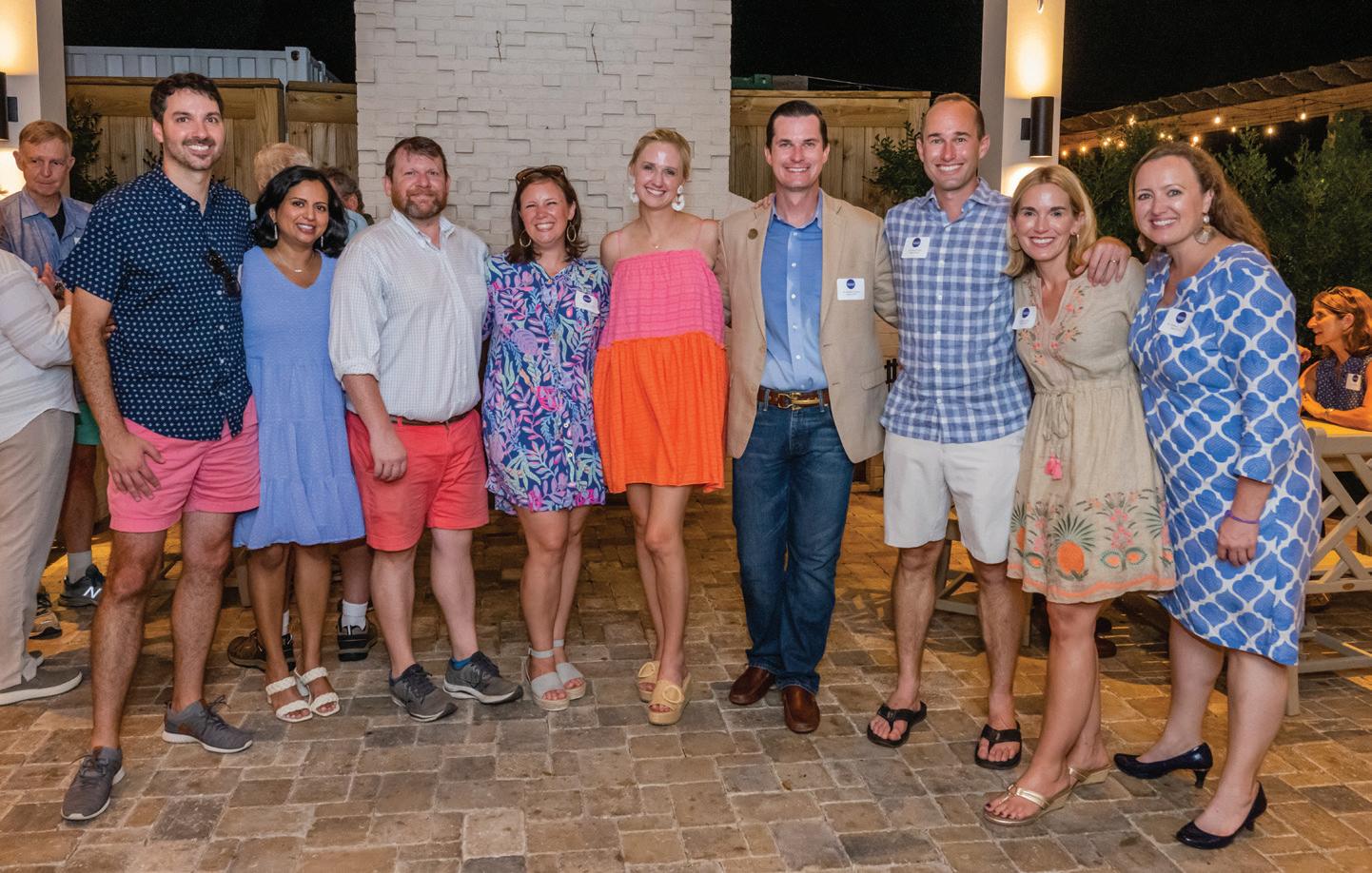

Save the date: The 50th anniversary celebration of the Whiddon College of Medicine is set for June 9-11, 2023, at the Grand Hotel.

USA HEALTH MAGAZINE | VOL. 4, ISSUE 2 | 41
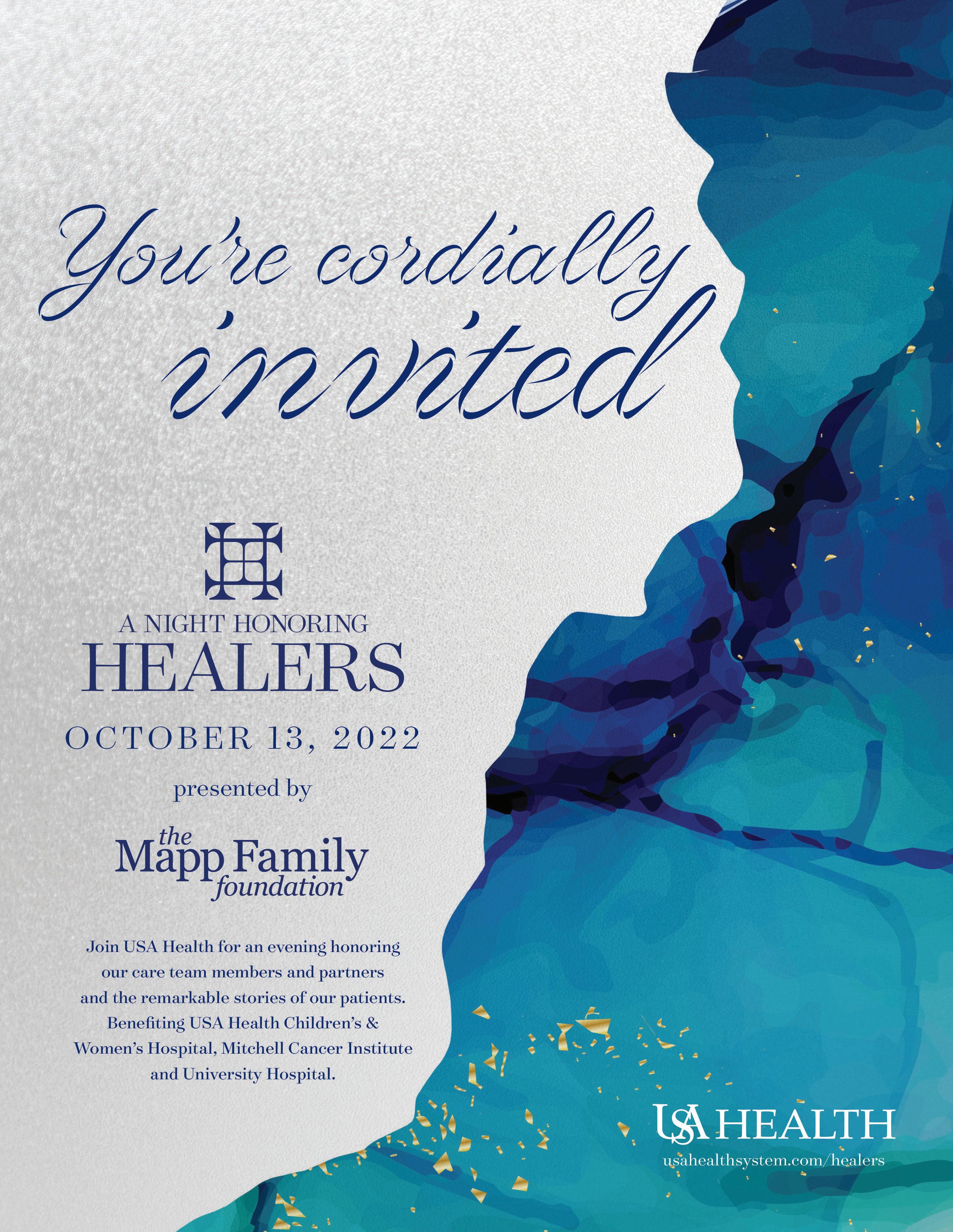
USA Health Faces
Scaturro named administrator for University Hospital
USA Health named Shannon Scaturro, M.S.H.A., M.S.N., hospital administrator for University Hospital and assistant vice president for medical affairs.
“University Hospital has world-class physicians, nurses and associates, and I am privileged to support them and extend the impact USA Health is making in the region,” Scaturro said.
In addition to overseeing the daily oper ations at University Hospital, Scaturro is responsible for working with physician and health system leadership in the develop ment of new, strategic healthcare offerings that meet the needs of patients, as well as adding to the educational and research missions of USA Health.
Prior to joining USA Health, Scaturro was the vice president of operations for As cension St. Vincent’s Birmingham, where he was responsible for all procedural, ancil lary and support services. He also served as the co-chair for the surgery and oncology services lines for the St. Vincent’s/UAB Health System Alliance.

Before moving to Birmingham, Scaturro spent nine years at Providence Hospital in Mobile, rising to become the vice presi dent of operations and surgical services while continuing to work as a certified registered nurse anesthetist. He served as the president of the Alabama Association of Nurse Anesthetists after six years with United Anesthesia Resources, a company he owned and founded.
He earned a bachelor’s degree in nursing at USA and a master’s degree in nursing with an anesthesia concentration at the University of Tennessee. He later received a Master of Science in Healthcare Admin istration from the University of Alabama at Birmingham.
Petty selected as associate chief medical officer for pediatrics
Melody Petty, M.D., M.P.H., a pediatric hospitalist at Children’s & Women’s Hospi tal, was appointed USA Health’s associate chief medical officer for pediatrics.
In this newly created role, Petty works alongside Michael Chang, M.D., chief medi
cal officer, and Ara Travers, M.D., associate chief medical officer and medical director of care management, to optimize quality, safety, efficiency and patient-centeredness across the scope of care for children.
“I’m excited to take on this new chal lenge and see this as a way to help with pediatric-specific issues in our health system,” Petty said. “This is a positive way to further our mission to provide the best patient care possible.”
Petty said she’s looking forward to ex panding communication efforts between pediatrics and other service lines within USA Health. “This will be a way to give them real-time news about changes going on within our health system as we further develop other quality initiatives and imple ment strategic plans,” she said.
In 2020, Petty was selected as Alabama’s advocate for the prevention of childhood use of nicotine products such as e-cigarettes. Since then, she’s led local and state advocacy and educational initia tives through a variety of meetings, media appearances and the development of videos aimed at educating youth about the dangers of vaping.
An assistant professor of pediatrics at the Frederick P. Whiddon College of Medicine, Petty is double board-certified by the American Academy of Pediatrics in pediatrics and pediatric hospital medicine.
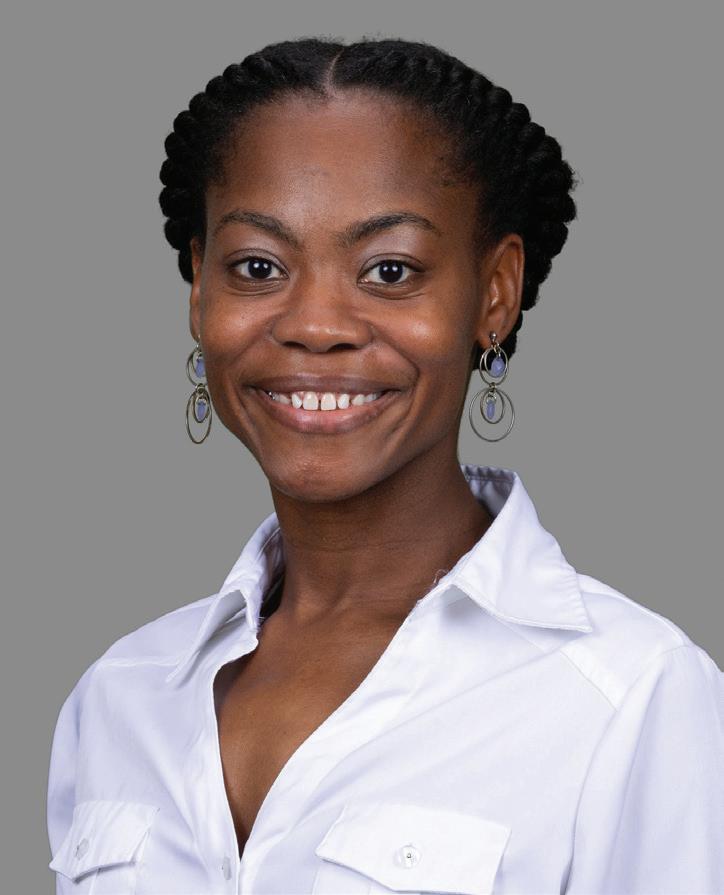
Petty earned a medical degree from the University of Mississippi School of Medicine. She completed a residency in pediatrics at USA Health, where she was recognized as the Residency Core Curricu lum Scholar.
Parcha named medical director of progressive care unit at University Hospital
Siva Parcha, M.D., a hospitalist/internal medicine physician with USA Health, was named medical director of the progressive care unit at USA Health University Hospi tal. In this capacity, he partners with nurs ing staff and the primary care providers of patients in the PCU to optimize high-quality, patient-centered care.
The progressive care unit provides a level of care to patients who are not sick enough for the intensive care unit but not well enough to move to a regular hospital floor.
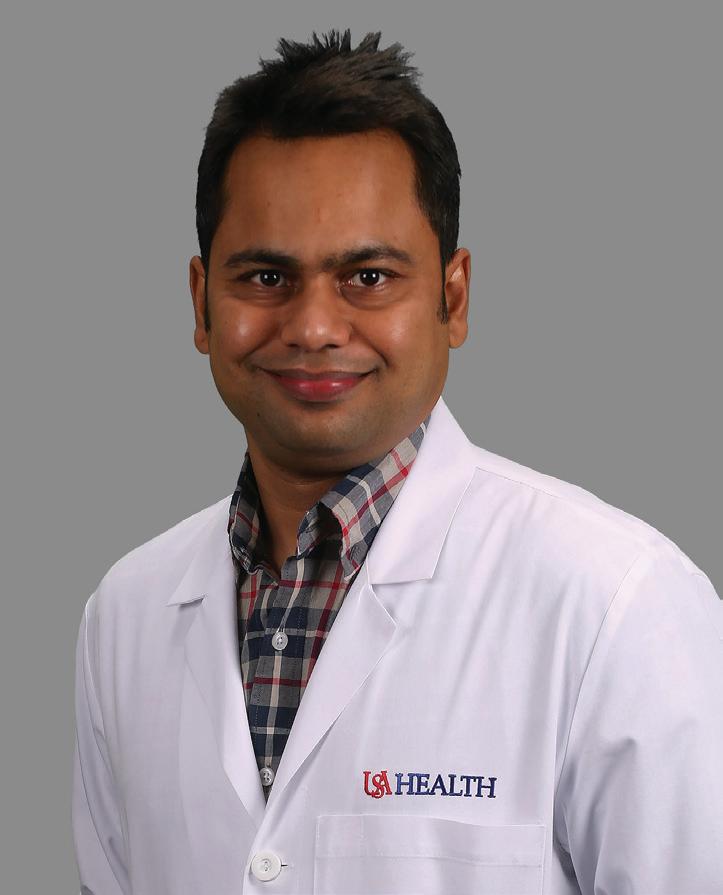
USA HEALTH MAGAZINE | VOL. 4, ISSUE 2 | 43
Melody Petty, M.D., M.P.H.
Siva Parcha, M.D.
Shannon Scaturro, M.S.H.A., M.SN.
“My main aim is to make the PCU a stepdown unit rather than a step up and pro vide the best possible care for our patients,” said Parcha, who joined USA Health in 2019. “With proper utilization of PCU, the current data available shows that we can improve rates of hospital-acquired condi tions and minimize codes. It also minimiz es the bounce-back of patients between the ICU and medical-surgical floors.”
Parcha, an assistant professor of internal medicine at the Whiddon College of Medi cine, will continue his role as a hospitalist, a physician who cares for hospitalized patients.
He has worked as a hospitalist for the past seven years at facilities throughout the United States and said he understands the importance of having a well-managed PCU, he said. He looks forward to combin ing his perspective as a hospitalist with his administrative role as medical director of the PCU.
Parcha received his medical degree from Osmania Medical College in Hyderabad, India. He completed residency training in internal medicine at Texas Tech University Health Science Center at Permian Basin.
Parker appointed chair of the department of psychiatry
Sandra Parker, M.D., chief medical officer for AltaPointe Health, was named chair of the department of psychiatry at the Whid don College of Medicine.
Parker served as vice chair and associate
professor of the department from January 2009 until July 2021. Ronald Franks, M.D., the former chair, retired after a career that spanned more than 40 years. Prior to 2009, Parker served in various faculty and adjunct faculty positions at the Whiddon College of Medicine beginning in 2001.
Parker attended medical school and completed residency training in psychia try at the University of Alabama School of Medicine in Birmingham. She completed a fellowship in child/adolescent psychiatry at the University of Arkansas for the Health Sciences in Little Rock.
She has received numerous honors and awards. Parker is president of the Alabama Psychiatric Physicians Association and past president of the Mobile Bay Psychiat ric Association. In 2017, she received the Martha Myers Role Model Award given by the University of Alabama Medical Alumni Association. In 2015, she was recognized as an Inspirational Physician Honoree of the American Medical Association, Women’s Physician Section. For her work in co ordinating care for victims of Hurricane Katrina and the BP oil spill, she was the 2012 recipient of the Bruno Lima Award, an honor given by the American Psychiat ric Association to recognize outstanding efforts of members who contribute to the care and understanding of victims of disasters.

Three times – in 2015, 2016 and 2018 –USA medical students awarded Parker the Red Sash Award, which is given to faculty members who students say have had the
Achievements
USA Health represented in Mobile Bay Magazine’s
40 Under 40
Five USA Health faculty and staff mem bers were named to Mobile Bay Magazine’s Class of 2022 40 Under 40. The publication selects 40 individuals under the age of 40 who demonstrate leadership, professional excellence and a commitment to the Mo bile Bay area.
Omar Alkharabsheh, M.D., is an assis tant professor of interdisciplinary clinical oncology and a medical oncologist and he matologist at the Mitchell Cancer Institute. He received his medical degree from Jordan University of Science and Technology-
Faculty of Medicine in Irbid, Jordan. He completed a hematology and medical oncology fellowship at Michigan State University College of Human Medicine in East Lansing, Michigan. He also completed an advanced hematology fellowship (leu kemia track) at the Mayo Clinic School of Graduate Medical Education in Rochester, Minnesota. He is the principal investigator for four open clinical trials at the MCI.
Chad Collins, M.H.A., is the director of operations for the gastroenterology service line at USA Health. He is the recipient of the 2021 Alabama Early Careerist Re gent’s Award from the American College of Healthcare Executives of Alabama and
most meaningful impact on their medical education.
“It’s an honor to transition into this new role with the Whiddon College of Medi cine,” Parker said. “Through collaboration with AltaPointe Health, our faculty remains committed to providing outstanding clinical care to our patients and a superior education to our psychiatry residents and students.”
Dual certified by the American Board of Psychiatry and Neurology in adult psy chiatry and child/adolescent psychiatry, Parker’s major psychiatric interests are in the fields of autism-related disorders, healthcare disparities and tele-psychiatry.
was recognized nationally as one of 75 Black healthcare leaders to know in 2022 by Becker’s Hospital Review. Collins earned a bachelor’s degree in psychology from Faulkner University and a master’s degree in healthcare administration from Louisi ana State University Shreveport. Outside of work, Collins serves his community as a board member for the Dream Foundation, Whale of Hope Inc., and Salty Kidz. He served for eight years in the U.S. Army.
Sarah Kahalley, M.S.H.A., is the director of clinical resources for USA Health Phy sicians Group. She received her bachelor’s degree in nursing from the University of South Alabama and a master’s degree in
44 | USA HEALTH MAGAZINE | VOL. 4, ISSUE2
Sandra Parker, M.D.
healthcare administration from the Univer sity of Alabama at Birmingham. When the pandemic started, she helped develop the COVID-19 testing center at Ladd-Peebles Stadium and the Mobile Civic Center and directed efforts for the team that admin istered more than 100,000 doses of the COVID-19 vaccine since December 2020.
Daniel McMahon, M.D., is an assistant professor of surgery at the Frederick P. Whiddon College of Medicine and a gen eral surgeon with USA Health. He received his medical degree from the University of Alabama School of Medicine in Birming ham and completed his general surgery residency at the Naval Medical Center in Portsmouth, Virginia. The author of two books, he served as a flight surgeon in the Medical Corps of the U.S. Navy, where he was selected as a commander in 2019.
Patricia Powe, C.P.A., is a business manager at the Whiddon College of Medicine. She received her bachelor’s and master’s degrees from the University of Alabama. She served as the 2021 South Fund Campaign representative for finance and administration at the university, and is treasurer and a board member of Beckwith. She serves St. Paul’s Episcopal Church as a member of the vestry, Sunday school teacher, acolyte adviser, confirmation men tor, lay Eucharist minister and lector.
Scalici earns 2021 Mayer Mitchell Award for Excellence in Cancer Research
Physician-scientist Jennifer M. Scalici, M.D., is the recipient of the 2021 Mayer Mitchell Award for Excellence in Cancer Research.
Scalici, chief of gynecologic oncology service at the Mitchell Cancer Institute and a professor of gynecologic oncology at the Whiddon College of Medicine, directs MCI’s gynecologic oncology research.

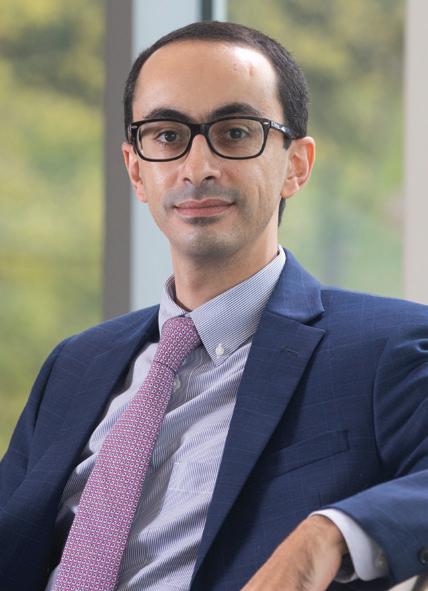
Since joining the MCI in 2012, Scalici has

Above: Jennifer M. Scalici, M.D., second from right, receives the Mayer Mitchell Award for Excellence in Cancer Research, A physician-scientist, Scalici serves as chief of gynecologic oncology service at the Mitchell Cancer Institute.
focused her collaborative research on ovar ian cancer carcinogenesis and chemo-pre vention as well as the active DNA damage and repair mechanisms, and metabolic changes underlying gynecologic cancers.
Supported by grant funding from the U.S. Department of Defense, including a recent $450,000 award, she has led collaborations with Auburn University and the University of Virginia as she continues to examine the effectiveness of a novel compound, devel oped in-house at the MCI, for the preven tion of ovarian cancer. Scalici also serves on numerous national committees focused on advancing the treatment of gynecologic cancers.
In addition, Scalici has built a clinical practice emphasizing evidence-based care and advanced surgical techniques for gy necologic malignancies. She served as site principal investigator for a clinical trial that brought fluorescent sentinel lymph node dissection in endometrial cancer to Mobile, a technique that has become integrated into the standard of care nationally.
“As a physician-scientist, Dr. Scalici fully understands the plight of women who are

suffering from gynecologic cancers. She brings that unique understanding to the re search lab, where she and her team contin ue to lead promising projects,” said John V. Marymont, M.D., M.B.A., vice president for medical affairs and dean of the Whiddon College of Medicine. “She is very deserving of this honor.”
Scalici earned her medical degree from the University of Alabama at Birmingham. She completed a residency in obstetrics and gynecology at Northwestern University McGraw Medical Center in Chicago and a fellowship in gynecologic oncology at the University of Virginia Health System in Charlottesville.

The $10,000 award is presented annually to a promising scientist at the Mitchell Cancer Institute upon the recommenda tion of a faculty committee. The award was established in 2009 by University of South Alabama trustee Arlene Mitchell in mem ory of her late husband, Mayer Mitchell, a Mobile businessman, longtime USA trustee and formative figure in the establishment of the MCI.
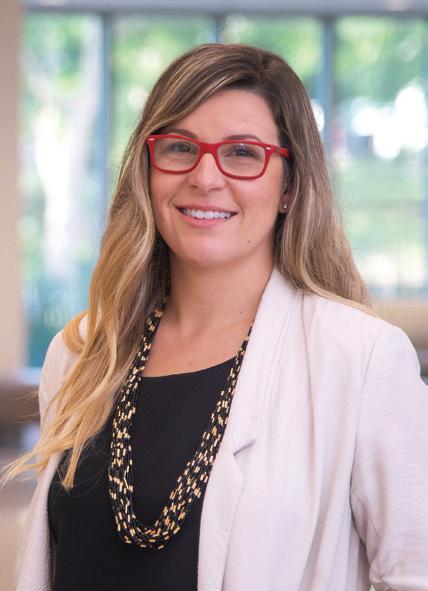
USA HEALTH MAGAZINE | VOL. 4, ISSUE 2 | 45
Top: Omar Alkharabsheh, M.D.; Chad; Collins, M.H.A.; Sarah Kahalley, M.S.H.A.; Daniel McMahon, M.D.; Patricia Powe, C.P.A., were named to Mobile Bay’s 40 Under 40.
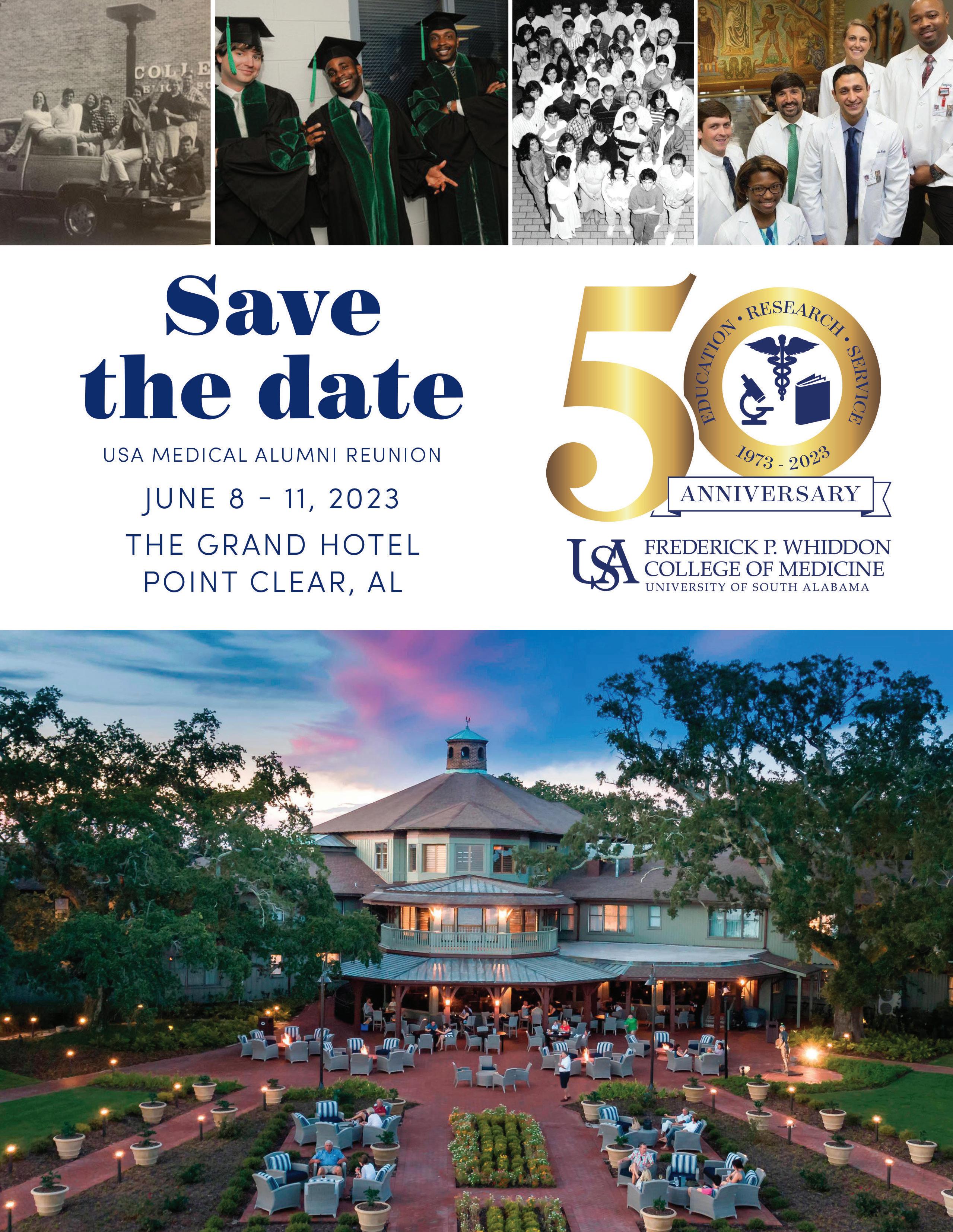
Academic medicine = advanced healthcare
We’re an academic health system. With you in mind, we push forward with innovative thinking and collaboration between specialties to deliver you the absolute best healthcare in the region.


usahealthsystem.com
Non-Profit

2451 University Hospital Drive Mobile, AL 36617
U.S. POSTAGE PAID Mobile, AL Permit No. 506
Leon Campbell, M.D., left, of the Class of 1986, wins the croquet tournament at the 2022 USA Medical Alumni Reunion.



























































 BY CAROL MCPHAIL
BY CAROL MCPHAIL
 BY SHELBEY ERNEST
BY SHELBEY ERNEST
















































